
First, addressing a little on the psychology behind religious belief?
“According to a psychologist, Steven Reiss, a professor of psychology at The Ohio State University, who has studied human motivation for more than 20 years suggests Religion, attracts followers because it satisfies all of the 16 basic desires that humans share. And that all religious beliefs and practices are designed to meet one or more of these 16 desires. Moreover, while all people need to fulfill the same basic desires, not everyone will turn to religion to satisfy them and secular society offers alternatives to fulfill all of the basic desires. Thus religion competes with secular society to meet those 16 needs and can gain or lose popularity based on how well people believe it does compared to secular society.” ref
“Damien, do you think religion is an evolutionary adaptation?” – Questioner
My response, No, it is just a cultural product like tool technology or language. We create tools based on believed needs.
“Damien, how can you advocate science and anti-theism at the same time without being logically inconsistent? Science proves religion is part of our human psychology. How do you rid the world of our human psychology?” – Challenger
My response, Selfish and antisocial behavior can be part of our psychology and addiction as well. We are not perfect beings and thus we do need to improve on what we start with. You are also wrong as to what anti-theism means. I see Theism as harmful. Anti-theism sees theism as harmful to the believer, harmful to society, harmful to politics, harmful, to culture, etc. And, theism is a promoter of pseudoscience, pseudohistory, and pseudomorality. It is more than a lie, Theism is anti-humanism.
I quest for intellectual, emotional, and social honesty, as main goals I wish to live in and grow from, may I be a good human.
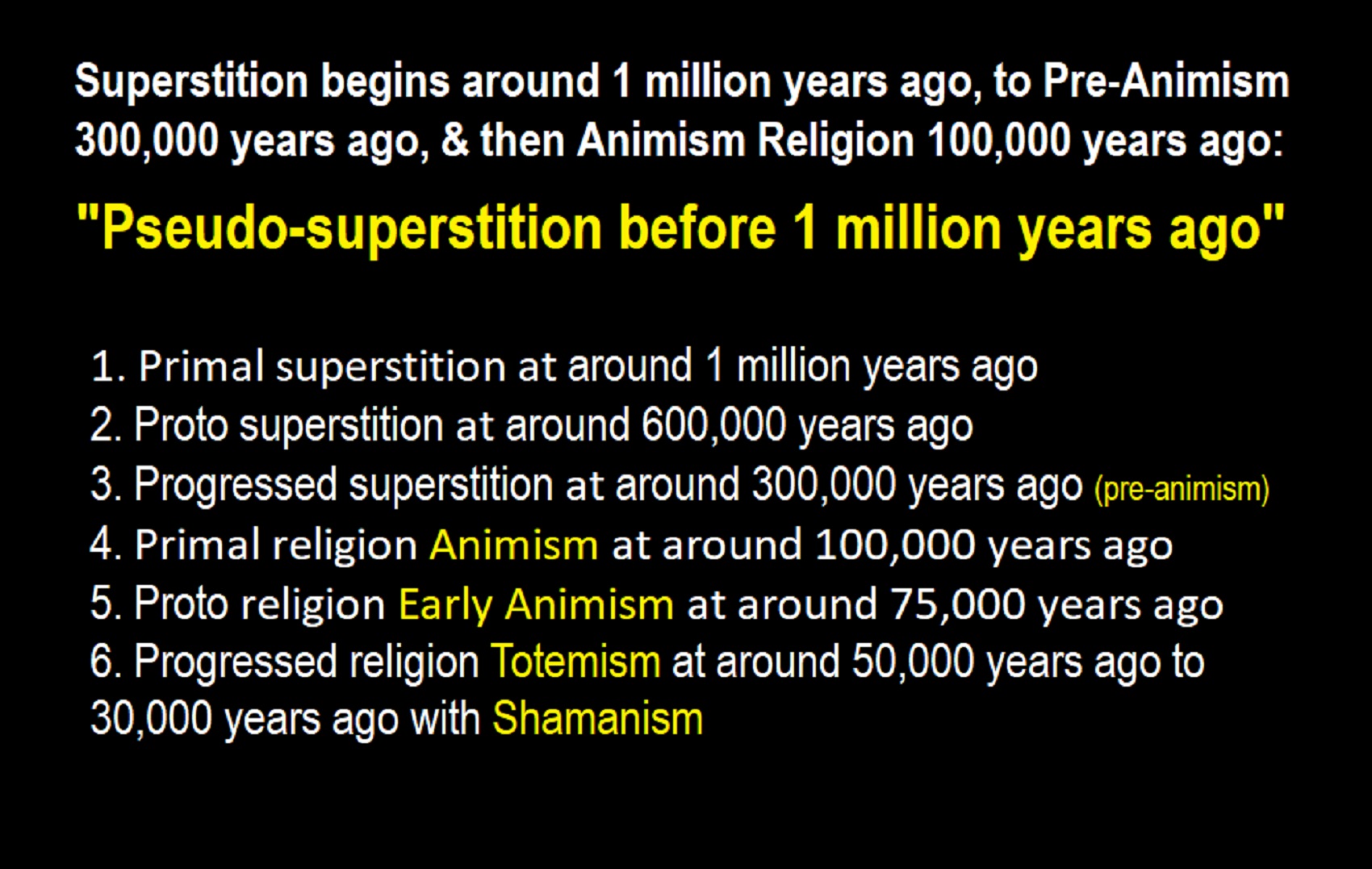
I would first like to point out that there seems to be some scant possible hinting of the earliest pseudo-superstition before 1 million years ago and possibly back to 2 million years ago.
Yet likely this is not truly full superstitionism and defiantly not religion, but there are still elements there that are forming that will further religions’ future evolution.
Superstition begins around 1 million years ago, to Pre-Animism 300,000 years ago, & then Animism Religion 100,000 years ago:
“Pseudo-superstition before 1 million years ago“
1. Primal superstition at around 1 million years ago
2. Proto superstition at around 600,000 years ago
3. Progressed superstition at around 300,000 years ago (pre-animism)
4. Primal religion Animism at around 100,000 years ago
5. Proto religion Early Animism at around 75,000 years ago
6. Progressed religion Totemism at around 50,000 years ago to 30,000 years ago with Shamanism
This pseudo-superstition starts with symbolic, superstition, or early sacralized behaviors seen mostly in tools that may have been possibly exhibited even if only in the most limited ways at start to further standardize around 1 million years ago with primal superstition. Then the development of religion evolution increased around 600,000 years ago with proto superstition and then even to a greater extent around 300,000 years ago with progressed superstition. Religions’ evolution moves from the loose growing of superstitionism to a greater developed thought addiction that was used to manage fear and the desire to sway control over a dangerous world. This began to happen around 100,000 years ago with primal religion. next the proto religion stage is around 75,000 years ago or less, the progressed religion stage is around 50,000 years ago to 30,000 years ago and finally after around 13, 500 years ago, begins with the evolution of more organized religion.
The set of stages for the development of organized religion is subdivided into the following: the primal stage of organized religion is around 12,000 years ago with paganism with the emergence of goddesses. The proto organized religion stage of paganism is around 10,000 years ago spreading out to other areas and adapting and developing, and finally the progressed organized religion stage of paganism is around 7,000 years ago involving the emergence of male gods with limited mythology to 5,000 years ago with the emergence of religious nation-states as well as the forming of full mythology and its connected set of Dogmatic-Propaganda strains of sacralized superstitionism.
Superstitionism is the Mother of Supernaturalism, thus Religion is its child.
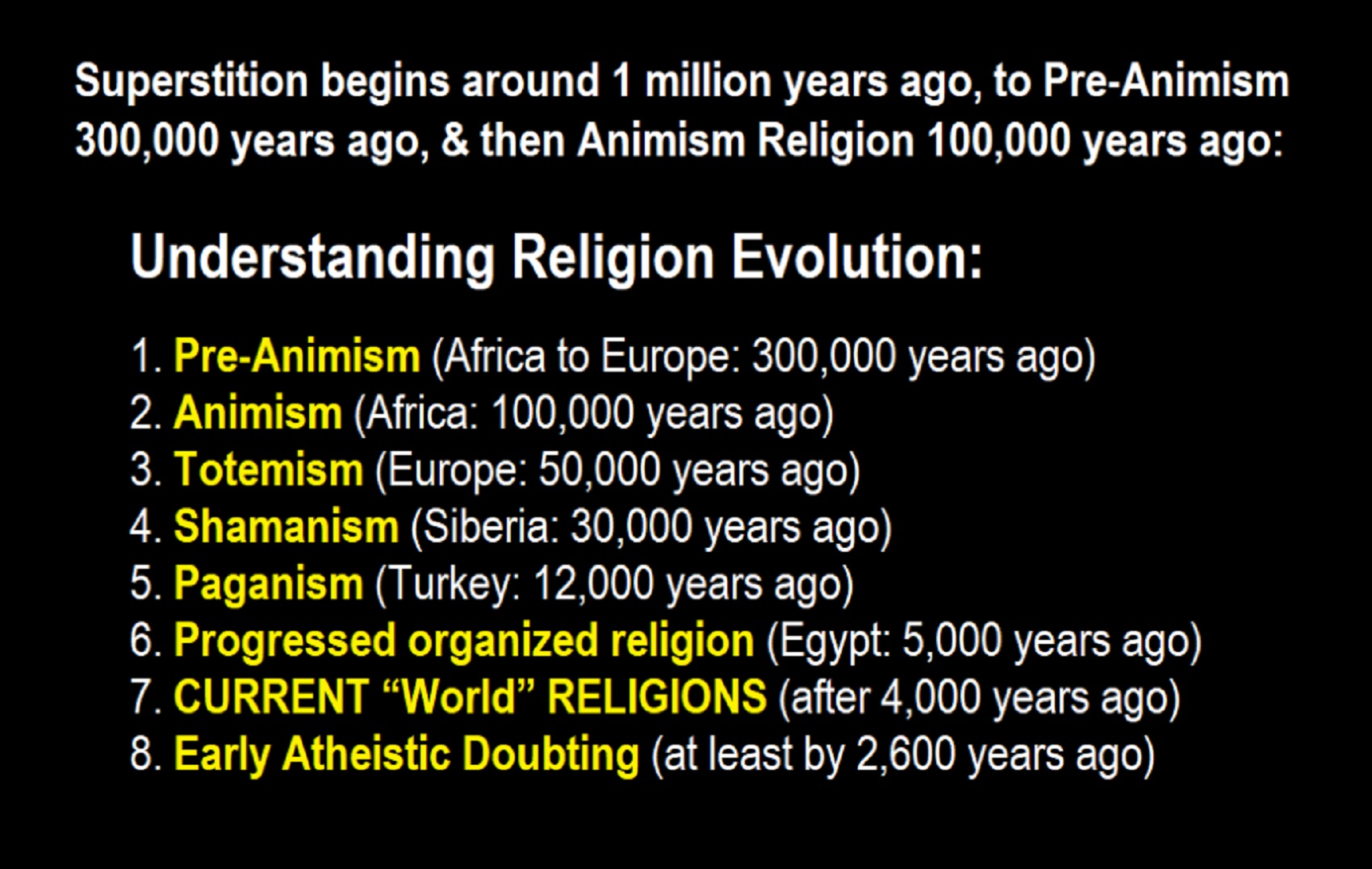
Aron Ra interviewing me on my “Archaeological/Anthropological Understanding of Religion Evolution”
Pre-Animism (at least 300,000 years ago)
Around a million years ago, I surmise that Pre-Animism, “animistic superstitionism”, began, Around 400,000 Years ago shows Sociocultural Evolution, and then led to the animistic somethingism or animistic supernaturalism, which is at least 300,000 years old and about 100,00 years ago, it evolves to a representation of general Animism, which is present in today’s religions. There is also Homo Naledi and an Intentional Cemetery “Pre-Animism” dating to around 250,000 years ago. And, Neanderthals “Primal Religion (Pre-Animism/Animism?)” Mystery Cave Rings 175,000 Years Ago. Neanderthals were the first humans to intentionally bury the dead, around 130,000 years ago at sites such as Krapina in Croatia.
Pre-animism ideas can be seen in rock art such as that expressed in portable anthropomorphic art, which may be related to some kind of ancestor veneration. This magical thinking may stem from a social or non-religious function of ancestor veneration, which cultivates kinship values such as filial piety, family loyalty, and continuity of the family lineage. Ancestor veneration occurs in societies with every degree of social, political, and technological complexity and it remains an important component of various religious practices in modern times.
Humans are not the only species, which bury their dead. The practice has been observed in chimpanzees, elephants, and possibly dogs. Intentional burial, particularly with grave goods, signify a “concern for the dead” and Neanderthals were the first human species to practice burial behavior and intentionally bury their dead, doing so in shallow graves along with stone tools and animal bones. Exemplary sites include Shanidar in Iraq, Kebara Cave in Israel and Krapina in Croatia. The earliest undisputed human burial dates back 100,000 years ago with remains stained with red ochre, which show ritual intentionality similar to the Neanderthals before them. ref, ref
Animism (such as that seen in Africa: 100,000 years ago)
Did Neanderthals teach us “Primal Religion (Pre-Animism/Animism?)” 120,000 Years Ago? Homo sapiens – is known to have reached the Levant between 120,000 and 90,000 years ago, but that exit from Africa evidently went extinct. 100,000 years ago, in Qafzeh, Israel, the oldest intentional burial had 15 African individuals covered in red ocher was from a group who visited and returned back to Africa. 100,000 to 74,000 years ago, at Border Cave in Africa, an intentional burial of an infant with red ochre and a shell ornament, which may have possible connections to the Africans buried in Qafzeh.
Animism is approximately a 100,000-year-old belief system and believe in spirit-filled life and/or afterlife. If you believe like this, regardless of your faith, you are a hidden animist.
The following is evidence of Animism: 100,000 years ago, in Qafzeh, Israel, the oldest intentional burial had 15 African individuals covered in red ocher was from a group who visited and returned back to Africa. 100,000 to 74,000 years ago, at Border Cave in Africa, an intentional burial of an infant with red ochre and a shell ornament, which may have possible connections to the Africans buried in Qafzeh, Israel. 120,000 years ago, did Neanderthals teach us Primal Religion (Pre-Animism/Animism) as they too used red ocher and burials? ref, ref
It seems to me, it may be the Neanderthals who may have transmitted a “Primal Religion (Animism)” or at least burial and thoughts of an afterlife. The Neanderthals seem to express what could be perceived as a Primal “type of” Religion, which could have come first and is supported in how 250,000 years ago, the Neanderthals used red ochre and 230,000 years ago shows evidence of Neanderthal burial with grave goods and possibly a belief in the afterlife. ref
Do you think it is crazy that the Neanderthals may have transmitted a “Primal Religion”? Consider this, it appears that 175,000 years ago, the Neanderthals built mysterious underground circles with broken off stalactites. This evidence suggests that the Neanderthals were the first humans to intentionally bury the dead, doing so in shallow graves along with stone tools and animal bones. Exemplary sites include Shanidar in Iraq, Kebara Cave in Israel and Krapina in Croatia. Other evidence may suggest the Neanderthals had it transmitted to them by Homo heidelbergensis, 350,000 years ago, by their earliest burial in a shaft pit grave in a cave that had a pink stone axe on the top of 27 Homo heidelbergensis individuals and 250,000 years ago, Homo naledi had an intentional cemetery in South Africa cave. ref, ref, ref, ref, ref
Totemism (Europe: 50,000 years ago)
Did Neanderthals Help Inspire Totemism? Because there is Art Dating to Around 65,000 Years Ago in Spain? Totemism as seen in Europe: 50,000 years ago, mainly the Aurignacian culture. Pre-Aurignacian “Châtelperronian” (Western Europe, mainly Spain and France, possible transitional/cultural diffusion between Neanderthals and Humans around 50,000-40,000 years ago). Archaic–Aurignacian/Proto-Aurignacian Humans (Europe around 46,000-35,000). And Aurignacian “classical/early to late” Humans (Europe and other areas around 38,000 – 26,000 years ago).
Totemism is approximately a 50,000-year-old belief system and believe in spirit-filled life and/or afterlife that can be attached to or be expressed in things or objects. If you believe like this, regardless of your faith, you are a hidden totemist.
Toetmism may be older as there is evidence of what looks like a Stone Snake in South Africa, which may be the “first human worship” dating to around 70,000 years ago. Many archaeologists propose that societies from 70,000 to 50,000 years ago such as that of the Neanderthals may also have practiced the earliest form of totemism or animal worship in addition to their presumably religious burial of the dead. Did Neanderthals help inspire Totemism? There is Neanderthals art dating to around 65,000 years ago in Spain. ref, ref
Shamanism (beginning around 30,000 years ago)
Shamanism (such as that seen in Siberia Gravettian culture: 30,000 years ago). Gravettian culture (34,000–24,000 years ago; Western Gravettian, mainly France, Spain, and Britain, as well as Eastern Gravettian in Central Europe and Russia. The eastern Gravettians, which include the Pavlovian culture). And, the Pavlovian culture (31,000 – 25,000 years ago such as in Austria and Poland). 31,000 – 20,000 years ago Oldest Shaman was Female, Buried with the Oldest Portrait Carving.
Shamanism is approximately a 30,000-year-old belief system and believe in spirit-filled life and/or afterlife that can be attached to or be expressed in things or objects and these objects can be used by special persons or in special rituals that can connect to spirit-filled life and/or afterlife. If you believe like this, regardless of your faith, you are a hidden shamanist.
Around 29,000 to 25,000 years ago in Dolní Vestonice, Czech Republic, the oldest human face representation is a carved ivory female head that was found nearby a female burial and belong to the Pavlovian culture, a variant of the Gravettian culture. The left side of the figure’s face was a distorted image and is believed to be a portrait of an elder female, who was around 40 years old. She was ritualistically placed beneath a pair of mammoth scapulae, one leaning against the other. Surprisingly, the left side of the skull was disfigured in the same manner as the aforementioned carved ivory figure, indicating that the figure was an intentional depiction of this specific individual. The bones and the earth surrounding the body contained traces of red ocher, a flint spearhead had been placed near the skull, and one hand held the body of a fox. This evidence suggests that this was the burial site of a shaman. This is the oldest site not only of ceramic figurines and artistic portraiture but also of evidence of early female shamans. Before 5,500 years ago, women were much more prominent in religion.
Archaeologists usually describe two regional variants: the western Gravettian, known namely from cave sites in France, Spain, and Britain, and the eastern Gravettian in Central Europe and Russia. The eastern Gravettians include the Pavlovian culture, which were specialized mammoth hunters and whose remains are usually found not in caves but in open air sites. The origins of the Gravettian people are not clear, they seem to appear simultaneously all over Europe. Though they carried distinct genetic signatures, the Gravettians and Aurignacians before them were descended from the same ancient founder population. According to genetic data, 37,000 years ago, all Europeans can be traced back to a single ‘founding population’ that made it through the last ice age. Furthermore, the so-called founding fathers were part of the Aurignacian culture, which was displaced by another group of early humans members of the Gravettian culture. Between 37,000 years ago and 14,000 years ago, different groups of Europeans were descended from a single founder population. To a greater extent than their Aurignacianpredecessors, they are known for their Venus figurines. ref, ref, ref, ref, ref, ref, ref, ref, ref, ref, & ref
Paganism (beginning around 12,000 years ago)
Paganism (such as that seen in Turkey: 12,000 years ago). Gobekli Tepe: “first human-made temple” around 12,000 years ago. Sedentism and the Creation of goddesses around 12,000 years ago as well as male gods after 7,000 years ago. Pagan-Shaman burial in Israel 12,000 years ago and 12,000 – 10,000 years old Paganistic-Shamanistic Art in a Remote Cave in Egypt. Skull Cult around 11,500 to 8,400 Years Ago and Catal Huyuk “first religious designed city” around 10,000 years ago.
Paganism is approximately a 12,000-year-old belief system and believe in spirit-filled life and/or afterlife that can be attached to or be expressed in things or objects and these objects can be used by special persons or in special rituals that can connect to spirit-filled life and/or afterlife and who are guided/supported by a goddess/god, goddesses/gods, magical beings, or supreme spirits. If you believe like this, regardless of your faith, you are a hidden paganist.
Around 12,000 years ago, in Turkey, the first evidence of paganism is Gobekli Tepe: “first human-made temple” and around 9,500 years ago, in Turkey, the second evidence of paganism is Catal Huyuk “first religious designed city”. In addition, early paganism is connected to Proto-Indo-European language and religion. Proto-Indo-European religion can be reconstructed with confidence that the gods and goddesses, myths, festivals, and form of rituals with invocations, prayers, and songs of praise make up the spoken element of religion. Much of this activity is connected to the natural and agricultural year or at least those are the easiest elements to reconstruct because nature does not change and because farmers are the most conservative members of society and are best able to keep the old ways.
The reconstruction of goddesses/gods characteristics may be different than what we think of and only evolved later to the characteristics we know of today. One such characteristic is how a deity’s gender may not be fixed, since they are often deified forces of nature, which tend to not have genders. There are at least 40 deities and the Goddesses that have been reconstructed are: *Pria, *Pleto, *Devi, *Perkunos, *Aeusos, and *Yama.
The reconstruction of myths can be connected to Proto-Indo-European culture/language and by additional research, many of these myths have since been confirmed including some areas that were not accessible to the early writers such as Latvian folk songs and Hittite hieroglyphic tablets. There are at least 28 myths and one of the most widely recognized myths of the Indo-Europeans is the myth, “Yama is killed by his brother Manu” and “the world is made from his body”. Some of the forms of this myth in various Indo-European languages are about the Creation Myth of the Indo-Europeans.
The reconstruction of rituals can be connected to Proto-Indo-European culture/language and is estimated to have been spoken as a single language from around 6,500 years ago. One of the earliest ritual is the construction of kurgans or mound graves as a part of a death ritual. kurgans were inspired by common ritual-mythological ideas. Kurgans are complex structures with internal chambers. Within the burial chamber at the heart of the kurgan, elite individuals were buried with grave goods and sacrificial offerings, sometimes including horses and chariots.
The speakers of Pre-Proto-Indo-European lived in Turkey and it associates the distribution of historical Indo-European languages with the expansion around 9,000 years ago, with a proposed homeland of Proto-Indo-European proper in the Balkans around 7,000 years ago. The Proto-Indo-European Religion seemingly stretches at least back around 6,000 years ago or likely much further back and I believe Paganism is possibly an approximately 12,000-year-old belief system.
The earliest kurgans date to 6,000 years ago and are connected to the Proto-Indo-European in the Caucasus. In fact, around 7,000 years ago, there appears to be pre-kurgan in Siberia. Around 7,000 to 2,500 years ago and beyond, kurgans were built with ancient traditions still active in Southern Siberia and Central Asia, which display the continuity of the archaic forming methods. Kurgan cultures are divided archaeologically into different sub-cultures such as Timber Grave, Pit Grave, Scythian, Sarmatian, Hunnish, and Kuman–Kipchak. Kurgans have been found from the Altay Mountains to the Caucasus, Ukraine, Romania, and Bulgaria. Around 5,000 years ago, kurgans were used in the Ukrainian and Russian flat unforested grasslands and their use spread with migration into eastern, central, northern Europe, Turkey, and beyond. ref, ref, ref, ref, ref, ref, ref, ref, ref, ref, ref, ref, & ref
Progressed organized religion (around 5,000 years ago)
Progressed organized religion (such as that seen in Egypt: 5,000 years ago “The First Dynasty dates to 5,150 years ago”). This was a time of astonishing religion development and organization with a new state power to control. Around the time of 5,000 to 4,000 years ago, saw the growth of these riches, both intellectually and physically, became a source of contention on a political stage, and rulers sought the accumulation of more wealth and more power.
*The First Dynasty* Date: 3,150 B.C.E. (5,150 years ago)
The Beginning Rise of the Unequal State Government Hierarchies, Religions and Cultures Merger
The Pharaoh in ancient Egypt was the political and religious leader holding the titles ‘Lord of the Two Lands’ Upper and Lower Egypt and ‘High Priest of Every Temple’. In 5,150 years ago the First Dynasty appeared in Egypt and this reign was thought to be in accordance with the will of the
Around 4,890 years ago during the Second Dynasty, the King was linked with the divine and reign with the will of the gods. Following this, rulers of the later dynasties were equated with the gods and with the duties and obligations due to those gods. As supreme ruler of the people, the pharaoh was considered a god on earth, the intermediary between the gods and the people, and when he died, he was thought to become Osiris, the god of the dead. As such, in his role of ‘High Priest of Every Temple’, it was the pharaoh’s duty to build great temples and monuments celebrating his own achievements and paying homage to the gods of the land.
Among the earliest civilizations that exhibit the phenomenon of divinized kings are early Mesopotamia and ancient Egypt.
In 5,150 years ago the First Dynasty appeared in Egypt with the unification of Upper and Lower Egypt by the king Menes (now believed to be Narmer). Menes/Narmer is depicted on inscriptions wearing the two crowns of Egypt, signifying unification, and his reign was thought to be in accordance with the will of the gods; but the office of the king itself was not associated with the divine until later. During the Second Dynasty of Egypt 4,890-4,670 years ago King Raneb (also known as Nebra) linked his name with the divine and his reign with the will of the gods. Following Raneb, the rulers of the later dynasties were equated with the gods and with the duties and obligations due to those gods. As supreme ruler of the people, the pharaoh was considered a god on earth. The honorific title of `pharaoh’ for a ruler did not appear until the period known as the New Kingdom 3,570-3,069 years ago. Monarchs of the dynasties before the title of `pharaoh’ from the New Kingdom were addressed as `your majesty’ by foreign dignitaries and members of the court and as `brother’ by foreign rulers; both practices would continue after the king of Egypt came to be known as a pharaoh. Ref, Ref
CURRENT “World” RELIGIONS (after 4,000 years ago)
Hinduism around 3,700 to 3,500 years old. Judaism around 3,450 or 3,250 years old. (The first writing in the bible was “Paleo-Hebrew” dated to around 3,000 years ago). Jainism around 2,599 – 2,527 years old. Confucianism around 2,600 – 2,551 years old. Buddhism around 2,563/2,480 – 2,483/2,400 years old. Christianity around 2,000 years old. Shinto around 1,305 years old. Islam around 1407–1385 years old. Sikhism around 548–478 years old. Bahá’í around 200–125 years old.
Early Atheistic Doubting (at least by 2,600 years ago)
Around 2,600 Years Ago, there is a confirmation of atheistic doubting as well as atheistic thinking, mainly by Greek philosophers. However, doubting gods is likely as old as the invention of gods and should destroy the thinking that belief in god(s) is the “default belief”. The Greek word is
If you are a religious believer, may I remind you that faith in the acquisition of knowledge is not a valid method worth believing
Damien Marie AtHope: Atheist-Humanist Philosopher & Pre-Historical Writer/Researcher at damien.marie.athope.com
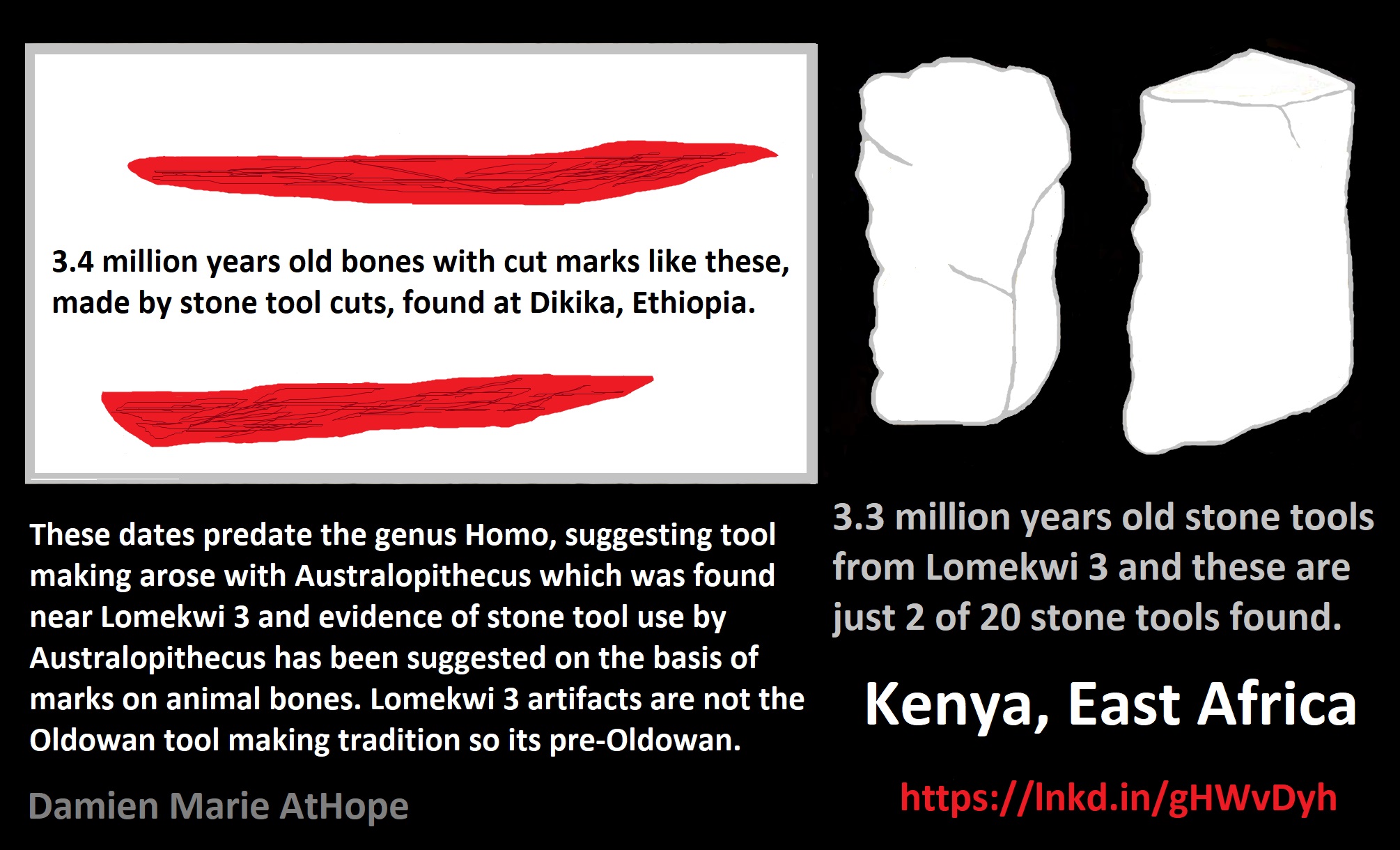
“Two parallel marks that look like cut marks on a 3.4-million-year-old bone from a buffalo-sized creature from Ethiopia in East Africa. Along with scores of crude stone tools discovered at Lomekwi 3 in Kenya are East Africa that date back 3.3 million years. And more interesting is Kenyanthropus a hominin genus identified from the Lomekwi site by Lake Turkana, Kenya, dated to 3.3 to 3.2 million years ago.” ref, ref, ref, ref, ref


Early Stone Age (Lower Paleolithic): “The Lower Paleolithic is the earliest subdivision of the Paleolithic or Old Stone Age. It spans the time from around 3 million years ago when the first evidence for stone tool production and use by hominins appears in the current archaeological record, until around 300,000 years ago, spanning the Oldowan (“mode 1”) and Acheulean (“mode 2”) lithics industries. In African archaeology, the time period roughly corresponds to the Early Stone Age, the earliest finds dating back to 3.3 million years ago, with Lomekwian stone tool technology, spanning Mode 1 stone tool technology, which begins roughly 2.6 million years ago and ends between 400,000 and 250,000 years ago, with Mode 2 technology.” ref
Middle Stone Age (Middle Paleolithic): “The Middle Paleolithic (or Middle Palaeolithic) is the second subdivision of the Paleolithic or Old Stone Age as it is understood in Europe, Africa, and Asia. The term Middle Stone Age is used as an equivalent or a synonym for the Middle Paleolithic in African archeology. The Middle Paleolithic broadly spanned from 300,000 to 30,000 years ago. There are considerable dating differences between regions. The Middle Paleolithic was succeeded by the Upper Paleolithic subdivision which first began between 50,000 and 40,000 years ago. Pettit and White date the Early Middle Paleolithic in Great Britain to about 325,000 to 180,000 years ago (late Marine Isotope Stage 9 to late Marine Isotope Stage 7), and the Late Middle Paleolithic as about 60,000 to 35,000 years ago. According to the theory of the recent African origin of modern humans, anatomically modern humans began migrating out of Africa during the Middle Stone Age/Middle Paleolithic around 125,000 years ago and began to replace earlier pre-existent Homo species such as the Neanderthals and Homo erectus.” ref
“Middle Paleolithic burials at sites such as Krapina in Croatia (dated to c. 130,000 BP) and the Qafzeh and Es Skhul caves in Israel (c. 100,000 BP) have led some anthropologists and archeologists (such as Philip Lieberman) to believe that Middle Paleolithic cultures may have possessed a developing religious ideology which included concepts such as an afterlife; other scholars suggest the bodies were buried for secular reasons. According to recent archeological findings from Homo heidelbergensis sites in the Atapuerca Mountains, the practice of intentional burial may have begun much earlier during the late Lower Paleolithic, but this theory is widely questioned in the scientific community.” ref
“The earliest undisputed evidence of artistic expression during the Paleolithic period comes from Middle Paleolithic/Middle Stone Age sites such as Blombos Cave in the form of bracelets, beads, art rock, ochre used as body paint and perhaps in ritual, though earlier examples of artistic expression such as the Venus of Tan-Tan and the patterns found on elephant bones from Bilzingsleben in Thuringia may have been produced by Acheulean tool-users such as Homo erectus prior to the start of the Middle Paleolithic period. Activities such as catching large fish and hunting large game animals with specialized tools indicate increased group-wide cooperation and more elaborate social organization. In addition to developing advanced cultural traits, humans also first began to take part in long-distance trade between groups for rare commodities (such as ochre (which was often used for religious purposes such as ritual) and raw materials during the Middle Paleolithic as early as 120,000 years ago. Inter-group trade may have appeared during the Middle Paleolithic because trade between bands would have helped ensure their survival by allowing them to exchange resources and commodities such as raw materials during times of relative scarcity (i.e., famine or drought).” ref
Later Stone Age (Upper Paleolithic): “The Upper Paleolithic (or Upper Palaeolithic) is the third and last subdivision of the Paleolithic or Old Stone Age. Very broadly, it dates to between 50,000 and 12,000 years ago (the beginning of the Holocene), according to some theories coinciding with the appearance of behavioral modernity in early modern humans, until the advent of the Neolithic Revolution and agriculture. Anatomically modern humans (i.e. Homo sapiens) are believed to have emerged in Africa around 300,000 years ago, it has been argued by some that their ways of life changed relatively little from that of archaic humans of the Middle Paleolithic, until about 50,000 years ago, when there was a marked increase in the diversity of artifacts found associated with modern human remains. This period coincides with the most common date assigned to an expansion of modern humans from Africa throughout Asia and Eurasia, which contributed to the extinction of the Neanderthals. The Upper Paleolithic has the earliest known evidence of organized settlements, in the form of campsites, some with storage pits. Artistic work blossomed, with cave paintings, petroglyphs, carvings, and engravings on bone or ivory.” ref
“The first evidence of human fishing is also found, from artifacts in places such as Blombos cave in South Africa. More complex social groupings emerged, supported by more varied and reliable food sources and specialized tool types. This probably contributed to increasing group identification or ethnicity. The peopling of Australia most likely took place before c. 60,000 years ago. Europe was peopled after c. 45,000 years ago. Anatomically modern humans are known to have expanded northward into Siberia as far as the 58th parallel by about 45 ka (Ust’-Ishim man). The Upper Paleolithic is divided by the Last Glacial Maximum (LGM), from about 25,000 to 15,000 years ago. The peopling of the Americas occurred during this time, with East and Central Asia populations reaching the Bering land bridge after about 35 ka, and expanding into the Americas by about 15,000 years ago. In Western Eurasia, the Paleolithic eases into the so-called Epipaleolithic or Mesolithic from the end of the LGM, beginning 15 ka. The Holocene glacial retreat begins 11.7,00 years ago (10th millennium BCE), falling well into the Old World Epipaleolithic, and marking the beginning of the earliest forms of farming in the Fertile Crescent.” ref

Acheulean Stone Tools
Acheulean tools date to about 1.76 million to 130,000 years ago, are typically found with Homo erectus remains and were produced during the Lower Palaeolithic era across Africa and much of West Asia, South Asia, and Europe, and are typically found with Homo erectus remains. It is thought that Acheulean technologies developed from the more primitive Oldowan technology associated with Homo habilis. ref
Homo ergaster or early Homo erectus is the likely the earliest user of Acheulean tools. It appears that Acheulean originated in Africa and spread to Asian, Middle Eastern, and European areas sometime between 1.5 million years ago and about 800 thousand years ago. Later, used by Homo heidelbergensis (the common ancestor of both Neanderthals and Homo sapiens). ref
Tool types found in Acheulean assemblages include pointed, cordate, ovate, ficron, and bout-coupé hand-axes (referring to the shapes of the final tool), cleavers, retouched flakes, scrapers, and segmental chopping tools. Materials used were determined by available local stone types; flint is most often associated with the tools but its use is concentrated in Western Europe; in Africa sedimentary and igneous rock such as mudstone and basalt were most widely used, for example. Other source materials include chalcedony, quartzite, andesite, sandstone, chert, and shale. Even relatively soft rock such as limestone could be exploited. In all cases the toolmakers worked their handaxes close to the source of their raw materials, suggesting that the Acheulean was a set of skills passed between individual groups. ref
The symmetry of the hand-axes has been used to suggest that Acheulean tool users possessed the ability to use language; the parts of the brain connected with fine control and movement are located in the same region that controls speech. The wider variety of tool types compared to earlier industries and their aesthetically as well as functionally pleasing form could indicate a higher intellectual level in Acheulean tool users than in earlier hominines. ref
Acheulean artifacts, such as the Venus of Berekhat Ram, have been used to argue for artistic expression among this Acheulean stone tool culture users. The incised elephant tibia from Bilzingsleben in Germany, and ochre finds from Kapthurin in Kenya and Duinefonteinin South Africa, are sometimes cited as being some of the earliest examples of an aesthetic sensibility in human history. There are numerous other explanations put forward for the creation of these artefacts, however; and there is no unequivocal evidence of human art until around 50,000 years ago, after the emergence of modern Homo sapiens. ref
Ethnographic study of flint-knapping populations of the Irian Jaya, demonstrated it require long-term memory, spatial or procedural cognition, advanced planning, and procedural ‘know-how’ or social cognition. Other research contends that higher order cognitive function is tied to motor action and that these processes and must be in order to make an Acheulean tool. Therefore, Homo erectus may have had an enlargement of neural areas relevant to tool-making cognitive processes. Thus, the Acheulean actually could signal both innovations in social cognition and technological creativity. ref
Acheulean culture spread throughout Europe, Africa, and Asia. It flourished around 400,000–100,000 years ago. The Homo erectus and early Homo sapiens of the Acheulean culture lived in primitive communities in caves and in the open. They were hunters and gatherers who had discovered the use of fire. Known Acheulean sites in Ukraine are the Kiik-Koba, Zhytomyr, and Luka-Vrublivetska. ref
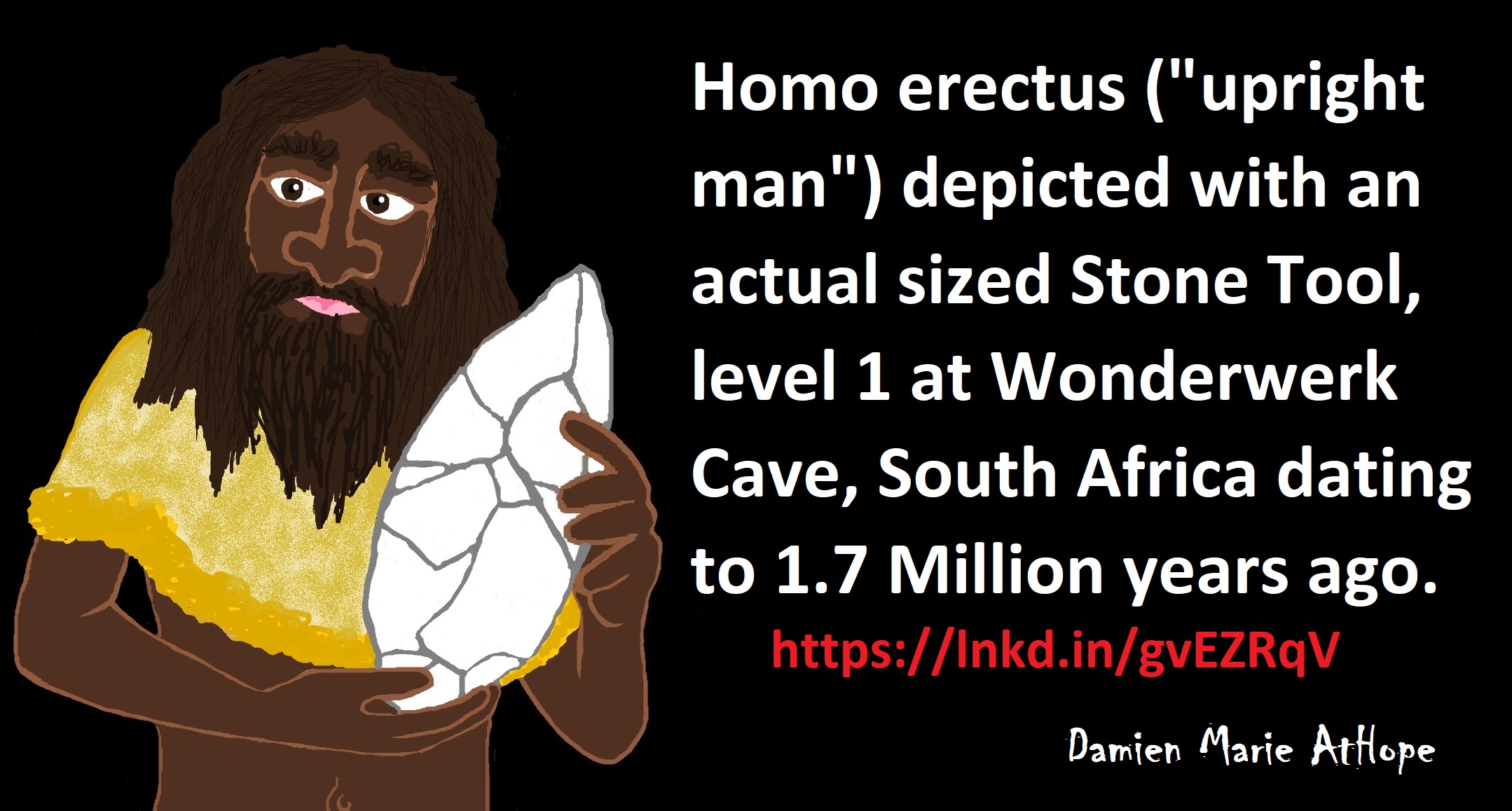
“Wonderwerk Cave is an archaeological site, in the Kuruman Hills, situated between Danielskuil and Kuruman in the Northern Cape Province, South Africa, dating suggests that basal sediment entered the cave some 2 million years ago. Evidence within Wonderwerk cave has been called the oldest controlled fire with what is thought to be Fire-Making by about 1.7 Million Years Ago. Moreover, evidence for fire-making ranges from the end of the Later Stone Age to the very base of the Acheulean. That discovery is seen to be in accord with findings from four other regional sites, which together provide evidence that can be construed as support for fire-making over almost the same time span.” ref, ref
“A handaxe (or hand ax) is a prehistoric stone tool with two faces that is the longest-used tool in human history. Hand axe tools were possibly used to butcher animals; to dig for tubers, animals, and water; to chop wood and remove tree bark; and/or process vegetal materials. Other scholars have proposed that hand axes were used to throw at prey; for a ritual or social purpose; or possibly as a source for flake tools. Moreover, No academic consensus describes their use, but it is commonly agreed that the hand axe was some form of unhafted all-purpose tool. The pioneers of Palaeolithic tool studies first suggested that bifaces were used as axes despite the fact that they have a sharp border all around. Other uses seem to show that hand axes were a multi-functional tool, leading some to describe them as the “Acheulean Swiss Army knife“. Other academics have suggested that the hand axe was simply a byproduct of being used as a core to make other tools, a weapon, and/or was perhaps used ritually.” ref
“Evidence for unusual symbolic activity in Wonderwerk date to around 400,000–500,000 years ago, which predates Middle Stone Age sites like Blombos Cave deposits that currently date at between c. 100,000 and 70,000 years ago.” ref, ref
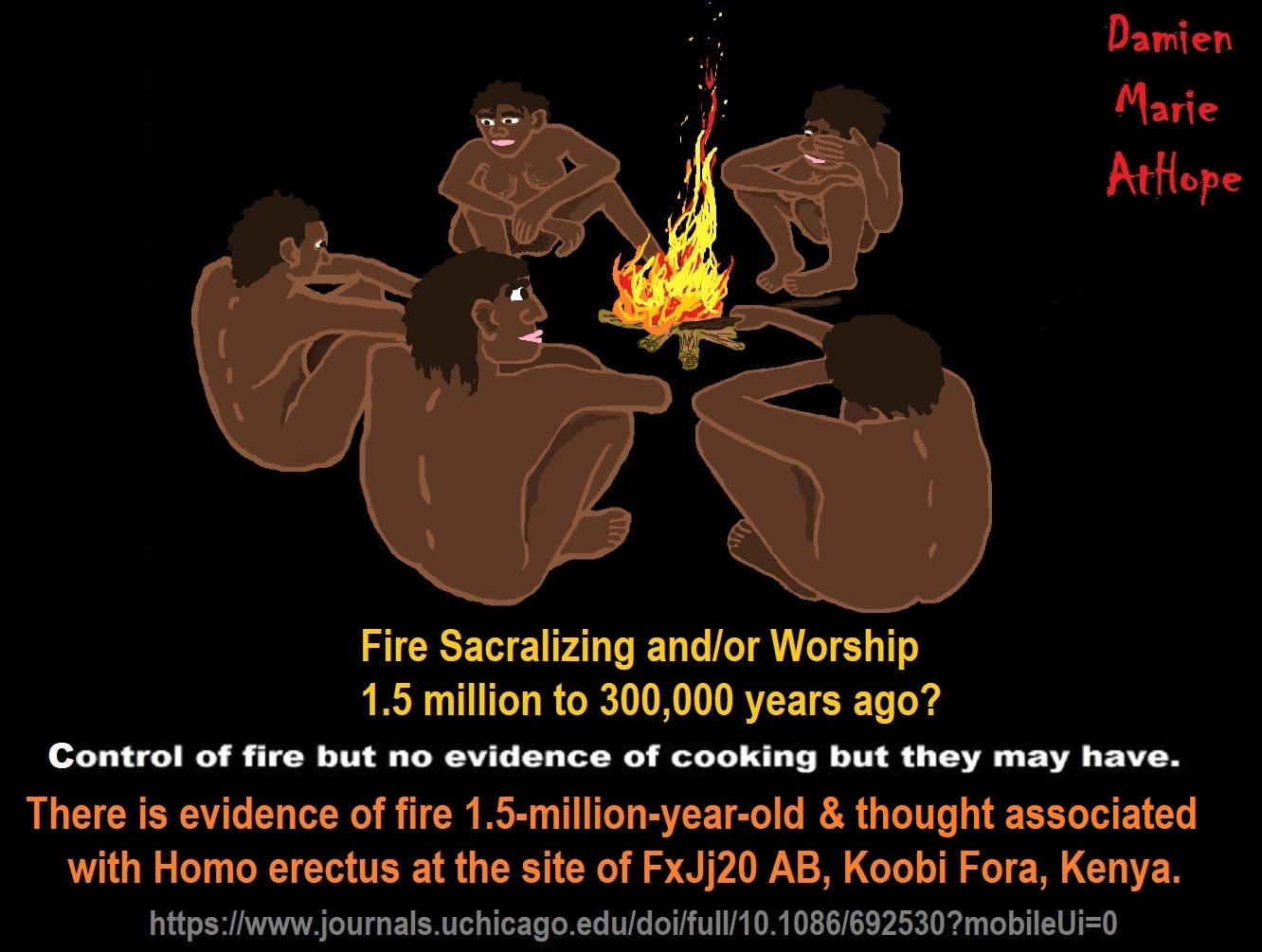
Fire at 1.5 Mya on the Site of FxJj20 AB, Koobi Fora, Kenya
The Evolution of Fire Sacralizing and/or Worship 1.5 million to 300,000 years ago and beyond?
Prehistoric remains in the Atapuerca region’s limestone caves preserved a million years of human evolution. Among these sites is the cave of Gran Dolina, where six hominin skeletons, dated between 780,000 and 1.2 million years ago, skeletons belonging to the species Homo erectus, Homo heidelbergensis, or Homo
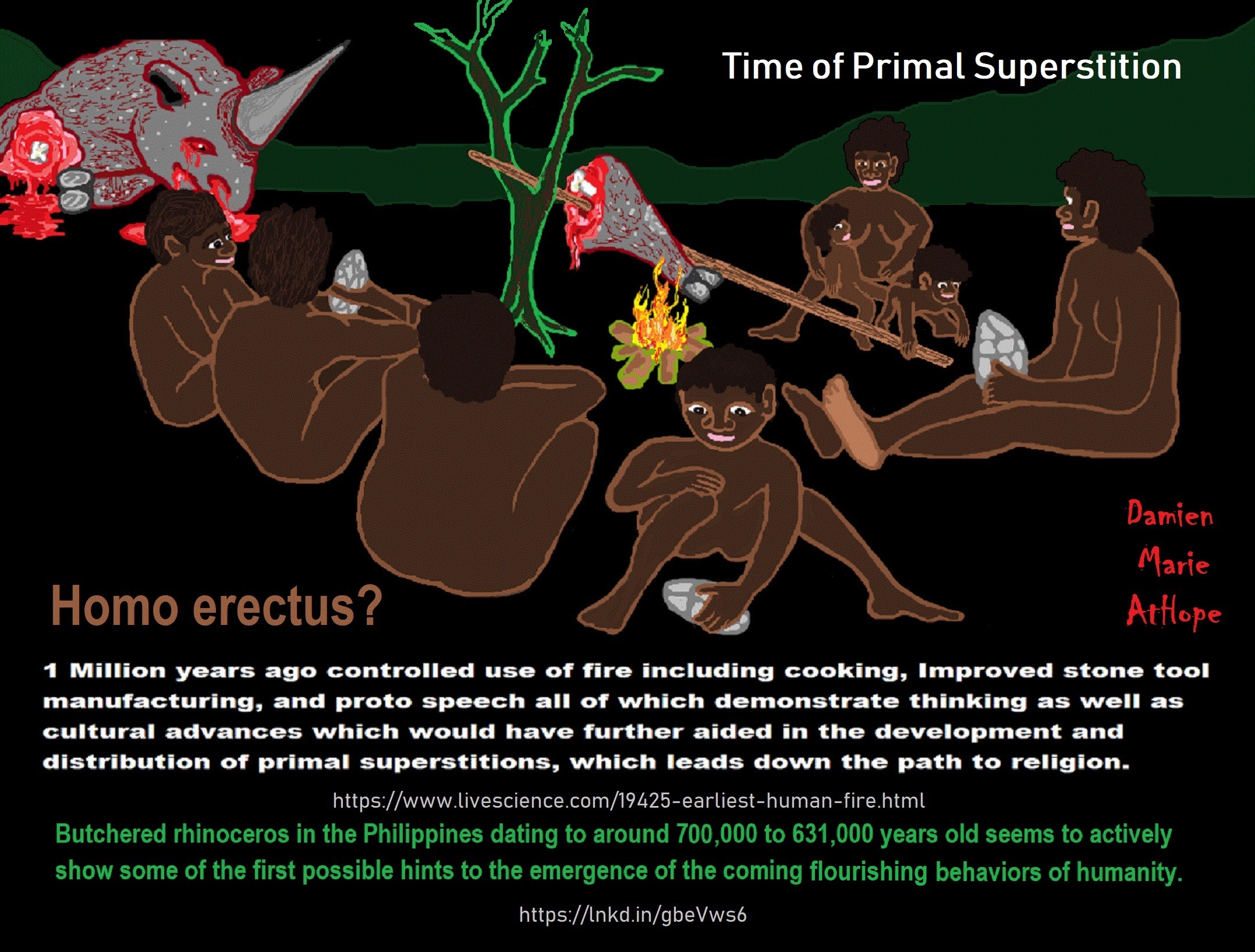
A million years ago fire was used, ash and charred bone, at Wonderwerk Cave in South Africa. Fire can be said to have a reasonably wide use and possibly being sacralized then, but we do know at some point it was attached to sacredness. At what point in humanoid history did these sacred rituals fully appear, and did shared feasting aid in this? What dreams were dreamed, what stories told around the fire? There seems to be fossil evidence of feasting on rhinos dating to around 2 million years ago. (likely was scavenged not killed in a hunt. The fossils and stone tools from the Philippines were dated to between 777,000 and 631,000 years ago, and research confirmed that the butchering of the rhino took place around 700,000 years ago. ref, ref, ref
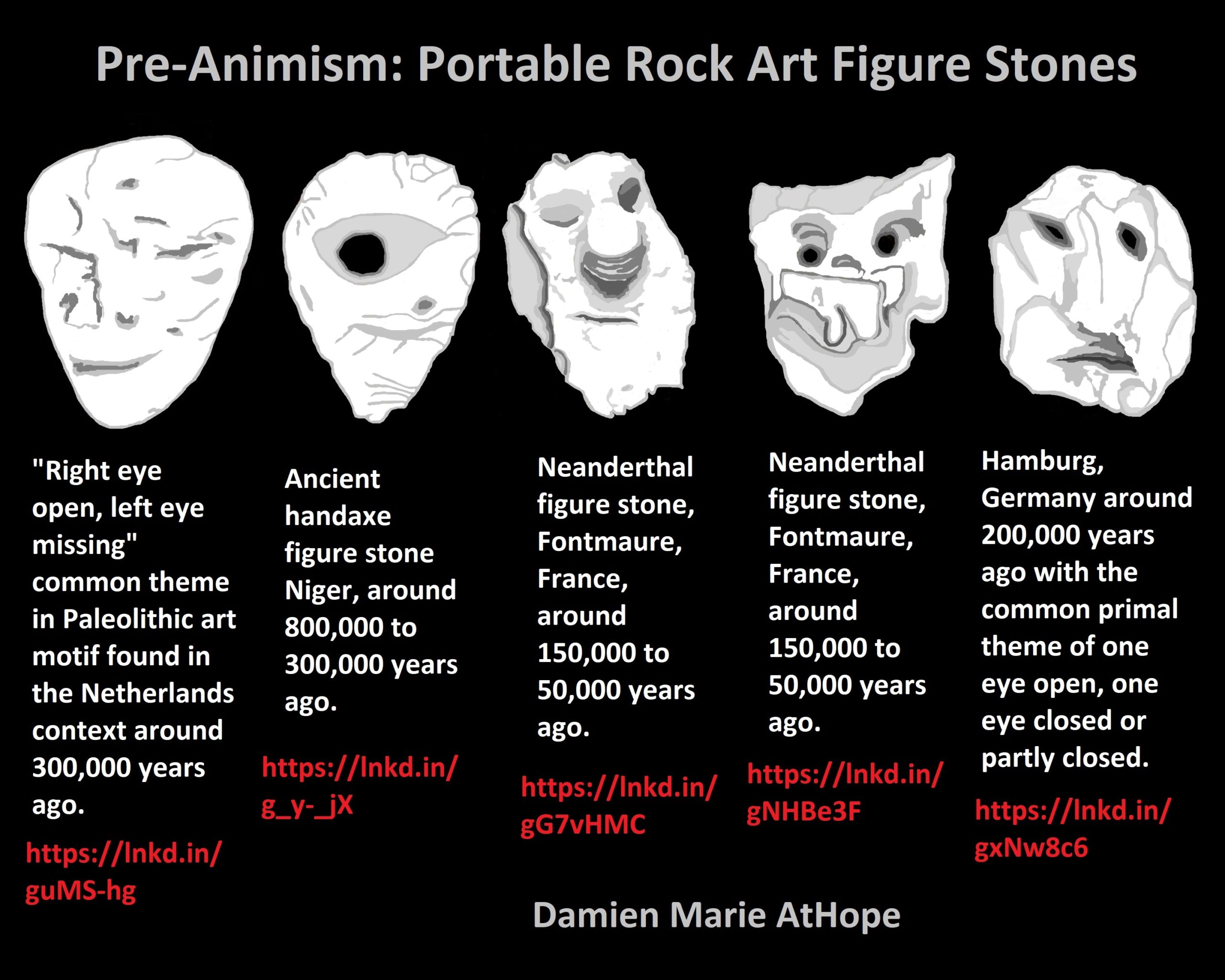
Pre-Animism: Portable Rock Art Figure Stones
Stone Age Art: 500,000 – 233,000 Years Old
Ancient handaxe figure stone Niger, around 800,000 to 300,000 years ago. ref
“Right eye open, left eye missing” a common theme in Paleolithic art motif found in the Netherlands context around 300,000 years ago. ref
Neanderthal figure stone, Fontmaure, France, around 150,000 to 50,000 years ago. ref, ref
Hamburg, Germany around 200,000 years ago with the common primal theme of one eye open, one eye closed or partly closed. ref
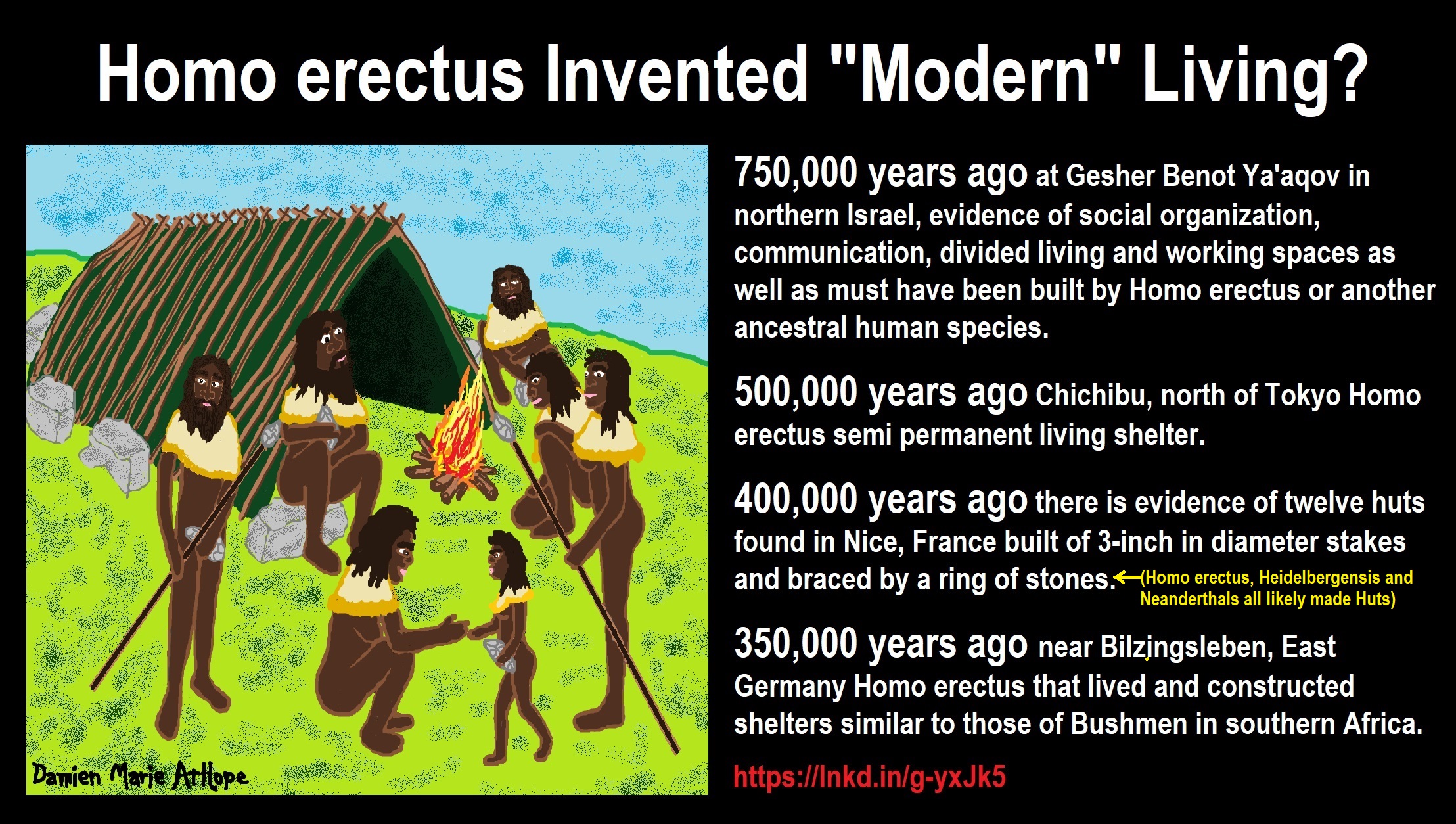
Homo erectus Invented “Modern” Living?
750,000 years ago at Gesher Benot Ya’aqov in northern Israel, is found some of the earliest known evidence of social organization, communication, and divided living and working spaces—all considered hallmarks of modern human behavior. The former hunter-gatherer encampment dates back as far as 750,000 years ago, and must have been built by Homo erectus or another ancestral human species. ref
Homo heidelbergensis likely emerged at least 600,000 years ago, left Africa between 300,000 to 400,000 years ago, and is also believed to have lived in huts, utilized fire, use stone-tipped spears, and there is some evidence that they may have buried their dead which if confirmed, thought by some doubted, would be an indication of symbolic / abstract thought. Red ochre has also been found at some Homo heidelbergensis sites. The Homo heidelbergensis that remained in Africa would later evolve into Homo sapiens approximately 130,000 years ago. ref
500,000 years ago Chichibu, north of Tokyo Homo erectus semi-permanent living shelter. It consists of what appear to be 10 post holes, forming two irregular pentagons which may be the remains of two huts. Thirty stone tools were also found scattered around the site. ref
400,000 years ago there is evidence of twelve huts found in Nice, France (the question is who made this, and the ideas rang from Homo erectus, Homo heidelbergensis to even possibly Neanderthals as all three are believed to make and live in Hut shelters at least at sometimes). They were oval shelters that ranged from 26 feet to 49 feet in length and were between 13 feet and 20 feet wide. They were built of 3-inch in diameter stakes and braced by a ring of stones. Longer poles were set around the perimeter as supports. The huts had hearths and pebble-lined pits and were defined by stake holes. ref
350,000 years ago near Bilzingsleben, East Germany Homo erectus that lived and constructed shelters similar to those of Bushmen in southern Africa. Circular bone and stone foundations were discovered for three huts between 9 and 13 feet across. In the middle of on circle, archaeologists found an elephant tusk, which they speculated was a center post. ref
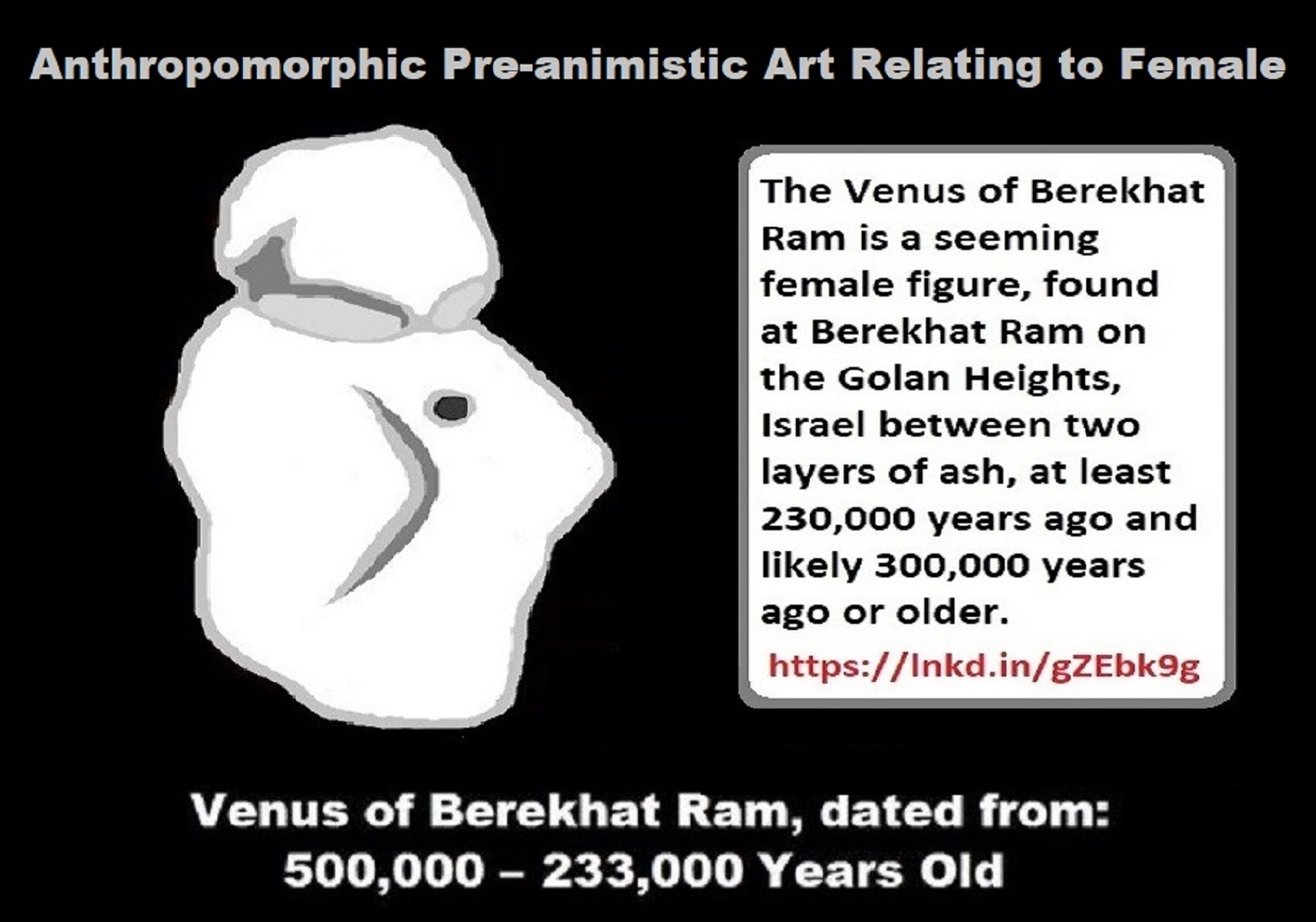

Anthropomorphic Pre-animism “Human Face” Art
Figure-stones present in additional objects from the same context as the Belgian Kempen, Belgium, like these stone faces dated to around 450,000 to 300,000 years old. They indicate the eye concavities are natural features but the overall shape of the piece possibly was worked to the final head shape. ref

430,000 years ago, Sima de los Huesos, “Pit of Bones”, Atapuerca, Spain, seeming evidence of intentional storing of 28 individuals in a cave chamber pit (a symbolic pseudo-womb?) and a reddish quartzite tool found with the bodies, seems like a kind of ritual funeral offering in this possibly early cemetery. Fossil remains of 430,000-400,000-years-old 28 individuals, 6,500 bone fragments, and 500 teeth, in one of several important sections of the Cueva Mayor-Cueva del Silo cave system in north-central Spain. The bone pit is at the bottom of the cave, beneath an abrupt vertical shaft measuring between 6.5-13 feet in diameter, and located about .1/3 of a mile in down a 42.5 ft shaft and it is possibly an expression of mortuary practices. Ref
Whit a high representation of adolescents and prime-age adults and a low percentage of adults between 20 and 40 years of age. Only one individual was under 10 at the time of death, and none were over 40-45 years old: statistically, say the scholars, there should be more children. Ref
Sima de los Huesos represents a purposeful burial, based partly on the recovery of a single quartzite Acheulean handaxe and the complete lack of stone tool waste or other habitation waste at all. Moreover, evidence suggesting that at least one of the individuals in the pit died as a result of interpersonal violence. Cranium 17 has multiple impact fractures thus is believe to have been dead at the time s/he was dropped into the shaft and seemingly placing dead bodies into the pit was indeed a social practice of the community. Ref
A large variety in cranial capacity and other characteristics were detailed possibly the population was evolutionarily related to Neanderthals as a sister group, and could best fit into the then-refined species of Homo heidelbergensis, or more likely it is thought the fossils represented an archaic form of Neanderthal, rather than Homo heidelbergensis. Studies highlight that the Sima de los Huesos population shares some DNA with the Denisovans, rather than the Neanderthals. 17 complete skulls have numerous Neanderthal-like characteristics so less likely to be a Homo heidelbergensis this groups dates are close to the age predicted for when the split in hominid species creating the Neanderthal and Denisovan lineages occurred. Ref
This cave artifacts are dated to around 300,000 to as much as 400,000 to even maybe 500,000 years ago Acheulean stone tool culture made of red stone tool offering in the ear;y cemetery, was nicknamed, Excalibur. Ref
Finally, genetic analysis of the Sima de los Huesos fossils seems to suggest that Homoheidelbergensis in its entirety should be included in the Neanderthal lineage, as “pre-Neanderthal” or “archaic Neanderthal” or “early Neanderthal”, while the divergence time between the Neanderthal and modern lineages has been pushed back to before the emergence of H. heidelbergensis, to about 600,000 to 800,000 years ago, the approximate time of disappearance of Homo antecessor. Ref
An archaeological site in Schöningen, Germany contained eight exceptionally well-preserved ~400,000-year-old spears for hunting, and various other wooden tools. 500,000-year-old hafted stone points used for hunting are reported from Kathu Pan 1 in South Africa, tested by way of use-wear replication. This finding could mean that modern humans and Neanderthals inherited the stone-tipped spear, rather than developing the technology independently. mitochondrial DNA samples from three caves Sima de los Huesos revealed that they are “distantly related to the mitochondrial DNA of Denisovans rather than to that of Neanderthals.” ref
In 2016 Nuclear DNA analysis determined the Sima hominins are Neanderthals and not Denisova hominins and the divergence between Neanderthals, Denisovans and Anatomically Modern Humans predates 430,000 years ago. ref
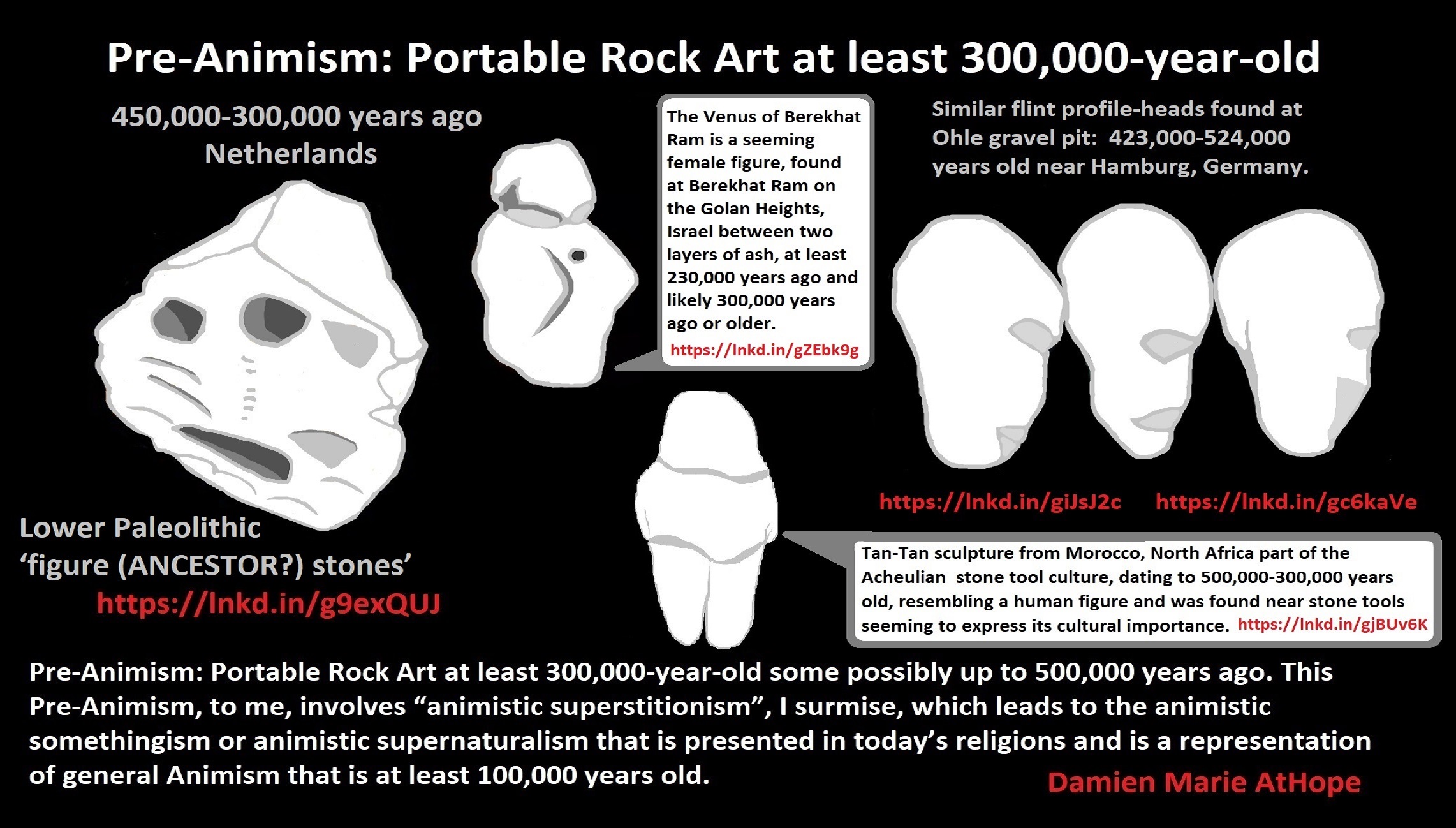

Fossils from Morocco suggest the Homo sapiens lineage became distinct as early as 350,000 years ago, adding as much as 150,000 years to our species’ history, as before it was assumed our Human line emerged around 200,000 years ago. ref
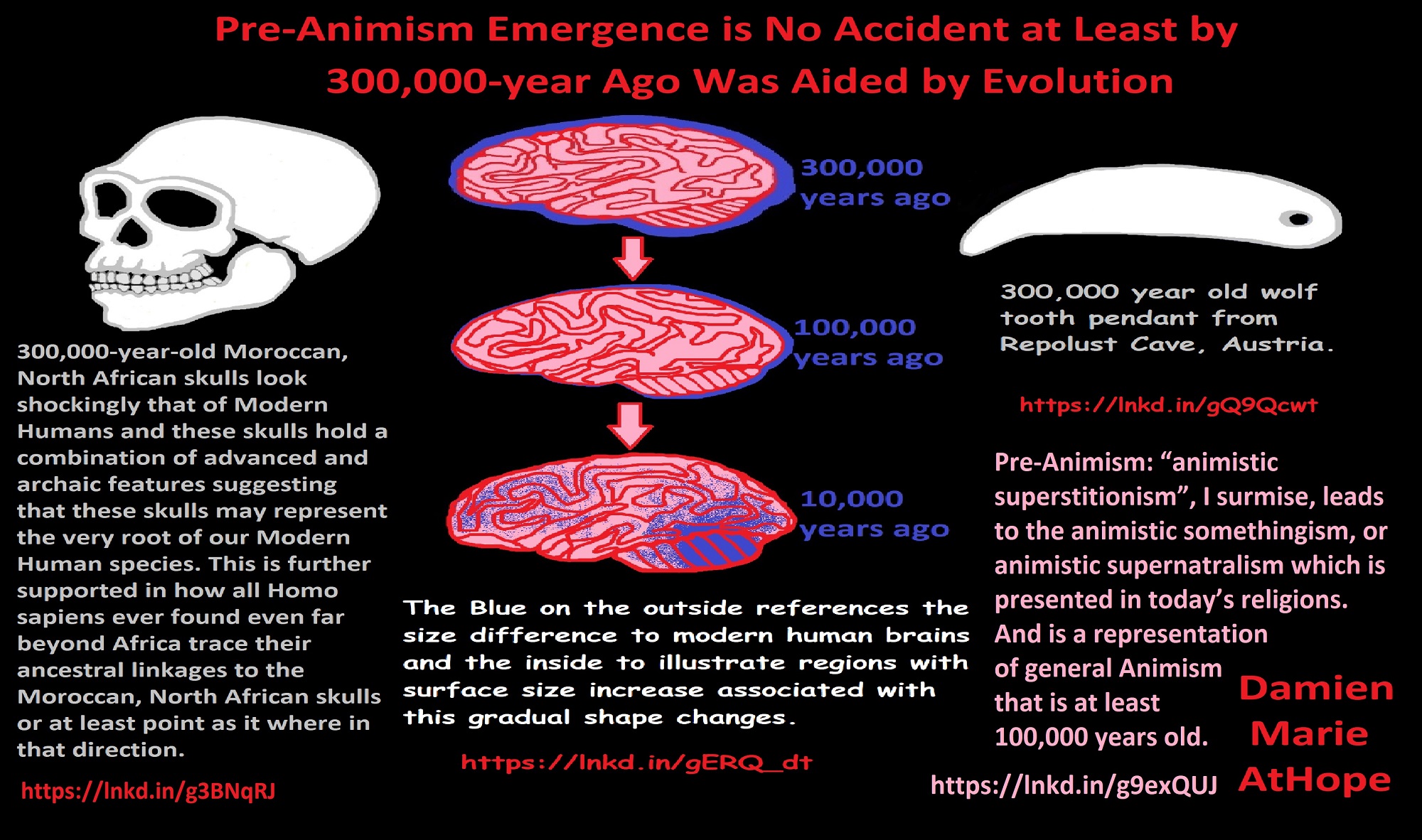
Pre-Animism Emergence is No Accident at Least by 300,000-year Ago Was Aided by Evolution
Pre-Animism: “animistic superstitionism”, I surmise, leads to the animistic somethingism, or animistic supernatralism is presented in today’s religions and is a representation of general Animism that is at least 100,000 years old. ref
The Blue on the outside references the size difference to modern human brains and the inside to illustrate regions with surface size increase associated with this gradual shape changes. ref
300,000-year-old Moroccan, North African skulls look shockingly that of Modern Humans and these skulls hold a combination of advanced and archaic features suggesting that these skulls may represent the very root of our Modern Human species. This is further supported in how all Homo sapiens ever found even far beyond Africa trace their ancestral linkages to the Moroccan, North African skulls or at least point as it were in that direction. And seemingly Homo sapiens could have been living across Africa and sem9ingly engaging in extensive movement, which could have involved exchange both in ideas, technology as well as even genetics. ref
300,000-year-old wolf tooth pendant from Repolust Cave, Austria. ref
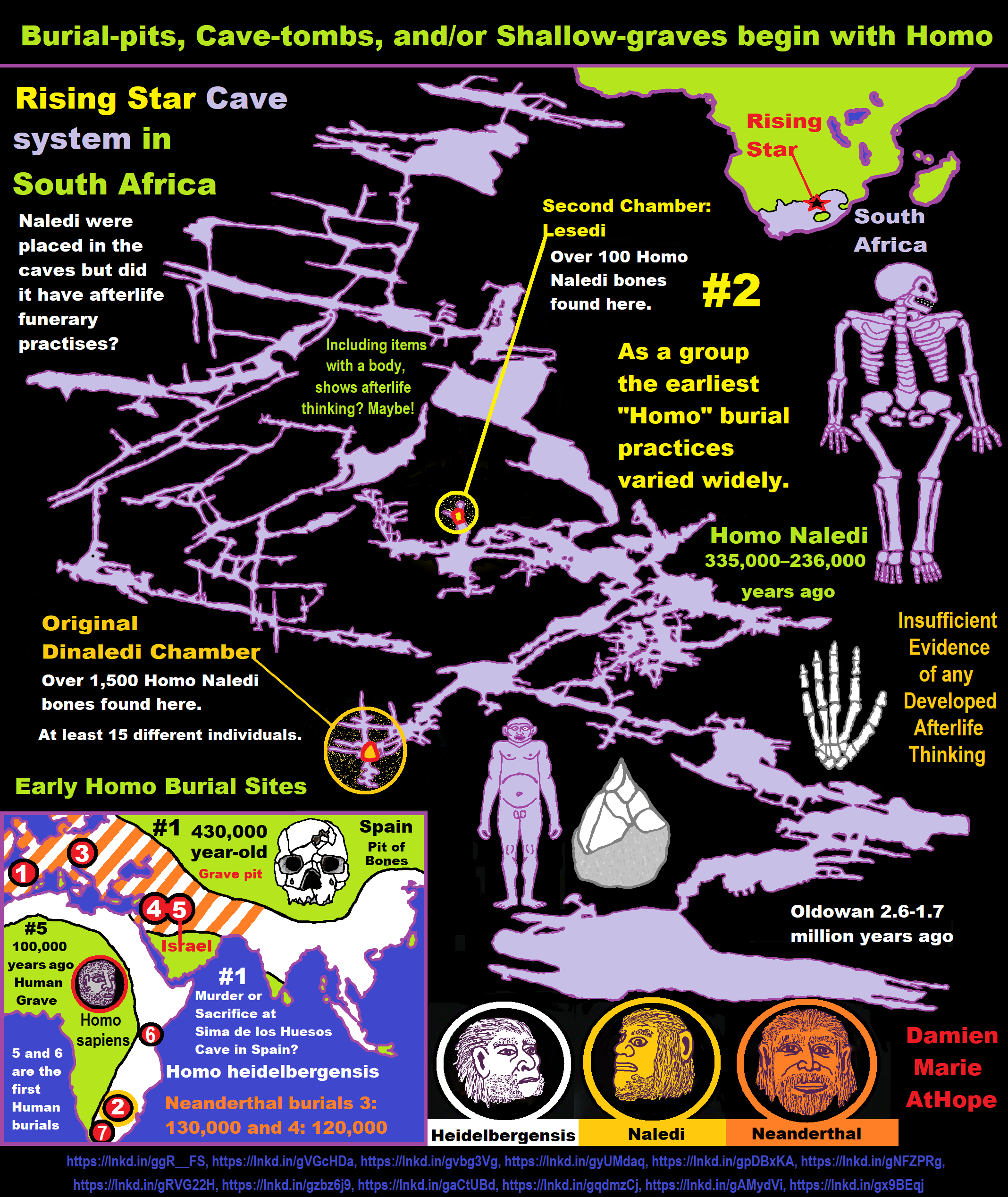
ref, ref, ref, ref, ref, ref, ref, ref, ref, ref, ref, ref
Homo Naledi
“Homo Naledi is a species of archaic human discovered in the Rising Star Cave, Cradle of Humankind, South Africa dating to the Middle Pleistocene 335,000–236,000 years ago. The initial discovery comprises 1,550 specimens, representing 737 different elements, and at least 15 different individuals. Despite this exceptionally high number of specimens, their classification with other Homo remains unclear.” ref
“Along with similarities to contemporary Homo, they share several characteristics with the ancestral Australopithecus and early Homo as well (mosaic anatomy), most notably a small cranial capacity of 465–610 cm3 (28.4–37.2 cu in), compared to 1,270–1,330 cm3 (78–81 cu in) in modern humans. They are estimated to have averaged 143.6 cm (4 ft 9 in) in height and 39.7 kg (88 lb) in weight, yielding a small encephalization quotient of 4.5. Nonetheless, Homo Naledi’s brain anatomy seems to have been similar to contemporary Homo, which could indicate equatable cognitive complexity. The persistence of small-brained humans for so long in the midst of bigger-brained contemporaries revises the previous conception that a larger brain would necessarily lead to an evolutionary advantage, and their mosaic anatomy greatly expands the known range of variation for the genus.” ref
“Homo Naledi anatomy indicates that, though they were capable of long-distance travel with a humanlike stride and gait, they were more arboreal than other Homo, better adapted to climbing and suspensory behavior in trees than endurance running. Tooth anatomy suggests consumption of gritty foods covered in particulates such as dust or dirt. Though they have not been associated with stone tools or any indication of material culture, they appear to have been dextrous enough to produce and handle tools, and likely manufactured Early or Middle Stone Age industries. It has also been controversially postulated that these individuals were given funerary rites, and were carried into and placed in the chamber.” ref
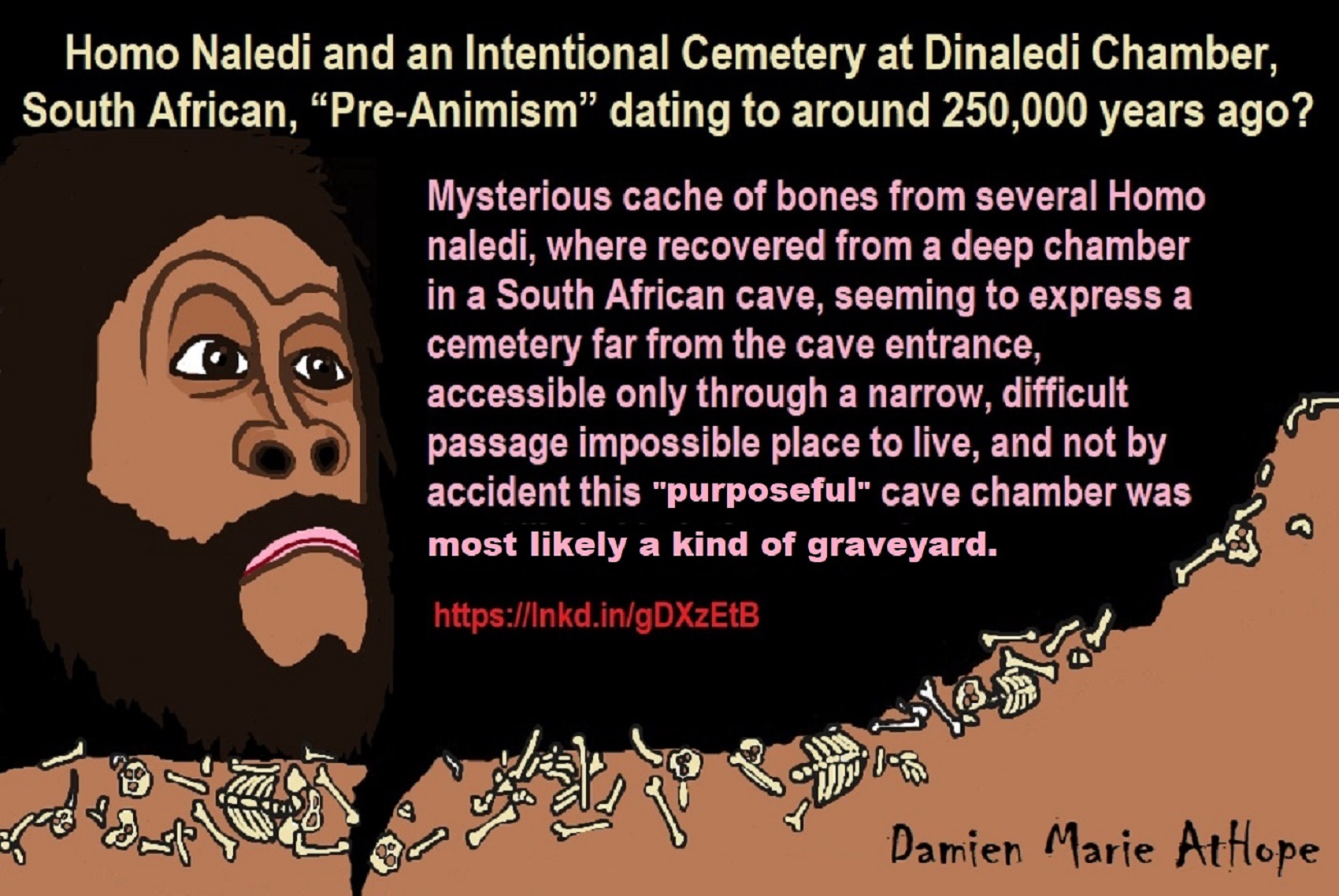
Homo Naledi and an Intentional Cemetery “Pre-Animism” dating to around 250,000 years ago?
To me, it seems likely Homo Naledi did have an intentional cemetery as seen at Dinaledi Chamber, in South African, thus “Pre-Animism” dating to around 250,000 years ago.
Age of Ape-Human Species Homo
Original chamber: Dinaledi with over 1,500 Homo
New chamber: Lesedi with over 100 Homo
“Though there were some who have been skeptical at first with the addition of another set of remains in another cave area some vindication for one of its most hotly contested hypotheses: that in some form or fashion, H.
“Much like the Dinaledi Chamber, which requires passing through a seven-inch-wide slot to enter, the Lesedi Chamber also poses unique challenges to archaeological excavations. Marina Elliott, the Wits exploration scientist who led excavations in both chambers, says that while Lesedi isn’t quite as hard to reach as Dinaledi, it’s harder to excavate. Neo was found in a narrow “blind” alcove less than two feet wide. “I basically excavate lying on my chest or in the fetal position, with both my shoulders pinned in by rock on either side,” she says. “It’s extremely physically difficult; I’ve tried to do a lot of yoga to get myself to be able to do it.” Berger himself hasn’t set foot in Dinaledi, and only once has he ventured into Lesedi. During his return to the surface, he got stuck for nearly an hour, requiring his colleagues to pull him out by ropes around his wrists. Team members now call the squeeze the Berger Box. In light of the Lesedi Chamber’s discovery, Berger’s team has claimed some vindication for one of its most hotly contested hypotheses: that in some form or fashion, H.
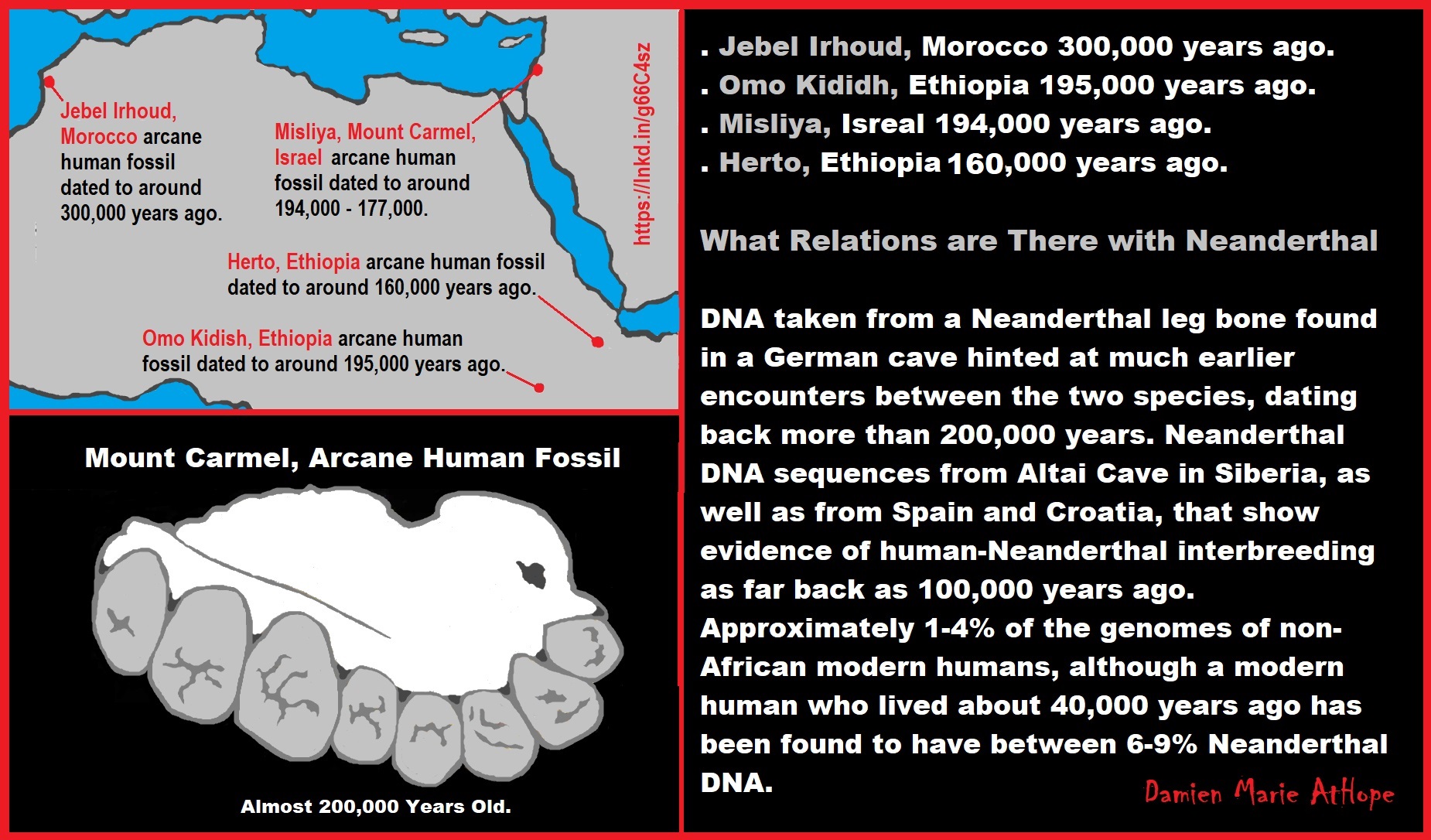
. Jebel Irhoud, Morocco 300,000 years ago. ref
. Omo Kididh, Ethiopia 195,000 years ago. ref
. Misliya, Isreal 194,000 years ago. ref
. Herto, Ethiopia 160,000 years ago. ref
What Relations are There with Neanderthal
DNA taken from a Neanderthal leg bone found in a German cave hinted at much earlier encounters between the two species, dating back more than 200,000 years. Neanderthal DNA sequences from Altai Cave in Siberia, as well as from Spain and Croatia, that show evidence of human-Neanderthal interbreeding as far back as 100,000 years ago. Approximately 1-4% of the genomes of non-African modern humans, although a modern human who lived about 40,000 years ago has been found to have between 6-9% Neanderthal DNA. ref, ref
Although all of the early fossils of Homo sapiens are found with Middle Stone Age artifacts, it is unlikely that our species was the exclusive author of MSA lithic technology. On present evidence, the oldest Middle Stone Age sites are in eastern Africa, at around 276,000 years ago, such as at Gademotta, Ethiopia. The overlap between age estimates for the earliest MSA and the latest Acheulian sites supports the hypothesis of a prolonged shift to MSA technologies. The youngest reported Acheulian artifacts are surface collected from the Herto Member of the Bouri Formation of Ethiopia, dated to around 154–160,000 years ago, and in situ material around 125,000 years ago from Abdur, Eritrea, in northeast Africa. The Acheulian attribution of the material from Abdur results suggest around 100,000–150,000 years overlap between Acheulian and MSA technologies in eastern Africa. There remains the possibility that the Acheulian artifacts from the Herto Member are older than the dated sediments by an unknown but possibly large interval. ref, ref
However, L0 most likely has a southern African origin on the basis of its prevalence in indigenous Khoe (both herder and hunter-gatherer) and San (Ju- and Tuu-speaking “Bushman” hunter-gatherer) populations, as well as in exclusively southern African Bantu speakers – although one of the main subclades of L0 (L0a’b’f) may have an eastern African origin. Thus from the time after the main African clades have evolved they can prove highly informative; but the final path back to the human mtDNA root remains mysterious. Furthermore, it is not clear that different systems are informing us about the same phenomena. “Modern” features in human anatomy, appear ~150,000–200,000 years ago, and predominate in Africa after 130,000 years ago, but there is no indication in the fossil record of a speciation event at this time, and Homo sapiensemerges gradually from more archaic specimens in Africa over the preceding few hundred thousand years. ref

Neanderthals, diverged from Arcane Humans around 500,000, with several likely occurrences of interbreeding after that. Evidence from Neanderthal DNA found in a German cave expresses early interbreeding, dating back more than 200,000 years. Moreover, a 200,000 years old prehistoric jawbone was found in an Israeli cave. Then there is DNA evidence for interbreeding around 100,000 years ago from the Altai mountains on the Russia-Mongolia border. An early modern human population left Africa much earlier and met with Neanderthals, possibly those moving from Europe towards the East, sometime around 100,000 years ago. Anatomically modern humans migrated massively from Africa into the Middle East and later Europe, starting some 65,000 years ago. Anatomically modern humans migrated massively from Africa into the Middle East and later Europe, starting some 65,000 years ago. A 55,000-year-old incomplete skull found in Israel may belong to a human group that interbred with Neanderthals. And then there is interbreeding with modern humans about 65,000-47,000 years ago, With East Asian populations, genetics relating to Neanderthals emerging around 45,000 years ago. Modern Humans share 99% their genes with Neanderthal “proto-humans.” DNA analysis of one of the oldest Homo sapiens skeletons in Europe, also found in Romania and dated to around 40,000 years ago, has shown that this individual’s ancestors had interbred with Neanderthals between four to six generations earlier. ref, ref, ref, ref, ref, ref
Genome studies of Neanderthals (Homo neanderthalensis) and of both ancient and contemporary H. sapiens suggest that the two species interbred somewhere in the Middle East between 50,000 and 60,000 years ago. But no remains of anatomically modern humans have been discovered in the Middle East from this crucial period, after H. sapiens left Africa and before it colonized Europe and Asia. ref
Neanderthal introgression within the chromosome 3p21.31 region, occurring with a high frequency in East Asians (ranging from 49.4% to 66.5%) and at a low frequency in Europeans. We also detected a signal of strong positive selection in this region only in East Asians. Our data indicate that likely candidate targets of selection include rs12488302-T and its associated alleles—among which four are nonsynonymous, including rs35455589-G in HYAL2, a gene related to the cellular response to ultraviolet-B irradiation. Furthermore, suggestive evidence supports latitude-dependent selection, implicating a role of ultraviolet-B. Interestingly, the distribution of rs35455589-G suggests that this allele was lost during the exodus of ancestors of modern Eurasians from Africa and reintroduced to Eurasians from Neanderthals. The introgressive haplotypes were positively selected in only East Asian populations, rising steadily from 45,000 years ago until a sudden increase of growth rate around 5,000 to 3,500 years ago. They occur at very high frequencies among East Asian populations in contrast to other Eurasian populations (e.g. European and South Asian populations). The findings also suggests that this Neanderthal introgression occurred within the ancestral population shared by East Asians and Native Americans. ref
Analyzing chromosome 21 of the Altai (Siberia), El Sidrón (Spain), and Vindija (Croatia) Neanderthals, it is determined that—of these three lineages—only the El Sidrón and Vindija Neanderthals display significant rates of gene flow (0.3–2.6%) into modern humans, suggesting that the El Sidrón and Vindija Neanderthals are more closely related than the Altai Neanderthal to the Neanderthals that interbred with modern humans about 47,000–65,000 years ago. Conversely, it is also determined that significant rates of modern human gene flow into Neanderthals occurred—of the three examined lineages—for only the Altai Neanderthal (0.1–2.1%), suggesting that modern human gene flow into Neanderthals mainly took place after the separation of the Altai Neanderthals from the El Sidrón and Vindija Neanderthals that occurred roughly 110,000 years ago. The findings show that the source of modern human gene flow into Neanderthals originated from a population of early modern humans from about 100,000 years ago, predating the out-of-Africa migration of the modern human ancestors of present-day non-Africans. ref

Three, 200,000 years old fragments of ostrich-eggshell beads, connecting to Late Acheulian of El Greifa E, Libya which are similar to beads found at two Upper Palaeolithic sites in India. ref
What is the meaning of early beads and pendants? Well, for sure some beads, in which production has been pushed to the limits allowed by the medium, seem to express a sense of perfection, and it is contended that beads are among the most informative forms of exograms that could possibly have survived from these very early times. A key requisite for the use and appreciation of all beads and pendants is a level of hominin self-awareness that essentially expresses full cognitive modernity. Beads can be used in a number of ways or for several purposes and provide various forms of information about the wearer and the possible status in their society/culture. One might believe that beads are simply a body adornment, but this is almost certainly an oversimplification that is limited as o the original meaning (if they relate to stars it could be thought to represent the ancestors. The concept of “Personal Adornment” itself is rather anthropocentric; we do not assume that other animals perceive the information imparted by the beads as meaningful. ref
Estimates for the date at which early migration out of sub-Saharan Africa occurred vary from 200,000 to 80,000 years ago, evidence is elusive, but the excavation of what is being called ‘the deepest archaeological trench in North Africa’ has now proved that modern humans were living on the north coast of Libya at least 80,000 years ago; the question now is just how much further back they go but it is thought that the deepest archaeological trench in North Africa has potentially a 200,000-year-old story to tell. Moreover, modern humans (Homo sapiens) did not arrive in North Africa until around 40,000 years ago, which is about when they reached Europe. ref
There are shell ornaments in a limestone cave in Eastern Morocco dating to around 72,000 years ago along with evidence of shells, already known from as old as 110,000 to 82,000-year-old Aterian deposits in the cave occupations include pre-Mousterian, Aterian, and Iberomaurusianlithic industries. ref, ref

Neanderthals “Primal Religion (Pre-Animism/Animism?)” Mystery Cave Rings 175,000 Years Ago
Neanderthals “Primal Religion (Pre-Animism/Animism?)”, Mystery Cave Rings 175,000 Years Ago, possibly a chapel or sacred space? Well, we do know it had meaning in some symbolic way, and they easily predate the arrival of modern humans in Europe. Thus, likely, they were built by Neanderthals, the only hominins in the region. The stalagmite structures are 50 centimeters high in places, says Jaubert. They are built from around 400 individual stalagmites with a combined weight of about 2 tonnes which must take time [to shift] and thus some time and effort to arrange the structures. ref

Neanderthal Mousterian: Animism/Totemism?
The Mousterian (stone-tool culture/industry) of flint lithic tools associated primarily with the earliest anatomically modern humans in North Africa and West Asia, as well as with the Neanderthals in Europe from 160,000 to 40,000 years ago. ref
“The earliest tools of this kind were found at the Le Moustier site in southwestern France and tools of that kind are now called Mousterian tools. Neanderthal flaked toolmaking skills remained largely unchanged for 100,000 years.
“Examples of Mousterian tools have been found in Europe and Africa. Near the end of their existence, Neanderthals developed more sophisticated tools with shafted points and handles (Châtelperronian technology) and Aurignacian blade tools generally associated with early modern humans. Aurignacian tools are named after the French site of
Neanderthals who produce the first glue as early as 200,000 years ago.” ref
“Levantine Mousterian assemblages occur in Lebanon, Syria, Israel, and Jordan in contexts dating to between 47,000–250,000 several Levantine Mousterian assemblages and found evidence for a variety of functions on Middle Palaeolithic stone tools, including spear point use. And a methodology derived from breakage patterns of
“For Kebara, Rosh Ein Mor, Tor Faraj, and Yabrud, these values cluster within the lower part of the ‘‘spear point optimal zone’’, indicating that most Levallois points from these sites are relatively short and broad. This distribution supports the ‘‘spear points’’ hypothesis and contradicts the prediction of the ‘‘multipurpose knives’’ hypothesis. ‘Ain Difla exhibits values outside the optimal zone, suggesting that Levallois point production associated with this assemblage may have emphasized the production of knives, rather than spear points. This interpretation is supported by the results of Roler & Clark’s (1997) microwear analysis of Levallois points from ‘Ain Difla. While our data suggest Levallois points were designed for use as spear points, previous microwear studies of Levallois points from the Levantine Mousterian suggest that these tools were also used for a variety of tasks.” ref
If its predecessor, known as Levallois or “Levallois-Mousterian” is included, the range is extended to as early as c. 300,000–200,000 years ago. Moreover, Mousterian continued alongside the new Neandertal Châtelperronian industry during the 45,000-40,000. ref
“There are numerous sites in Europe and Asia which contain Levallois or proto-Levallois artifacts dated between Marine Isotope Stage (MIS) 8 and 9 (~330,000-300,000 years bp), and a handful as early as MIS 11 or 12 (~400,000-430,000 bp): although most are controversial or not well-dated.” ref
“The Levallois, or more precisely the Levallois prepared-core technique, is the name archaeologists have given to a distinctive style of flint knapping, which makes up part of the Middle PaleolithicAcheuleanand Mousterian artifact assemblages. Levallois technology is thought to have been an outgrowth of the Acheulean handaxe. ” ref
“Experimental archaeology, attempting to achieve a perfect Levallois flake requires a level of skill that can only be identified under very specific circumstances. These tools might have been used as arrowheads.” ref
“Later Levantine Mousterian assemblages dating to between 47,000–130,000 years ago, such as those from Tabun Unit I, Skhul B, Qafzeh I–XXIV, and Kebara
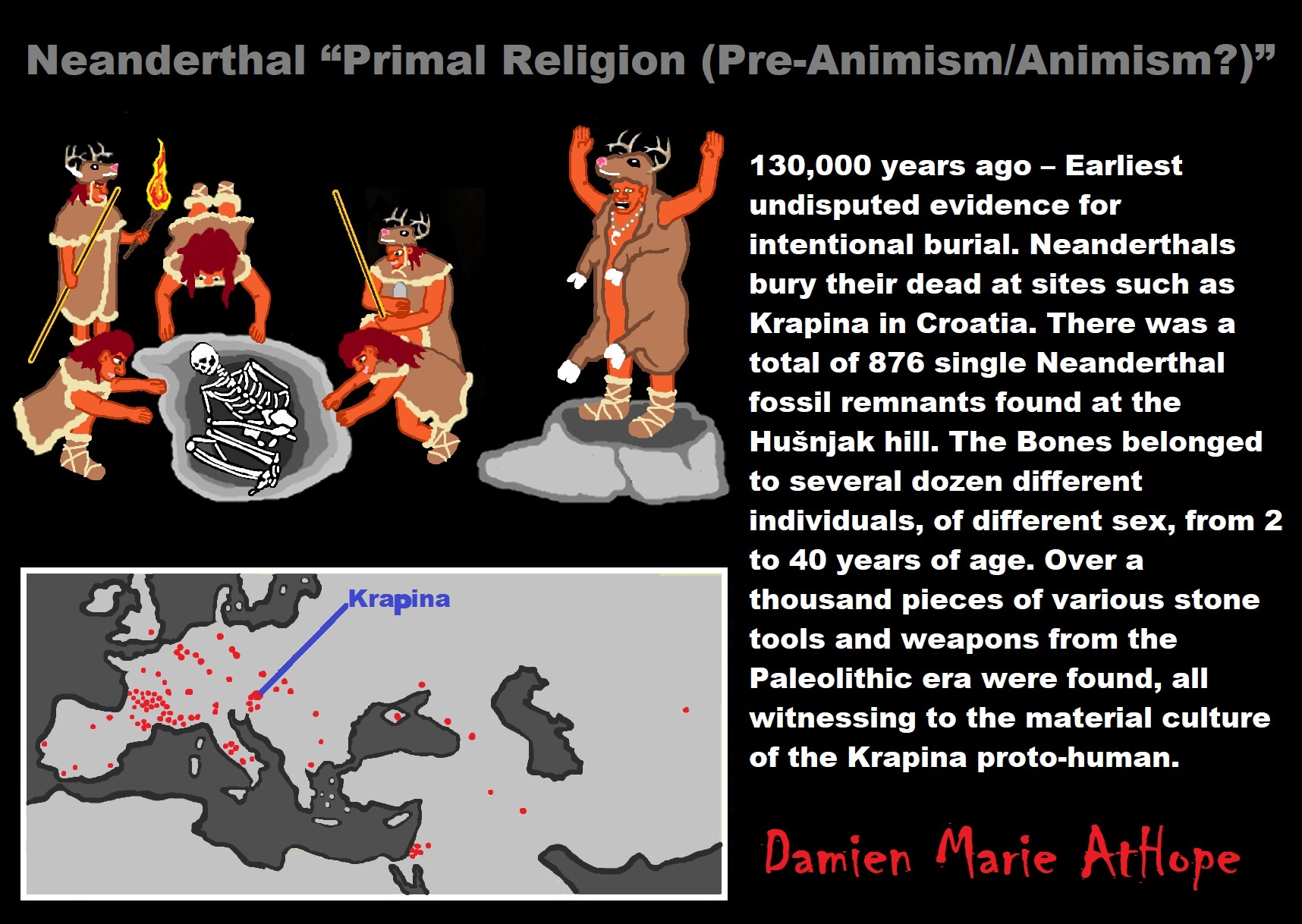
130,000 years ago – Earliest undisputed evidence for intentional burial and it is Neanderthals…
Evidence suggests that the Neanderthals were the first humans to intentionally bury the dead and possibly doing cannibalism which could be evidence of a death ritual, doing so in shallow graves along with stone tools and animal bones. 130,000 years ago – Earliest undisputed evidence for intentional burial. Neanderthals bury their dead at sites such as Krapina in Croatia. There was a total of 876 single Neanderthal fossil remnants found at the Hušnjak hill. The Bones belonged to several dozen different individuals, of different sex, from 2 to 40 years of age. Over a thousand pieces of various stone tools and weapons from the Paleolithic era were found, all witnessing to the material culture of the Krapina proto-human. This rich locality is approximately 130.000 years old.
Numerous fossil remnants of the cave bear, wolf, moose, large deer, warm climate rhinoceros, wild cattle, and many other animals were also found. Moreover, there
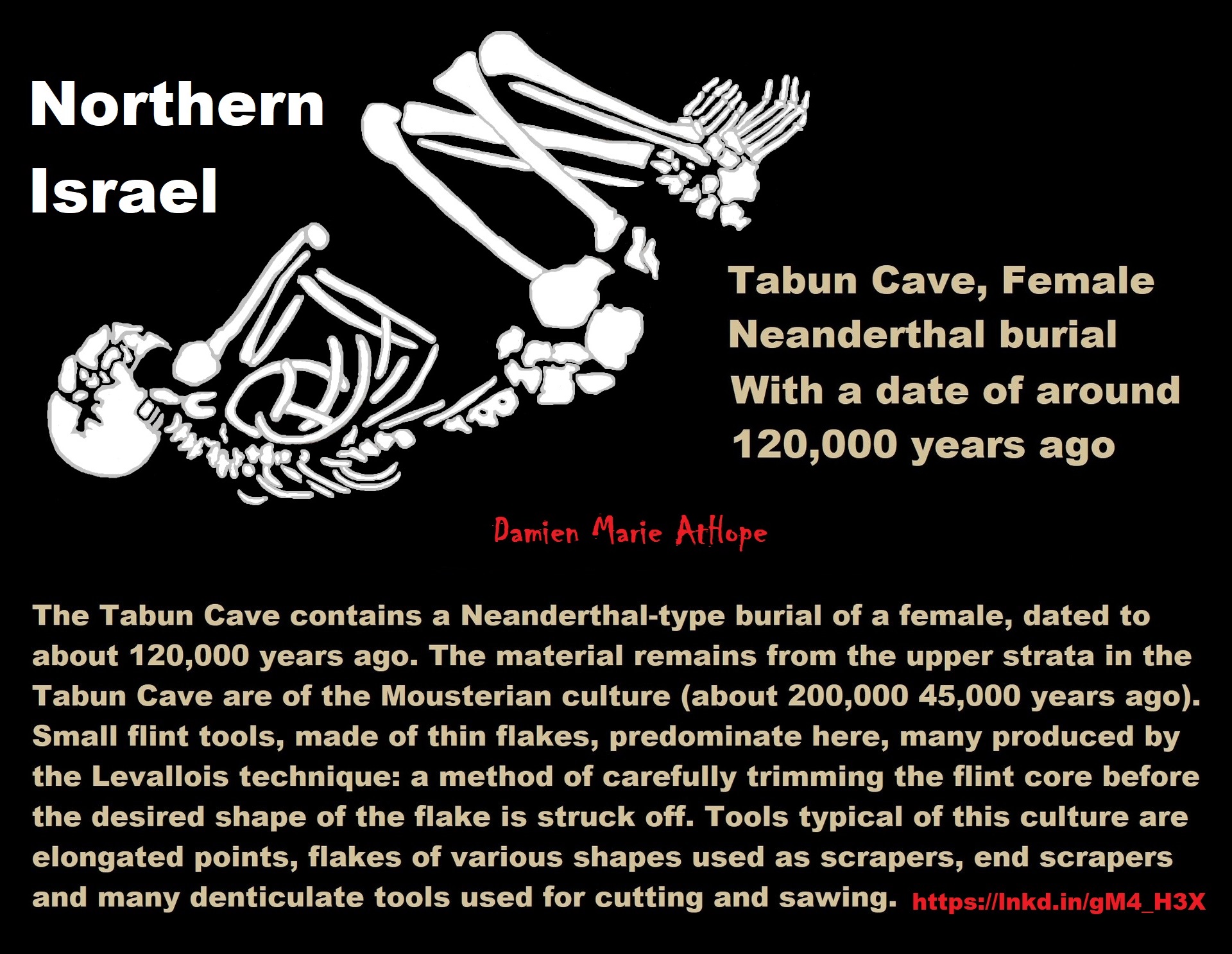
Did Neanderthals teach us “Primal Religion (Pre-Animism/Animism?)” 120,000 Years Ago?
Homo sapiens – is known to have reached the Levant between 120,000 and 90,000 years ago, but that exit from Africa evidently went extinct. Homo sapiens – is known to have reached the Levant between 120,000 and 90,000 years ago, but that exit from Africa evidently went extinct. Tabun Cave Mousterian (stone tool) culture (about 200,000 45,000 years ago). Small flint tools, made of thin flakes, predominate here, many produced by the Levallois technique. ref, ref
Mousterian is found in Morocco, Africa North and that means there could have ben interactions between Homo Sapiens and Neandertals. Evidence is commonly known for interbreeding between Neandertals and non-African modern humans. Ganetic evidence from North African populations show a significant excess of DNA with Neandertals, compared to sub-Saharan Africans which did not mix with Neandertals.. Furthermore, local, pre-Neolithic North African ancestry holds a higher Neandertal’s genetic signal, thus not due to recent Near Eastern or European migrations. Sub-Saharan populations are the only ones not affected by the admixture event with Neandertals. ref
Stone Tools Point to Two Distinct Neanderthal Cultures
A study of 1,300 stone hand axes found at 80 Neanderthal sites in France, Germany, Belgium, Britain, and the Netherlands shows that two cultural traditions existed among Neanderthals living in what is now northern Europe between 115,000 to 35,000 years ago. Three
Keilmesser is the type fossil of the late Middle Paleolithic Keilmessergruppen or Micoquian of central and eastern Europe. Keilmesser stone tools are

The Tabun Cave, Mount Carmel, Israel, occupied intermittently during the Lower and Middle Paleolithic (500,000 to around 40,000 years ago). Tabun suggests that ancestral humans used fire at the site on a regular basis since about 350,000 years ago and this likely would have shaped our culture and behavior. The material remains from the upper strata of the cave are of Levallois technique and the Mousterian culture (about 200,000 – 45,000 years ago). The Middle Palaeolithic of the southern Levant involved Neandertals and early modern humans, occupying the region at that time. Tabun Cave held fossil remains involved Neandertals and early modern humans but not an absolute chronology of the Levantine MP fossils though could indicates that an enamel fragment from the Tabun C1 could be as old as 143,000 years ago nearly double Tabun BC7. Moreover, a Neanderthal-type female, dated to about 120,000 years ago around the time early modern humans existed there which was between 120,000 – 90,000 years ago and again from 55,000 years ago on. ref, ref, ref, ref
Moreover, Tabun BC7 identified as a probable Neanderthal from Layer B, preliminary around 82,000 – 92,000 years ago Neandertals mainly existed in that region between ca. 80,000 – 55,000 years ago. Genomic flow evidence from early modern humans to the eastern Altai Neandertals around 100,000 and from Neandertals to early modern humans between ca. 60,000 – 50,000 years ago. In the Levant, the archaeological record cannot distinguish between these two as the two populations left similar material culture remains. In addition, at Tabun, Neandertal and early modern human populations used the same cave with possible shared changes occurring over a period of similar time, expressing a resemblance in burials, the Levallois stone tool culture settlement, and mobility patterns in respect to the use of caves for habitation. ref, ref, ref, ref
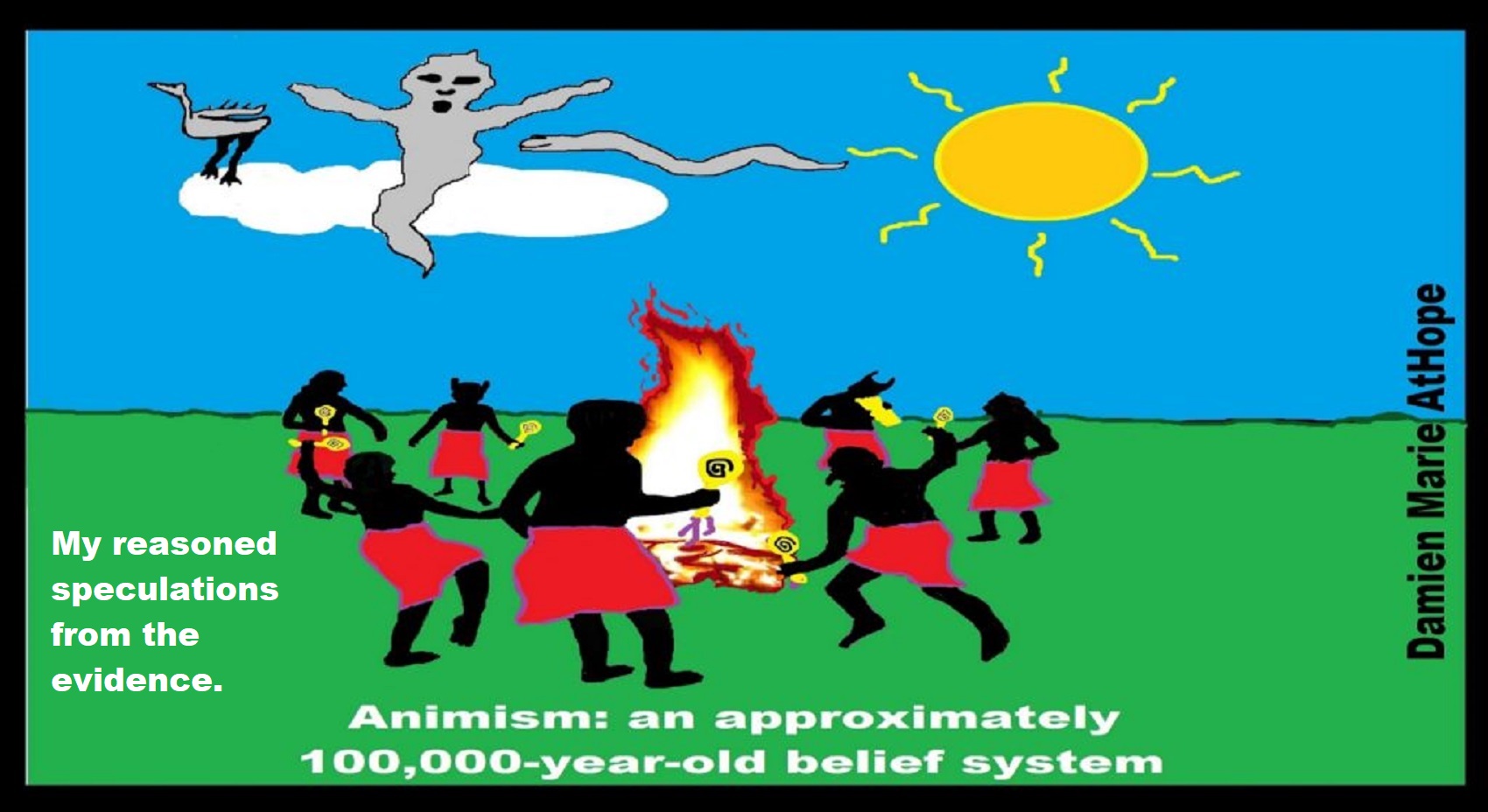
Animism is approximately a 100,000-year-old belief system and believe in spirit-filled life and/or afterlife. If you believe like this, regardless of your faith, you are a hidden animist.
Animism is more holistic, and feminine in nature things even though nature has tricksters and malevolence it is also protective and helpful. There s spirits and supernatural beings both animal and human as well as nonhuman supernatural things or being but in general would be attributed to a somewhat personal ancestor grandmother/grandfather or great grandmother/grandfather, not as much of what we think about like a god today.
Animism (from Latin anima, “breath, spirit, life”) is the religious belief that objects, places, and creatures all possess a distinct spiritual essence. Potentially, animism perceives all things—animals, plants, rocks, rivers, weather systems, human handiwork, and perhaps even words—as animated and alive. Animism is the oldest known type of belief system in the world that even predates paganism. It is still
Beads made from sea snails were discovered at Skhul in Israel and dated to between 100,000 and 135,000 years ago. ref
The following is evidence of Animism: 100,000 years ago, in Qafzeh, Israel, the oldest intentional burial had 15 African individuals covered in red ocher was from a group who visited and returned back to Africa. 100,000 to 74,000 years ago, at Border Cave in Africa, an intentional burial of an infant with red ochre and a shell ornament, which may have possible connections to the Africans buried in Qafzeh, Israel. 120,000 years ago, did Neanderthals teach us Primal Religion (Pre-Animism/Animism) as they too used red ocher and burials? ref, ref
It seems to me, it may be the Neanderthals who may have transmitted a “Primal Religion (Animism)” or at least burial and thoughts of an afterlife. The Neanderthals seem to express what could be perceived as a Primal “type of” Religion, which could have come first and is supported in how 250,000 years ago, the Neanderthals used red ochre, and 230,000 years ago shows evidence of Neanderthal burial with grave goods and possibly a belief in the afterlife. ref
Neanderthal dental plaque, associated with gum disease was found at El Sidron cave in northern Spain it which Neanderthals, Ancient and Modern humans shared the bacteria that cause dental caries and gum disease, suggesting Neanderthals and humans were interacting sexually around 180,000 years ago. ref
Neanderthal and modern humans in some areas seem to have lived side by side as in the Nahal Mea’rot (Cave River) in Israel. None of the bones uncovered had lethal wounds which suggested prehistoric men lived in peace with each other 80,000 years ago. ref
Do you think it is crazy that the Neanderthals may have transmitted a “Primal Religion”? Considering this, it appears that 175,000 years ago, the Neanderthals built mysterious underground circles with broken-off stalactites. This evidence suggests that the Neanderthals were the first humans to intentionally bury the dead, doing so in shallow graves along with stone tools and animal bones. Exemplary sites include Shanidar in Iraq, Kebara Cave in Israel, and Krapina in Croatia. Other evidence may suggest the Neanderthals had it transmitted to them by Homo heidelbergensis, 350,000 years ago, by their earliest burial in a shaft pit grave in a cave that had a pink stone axe on the top of 27 Homo heidelbergensis individuals, and 250,000 years ago, Homo naledi had an intentional cemetery in South Africa cave. ref, ref, ref, ref, ref
- “120,000–90,000 years ago: Abbassia Pluvial in North Africa—the Sahara desert region is wet and fertile.
- 120,000 to 75,000 years ago: Khoisanid back-migration from Southern Africa to East Africa.
- 82,000 years ago: small perforated seashell beads from Taforalt in Morocco are the earliest evidence of personal adornment found anywhere in the world.
- 75,000 years ago: Toba Volcano supereruption that almost made humanity extinct. Populations could have been lowered to about 3000-1000 people on the Earth.
- 70,000 years ago: earliest example of abstract art or symbolic art from Blombos Cave, South Africa—stones engraved with grid or cross-hatch patterns.
- 70,000 years ago: Recent African origin: separation of sub-Saharan Africans and non-Africans.” ref
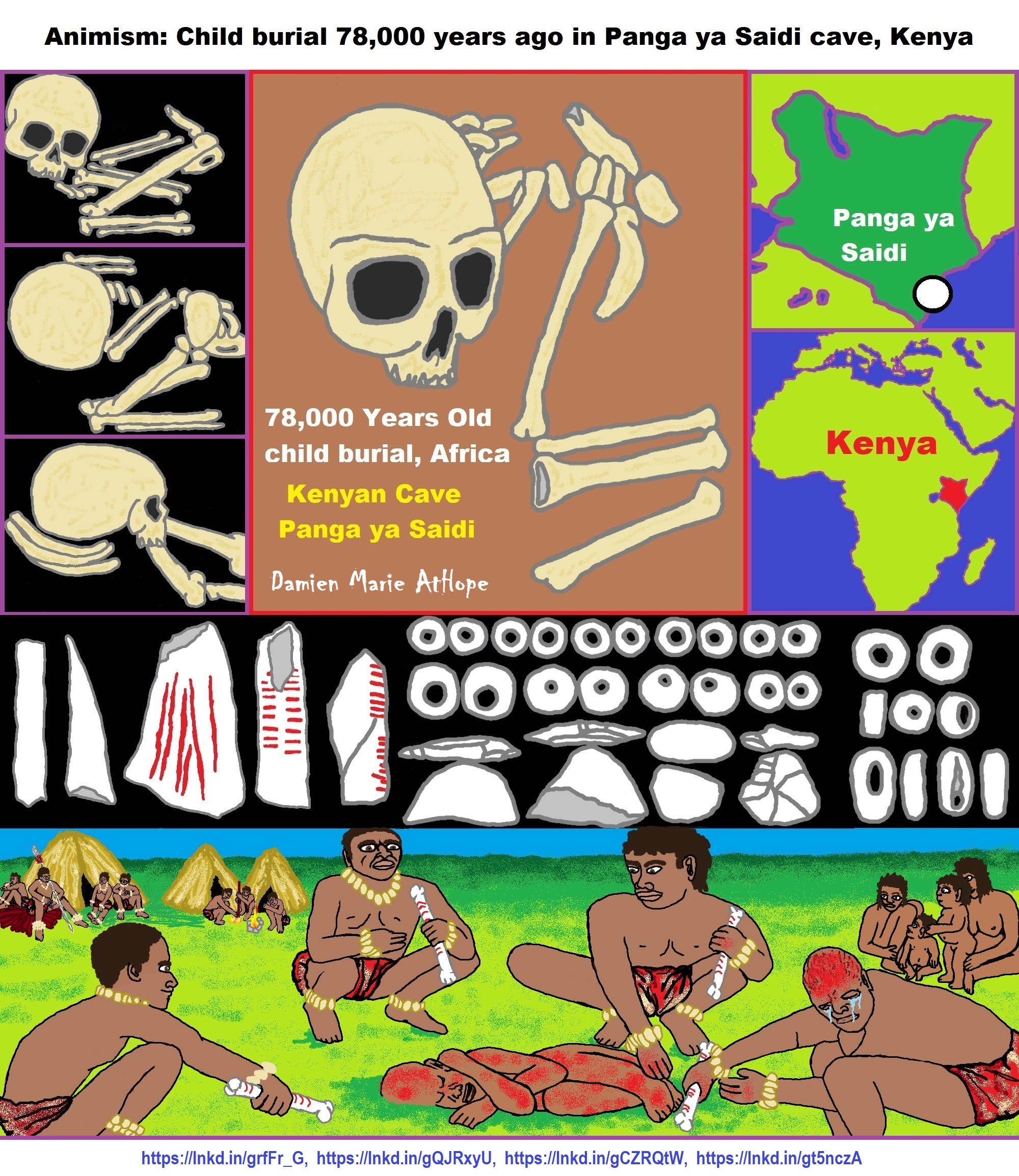
Prehistoric Child Burials Begin at Least Around 78,000 Years Ago
“Mtoto’s burial, to experts it is believed the child was around three years old when they died and was likely wrapped in a shroud and had their head on a pillow. Besides the seemingly deliberate position of the body, the team noticed a few clues that suggested the child was swaddled in cloth, possibly with the intention of preserving the corpse. They also speculate the body was placed in a cave fissure — known as funerary caching — before being covered with sediment.” ref, ref

At Border Cave, a “savanna-woodland” vegetation community is implied before 100,000 years ago and the matching density of stone tools vary considerably through time, with high frequencies of stone blades occurring before 100,000 years ago. ref
Around 74,000 years ago, Border Cave, South Africa, burial of a 4 to 6-month-old child was found in a pit with a personal ornament, a perforated Conus shell. ref
Border Cave is the only African site covering a time span of 250,000 years, with Middle Stone Age human remains, and also records the first emergence of key cultural innovation such as things like grass bedding dated between 70,000 to 30,000 years ago. ref
In South Africa, some of the oldest beads are made of marine shells that come from the Still Bay layers of Blombos Cave date back to around 72,000 years ago, and engraved ostrich eggshell dated to around 60,000 years ago from Diepkloof in South Africa. Some of the oldest beads made of non-marine shells involve ostrich eggshells and from Border Cave, there are some that date to around 42,000 years ago. Beads were also collected from the late MSA/early LSA context of similar age at Apollo 11 and from layers associated with MSA at Boomplaas Cave. Furthermore, beads were also reported from the MSA at Cave of Hearths. Other sub-contemporaneous beads have been recovered north of South Africa. ref
The pulses of occupation seem to have occurred between about 200,000 to 38,000 years ago, with Middle Stone Age 1 Polokwane/Pietersburg industries accumulated between 227,000 to 77,000 years ago, Middle Stone Age 2 Howiesons Poort between 74 and 60 kya, Middle Stone Age 3 post-Howiesons Poort between 60 and 39 kya, and Early Later Stone Age after about 39,000 years ago. ref
Pietersburg has been identified at sites such as:
Besides Cave of Hearths, Bushman Rock Shelter, Mwulu’s Cave, Olieboomspoort Shelter, Rainbow Cave, and several others, which suggests this stone tool tradition may represent a regional expression occurring in the interior of South Africa, south of the Limpopo River. Pietersburg is seen first at the Bushman Rock Shelter on the north-eastern fringe of the Drakensberg mountain range, in the Limpopo Province which could possibly tell us something about population movements, with dates from 97,000-75,000 years ago to 91,000- 73,000 years ago. ref
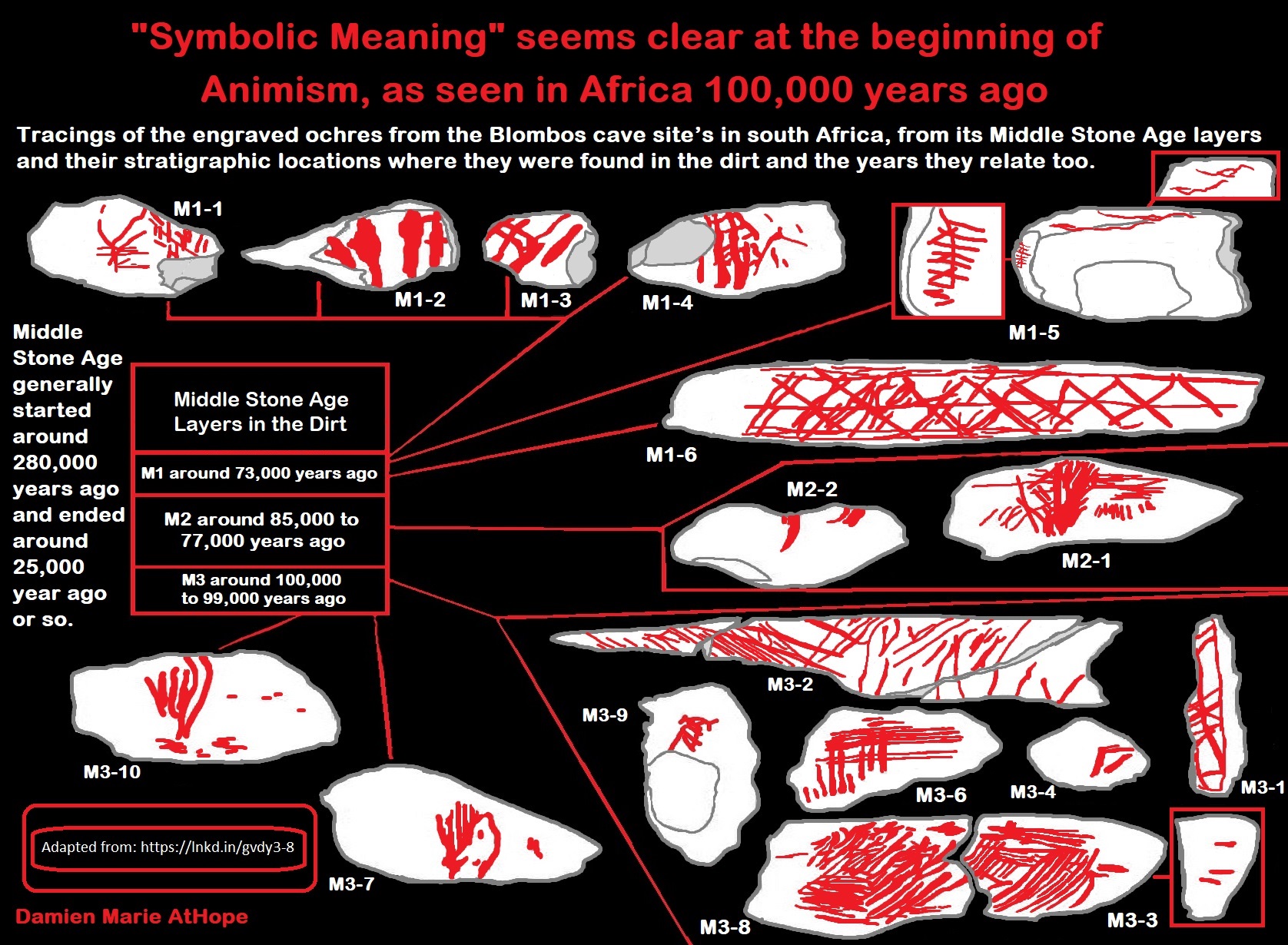
Adapted from: ref
“Here we see the tracings of the engraved ochres from the Blombos cave site’s in South Africa, from its Middle Stone Age layers and their stratigraphic locations where they were found in the dirt and the years they relate to. M1 dates to around 73,000 years ago, M2 around 85,000 to 77,000 years ago, and M3 dates to around 100,000 to 99,000 years ago. Middle Stone Age generally started around 280,000 years ago and ended around 25,000 years ago or so. Therefore, amazing as it is, here we have proof that “Symbolic Meaning,” seems to be clear at the beginning of Animism, as seen in Africa 100,000 years ago. In a landmark study, it was demonstrated, for the first time, that there are seeming tradition in the production of geometric engraved representations, includes the production of a number of different patterns and this set of evolving traditions have roots that go back in time to at least 100,000 years ago (around a time I say Animism begins in Africa). The fact that they were created, that most of them are deliberate and were made with representational intent, strongly suggests they functioned as artifacts within a society by symbols with meaning. ref
Neanderthals had complex social structures including burying their dead (concept of an afterlife) and wearing personal ornaments (eagle claws and shell beads) and used pigments like red ocher and feathers too. Both Neanderthals and Modern Humans were similar in relation to aggression or to fight each other and with a comparison of more than 200 skulls dating back 80,000 years found similar levels of head injuries in both groups, Neanderthals and Modern Humans suggesting a similar lifestyle. They were more likely to hunt demonstrated in how it is the males in both groups who displayed greater injuries due to role stratification, with gender-specific behaviors and activities. The only difference discovered was the age of the injuries – with greater skull wounds among young Neanderthals under 30. It is possible that such injuries on young Neanderthals are thought to be concentrated on the head resulting from violent social behavior, front teeth of Neanderthals often show heavy wear, even in young (teeth vice to hold skins or objects) though growing evidence in general shows that Neanderthals had much in common with early human groups. ref, ref
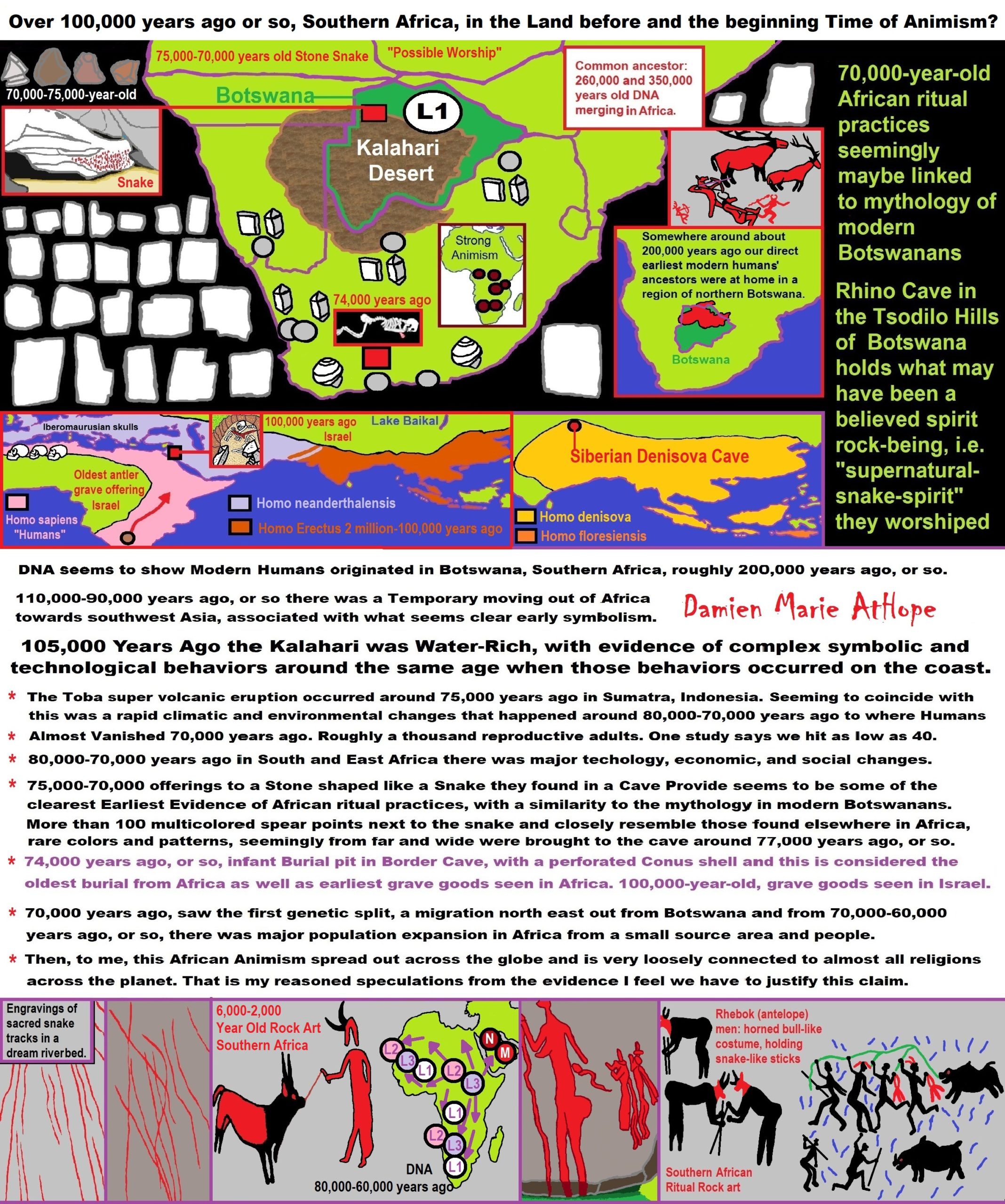
ref, ref, ref, ref, ref, ref, ref, ref, ref, ref, ref, ref, ref, ref, ref, ref, ref, ref, ref, ref, ref, ref, ref, ref, ref, ref, ref, ref, ref, ref, ref, ref, ref, ref, ref, ref, ref, ref, ref, ref, ref, ref, ref, ref, ref, ref, ref, ref, ref, ref, ref, ref, ref
Animism: a belief among some indigenous people, young children, or all religious people!
Over 100,000 years ago or so, Southern Africa, in the Land before and the beginning Time of Animism: LINK
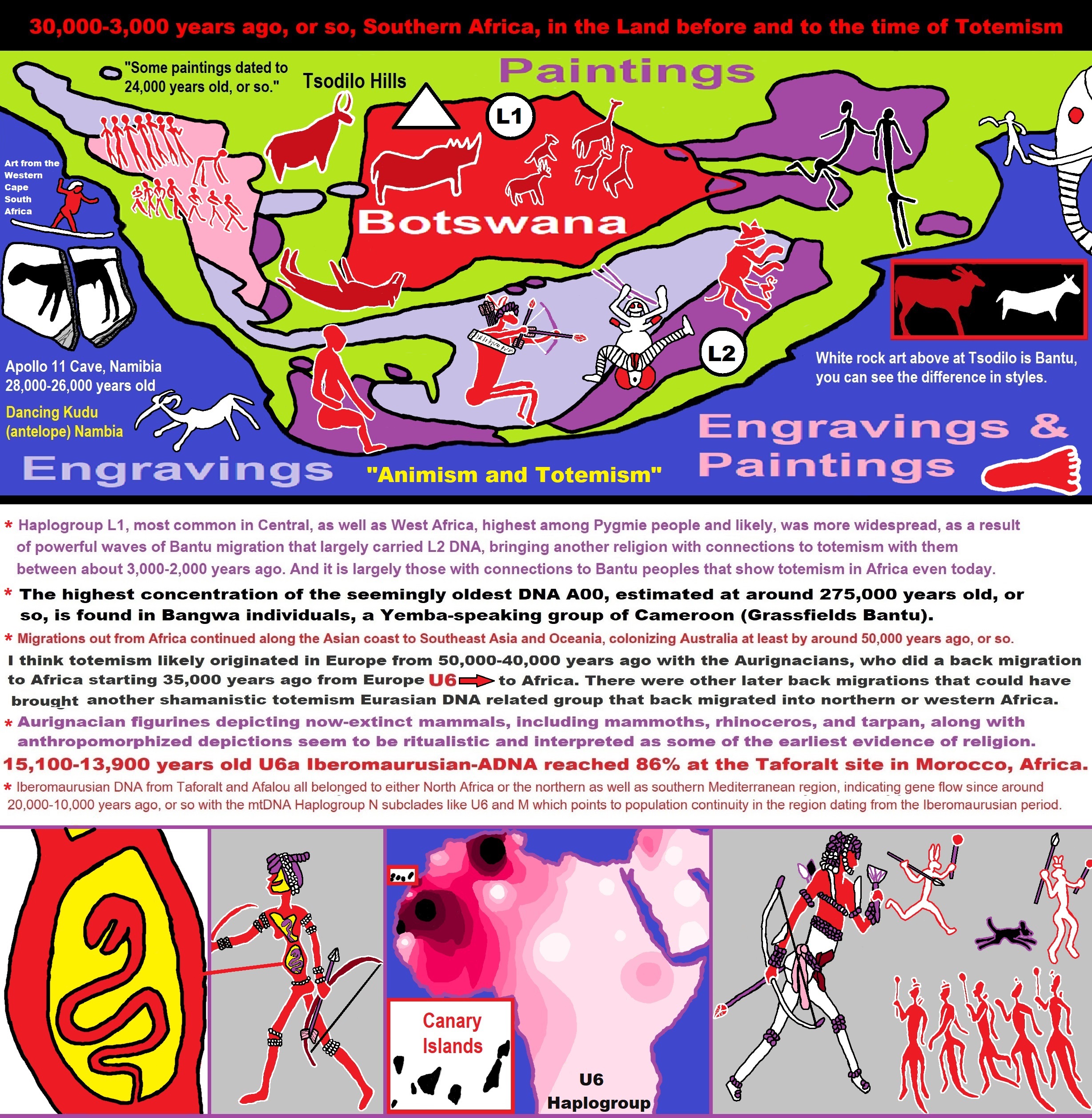
ref, ref, ref, ref, ref, ref, ref, ref, ref, ref, ref, ref, ref, ref, ref, ref, ref, ref, ref, ref, ref, ref, ref, ref, ref, ref, ref, ref, ref, ref, ref, ref, ref, ref, ref, ref, ref, ref, ref, ref, ref, ref, ref, ref, ref, ref, ref, ref, ref, ref, ref, ref, ref, ref, ref, ref, ref, ref, ref, ref, ref, ref
Explaining the Earliest Religious Expression, that of Animism (beginning 100,000 to 70,000 years ago?) to Totemism (beginning 30,000 to 3,000 years ago?) in Southern Africa: LINK
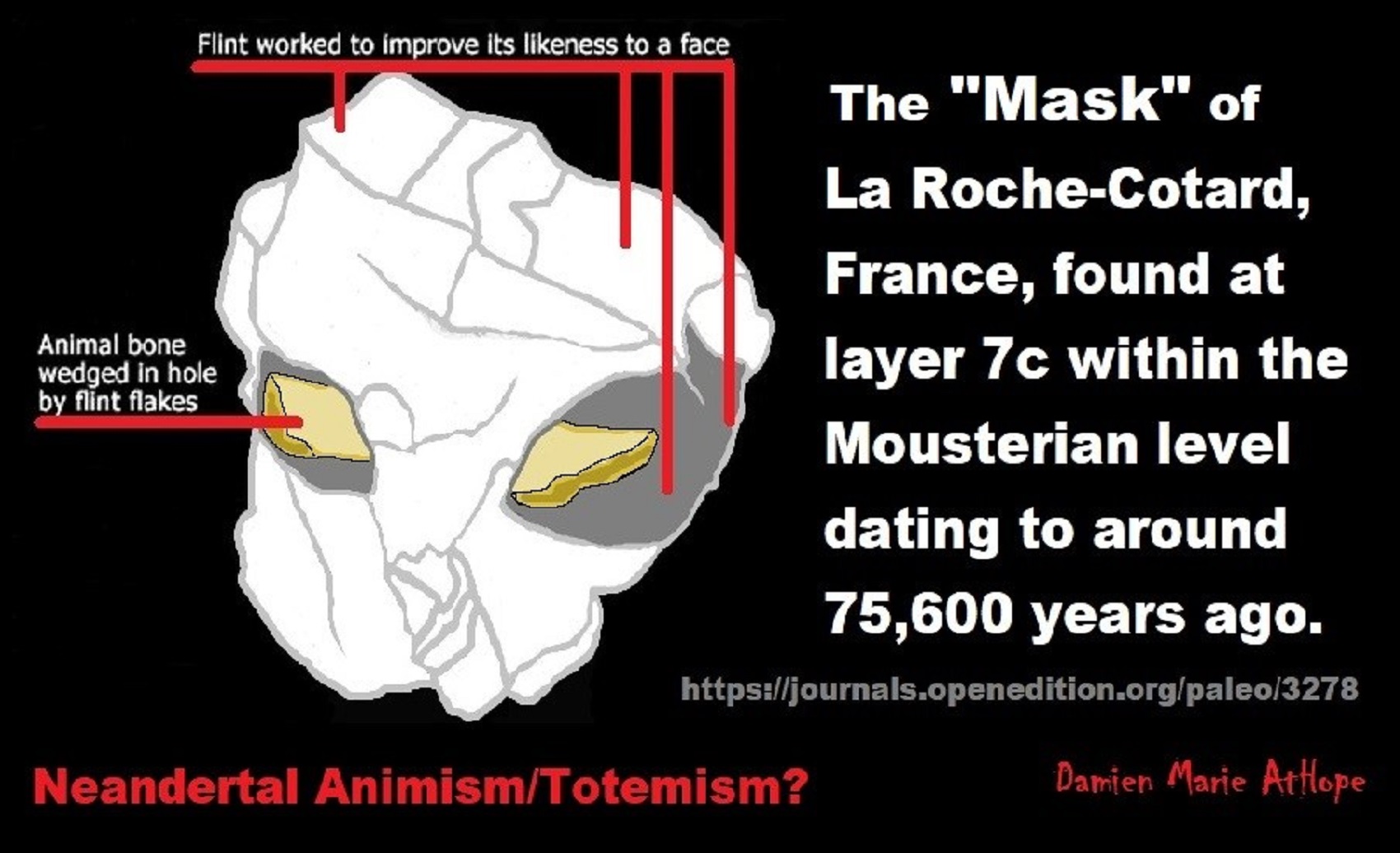
The “Mask” of La Roche-Cotard, France, found at layer 7c within the Mousterian level dating to around 75,600 years ago. This is a flint object with a striking likeness to a human face may be one of the best examples of art by Neanderthals ever found ref, ref
A Few Mousterian Sites
- Levant: Israel: Qafzeh, Skhul, Kebara, Hayonim, Tabun, Emeireh, Amud, Zuttiyeh, El-Wad; Jordan: ‘Ain Difla; and Syria: El Kowm
- North Africa: Morocco: Rhafas Cave, Dar es Soltan
- Central Asia: Turkey: Kalatepe Deresi; Afghanistan: Darra-i-Kur; and Uzbekistan: Teschik-Tasch
- Europe: Gibraltar: Gorhams Cave; France: Abric Romani, St. Cesaire, Grotte du Noistier; Spain: L’Arbreda Cave; Siberia: Denisova Cave; Ukraine: Moldova Sites; and Croatia: Vindija Cave. ref
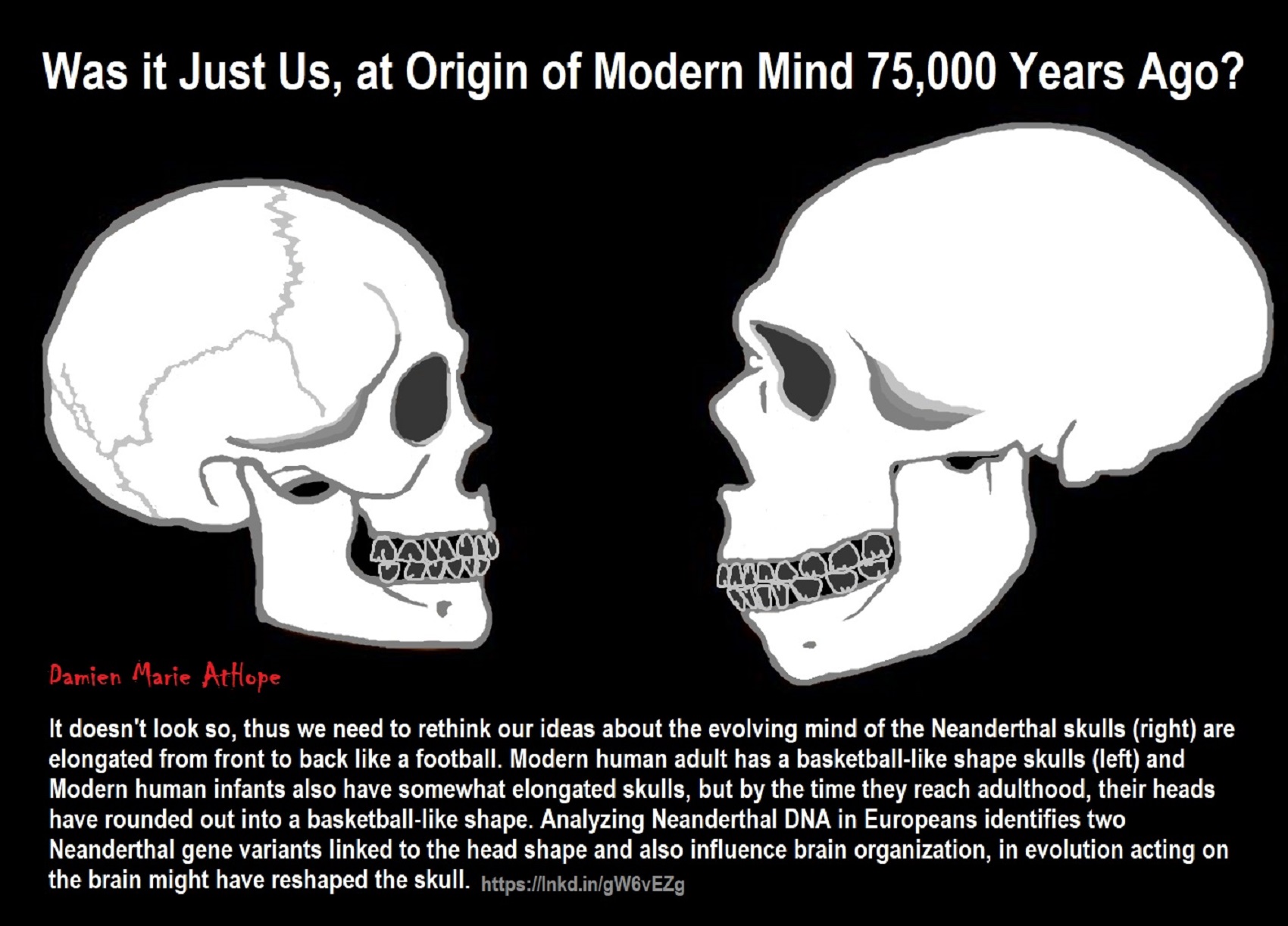
Was it Just Us, at Origin of Modern Mind 75,000 Years Ago?
The oldest skulls of early modern (arcane) humans, dating back 300,000 years, with elongated brains that were more like those of Neanderthals than Modern humans. However, the Skulls from Modern humans dating about 120,000 years ago show that brains had gotten somewhat rounder by then, but were still outside the range observed in people today. ref
It doesn’t look so, thus we need to rethink our ideas about the evolving mind of the Neanderthal skulls (right) are elongated from front to back like a football. Modern human adult has a basketball-like shape skulls (left) and Modern human infants also have somewhat elongated skulls, but by the time they reach adulthood, their heads have rounded out into a basketball-like shape. Analyzing Neanderthal DNA in Europeans identifies two Neanderthal gene variants linked to the head shape and also influence brain organization, in evolution acting on the brain might have reshaped the skull. Therefore, the Neanderthal DNA had a direct effect on brain shape and, presumably, brain function in humans today but infants start life with elongated skulls, somewhat like Neanderthals. ref
Evidence shows that Neanderthals had a complex culture although they did not behave in the same ways as the early modern humans who lived at the same time. Neanderthal dead were often buried, although there is no conclusive evidence for full ritualistic behavior, though at some sites, objects have been uncovered that may represent grave goods. ref
Neanderoid neurons also make fewer synaptic connections, creating what resembles an abnormal neuronal network which is somewhat similar to neuronal development in the brains of individuals with autism. Modern humans, with these types of changes are linked to defects in brain development that are needed for socialization, probably demonstrating why Neanderthals had smaller family clans than the larger groups that Modern humans. ref
Neanderthal skulls demonstrate that they were not short on brains with brains that were as big as ours and commonly even bigger though their brains did not mimic ours. Before they disappeared about 40,000 years ago, Neanderthals left behind signs of sophistication: spears used to hunt big game, for instance, and jewelry made of shells and eagle talons. ref
Neanderthals also increased in brain size through their evolution, but in different ways to Modern humans, relatively better vision. And by 150,000 years ago, both Neanderthals and early modern humans had brains about three times larger than chimpanzees, our closest modern (arcane) humans. ref
Early modern humans had relatively larger cerebellar hemispheres but a smaller occidental region in the cerebrum than Neanderthals long before the time that Neanderthals disappeared. And abilities such as cognitive flexibility, attention, the language processing, episodic and working memory capacity were positively correlated with size-adjusted cerebellar volume. ref
Origin of Modern Mind 75,000 Years Ago
South African around the Middle Stone Age cultural periods known as Still Bay techno-tradition (75,000-71,000 years ago) and Howiesons Poort techno-tradition (65,000-59,000 years ago), and establishes the region as the primary center for the early development of human behavior. In these periods of many innovations including, for example, the first abstract art (engraved ochre and engraved ostrich eggshell); the first jewelry (shell beads); the first bone tools; the earliest use of the pressure flaking technique, that was used in combination with heating to make stone spear points and the first probable use of stone tipped arrows launched by bow. ref
Lastly, Neanderthals may not have used their brains they way modern humans do as modern human brains have expanded parietal and cerebellar regions which develop in the first year of life (Neanderthal infants appear to miss this stage of development) and are linked to key functions like the ability to integrate sensory information and form abstract representations of surroundings. ref
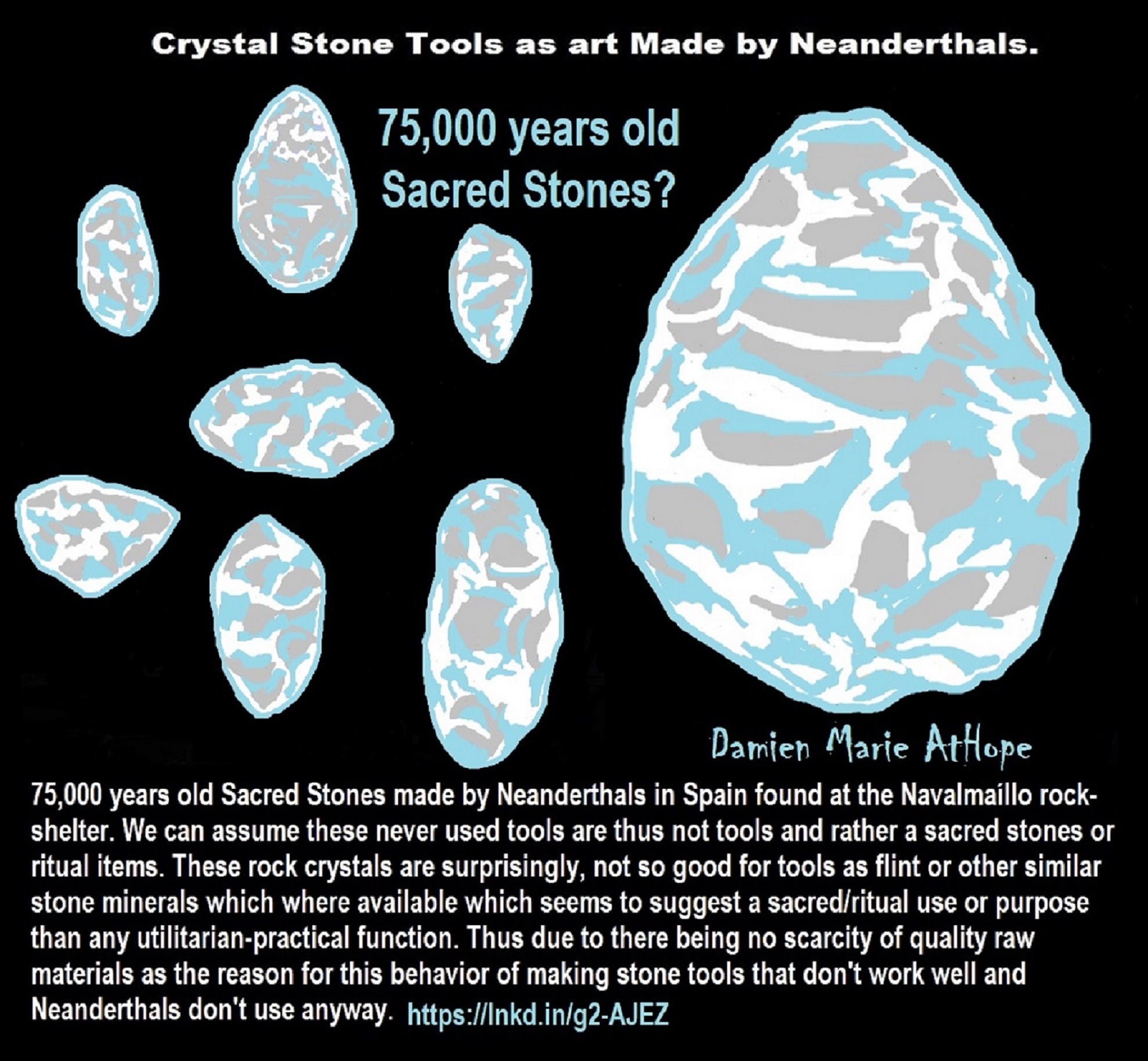
Rock crystal stone tools 75,000 Years Ago – (Spain) made by Neanderthals
75,000 Years Ago – (Spain), found evidence of rock crystal stone tools made by Neanderthals in Navalmaíllo rock-shelter Pinilla del Valle, Madrid, Spain. We can assume these never used tools are thus not tools and rather sacred stones or ritual items. These rock crystals are surprisingly, not so good for tools as flint or other similar stone minerals which were available which seem to suggest a sacred/ritual use or purpose than any utilitarian-practical function. Thus, due to there being no scarcity of quality raw materials, the reason for this behavior, of making stone tools that don’t work well and Neanderthals don’t use anyway expresses a sacred item. Moreover, the cores found at the Navalmaíllo site intentionally worked to a very small size and are also reported for other European stone tool cultural assemblages of similar age. Quartz cobbles are also common locally, but this material was usually avoided during the Middle Paleolithic period going back around 100,000 years ago until these were made. The few exceptions are always in rock shelters or caves. The best known are Jarama VI cave and Peña Capón rock shelter in central spain.
This use of rock crystal or quartz also is seen in Europe such as in southwestern France such as at the Les Merveilles rock shelter. At prehistoric sites in the Austrian alps, quartz or quartzite was generally used very frequently as raw material for stone tools, about 68 % of the stone tool artifacts from Repolusthöhle (Repolust), Austria was made of quartzite. More than 99 % of the lithic artifacts from the Drachenhöhle (Dragon’s Cave), Austria were made of quartz or quartzite and about 90 % of the artifacts from the Tunnelsteinhöhle, Austria were made of quartz. This is evidence of the collection by Neanderthals of highly crafted objects of no great use, except for their beauty or specialness possibly ritual as seems odd it was only seen as a standard tool. Thus, a use-wear analysis was done to prove that quartz artifacts really were regarded as tools which it seems they may not have been.
This further highlights a possible ritualism because there seems to be a low frequency of mechanical damage on the quartz artifacts. However, evidence of quartz tools goes back 500,000 years ago as numerous pieces of quartz crystal found with remains of ‘Peking Man’ and some fragments of white quartz in tabus, a mineral not native to the area raises the importance of this find. In fact, more than 10,000 stone tools have been recovered coming from 44 different raw materials used by the ancient inhabitants of the cave, and 89% of this raw material is quartz and the remainder of the raw materials used includes 5% rock crystal. 1, 2, 3, 4, 5, 6
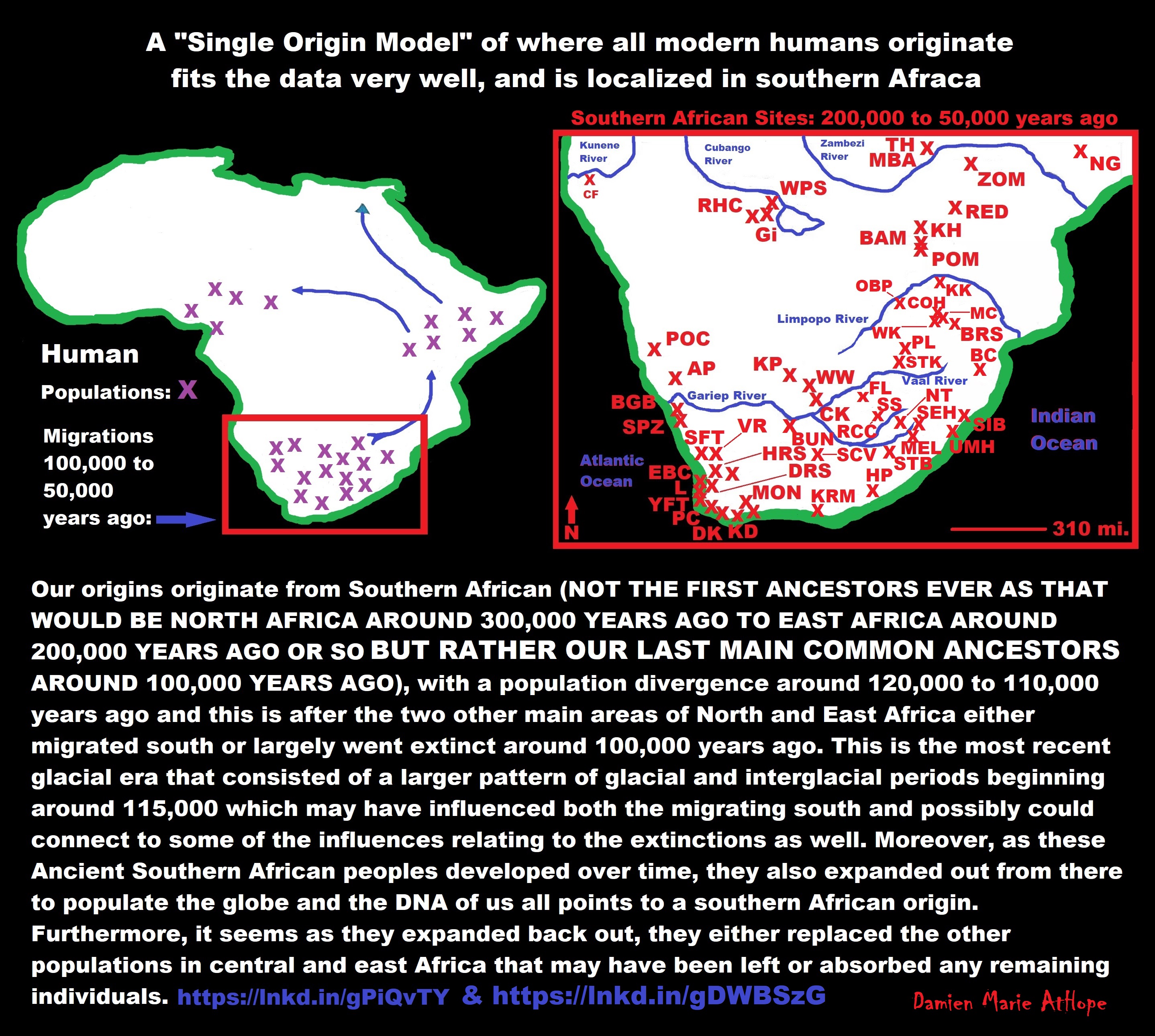
Our origins originate from Southern African (NOT THE FIRST ANCESTORS EVER AS THAT WOULD BE NORTH AFRICA AROUND 300,000 YEARS AGO TO EAST AFRICA AROUND 200,000 YEARS AGO OR SO BUT RATHER OUR LAST MAIN COMMON ANCESTORS AROUND 100,000 YEARS AGO), with a population divergence around 120,000 to 110,000 years ago and this is after the two other main areas of North and East Africa either migrated south or largely went extinct around 100,000 years ago. This is the most recent glacial era that consisted of a larger pattern of glacial and interglacial periods beginning around 115,000 which may have influenced both the migrating south and possibly could connect to some of the influences relating to the extinctions as well. Moreover, as these Ancient Southern African peoples developed over time, they also expanded out from there to populate the globe, and the DNA of us all points to a southern African origin. Furthermore, it seems as they expanded back out, they either replaced the other populations in central and east Africa that may have been left or absorbed any remaining individuals. ref
Southern African Middle Stone Age sites:
(Ap) Apollo 11; (BAM) Bambata; (BBC) Blombos Cave; (BC) Border Cave; (BGB)Boegoeberg; (BPA) Boomplaas; (BRS) Bushman Rock Shelter; (BUN) Bundu Farm; (CF)Cufema Reach; (CK) Canteen Kopje; (COH) Cave of Hearths; (CSB) Cape St Blaize; (DK)Die Kelders Cave 1; (DRS) Diepkloof Rock Shelter; (EBC) Elands Bay Cave; (FL) Florisbad; (≠GI) ≠Gi; (HP) Howiesons Poort; (HRS) Hollow Rock Shelter; (KD) Klipdrift; (KKH) Klein Kliphuis; (KH) Khami; (KK) Kudu Koppie; (KP) Kathu Pan; (KRM) Klasies River Main Site; (L) Langebaan; (MBA) Mumbwa Caves; (MC) Mwulu’s Cave; (MEL)Melikane; (MON) Montagu Cave; (NBC) Nelson Bay Cave; (NG) Ngalue; (NT) Ntloana Tšoana; (OBP) Olieboomspoort; (PC) Peers Cave; (POC) Pockenbank; (PL) Plover’s Lake; (POM) Pomongwe; (PP) Pinnacle Point; (RCC) Rose Cottage Cave; (RED) Redcliff; (RHC) Rhino Cave; (SCV) Seacow Valley; (SFT) Soutfontein; (SEH) Sehonghong; (SIB)Sibudu Cave; (SPZ) Spitzkloof Rock Shelter; (SS) Sunnyside 1; (STB) Strathalan Cave B; (STK) Sterkfontein; (TR) Twin Rivers; (UMH) Umhlatuzana; (VR) Varsche Rivier 003; (WPS) White Paintings Shelter; (WK) Wonderkrater; (WW) Wonderwerk; (YFT)Ysterfontein 1; (ZOM) Zombepata Cave. ref
Africa’s Middle Stone Age is best known for innovations that appearing various times after about 200,000 years ago. Such innovations might have been linked to new types of social behavior as well as pulses in movements within and out of the continent of Africa. Population shifts likely occurred repeatedly during the 200,000 to 50,000 years ago. Southern African sites seem concentrated in the interior of the subcontinent before 130,000 years ago seemingly coinciding with the dispersal after 130,000 years ago of populations from the interior to mountainous areas, but, more particularly, to the coastal stretches of the southern and western Cape. Then by around 58,000 years ago occupations tended once more to shift away from the southern coast and back into the interior, or to the eastern seaboard. Regional and even local variability is characteristic of stone artifacts of the time, while sites seem to have fewer ornaments or decorated items than was formerly the case. ref
100,000 – 50,000 Years Ago – Signs of increased ritual or symbolic use of red ochre at several sites. Red ochre is a common
90,000 Years Ago – (Africa), found evidence of humans making symbolic paintings and ritual or symbolic uses involving red ochre. Neanderthals living in Europe and the Near East at this time were also involved in a ritual or symbolic use of red ochre as well as what seems like early religion possibly involving animal totems, such as the cave bear cult and what may have been a death cult involving several Neanderthal cave sites burials in fetal positions frequently stained with red ochre which must have had a sacred quality of some kind connected to its use. ref, ref, ref, ref
86,000 – 24,500 Years Ago – Found evidence that Neanderthals (distinct species from humans) and modern humans inbreed exchanging genes and likely shared technology and religious ideas too. 40,000 – 30,000 years ago, in northern Italy, remains are believed to be that of a Neanderthal-Modern Human hybrid. Moreover, 24,500 years ago, another burial of a juvenile Neanderthal-Modern Human hybrid (the Lapedo child) from central Portugal who’s burial involved red ochre and bones of red deer. All non-Africans today have Neanderthal gene fragments in their genetic codes. This is important because of the seeming Neanderthals shared some religious practice of using red ochre with religious and afterlife symbolism with modern humans and the s likely shared more than genes but also could have shared religious ideas too. Similar and more interesting are the non-humans inbreeding with Denisovans and most likely spreading other things such as sacralizing, ritualizing, and supernatural beliefs too but as of yet there is just my speculation. Denisovans, a cousin to Neanderthals, lived in Asia from roughly 400,000 to possibly 30,000 years ago and also interbred with both Neanderthals and modern humans, with their DNA spreading from the Altai Mountains in Central Asia, where Russia, China, Mongolia, and Kazakhstan come together all the way to Papua New Guinea. A DNA analysis from Papua New Guinea shows they hold 4.8% Denisovan DNA. Moreover, by 26,000 years ago, almost all diversity of the hominids vanished and humans everywhere had evolved into the anatomically and behaviorally to roughly the modern form we know today. ref, ref, ref, ref, ref, ref, ref, ref, ref

Stone Snake of South Africa: “first human worship” 70,000 years ago
Art above by Damien Marie AtHope
Evidence from Rhino Cave, in Botswana, produced results that revealed a very special set of behavioral patterns which best fit ritualized behavior. There were colorful non-local stone tools carefully and often elaborately made just to be offered to the stone snake; burned and smashed beyond use then abandoned. ref
Ritualized Behavior in the Middle Stone Age: Evidence from Rhino Cave, Tsodilo Hills, Botswana
ABSTRACT
Rhino Cave, located at the World Heritage site of Tsodilo Hills, is one of the three main Middle Stone Age (MSA) sites in Botswana. Initial investigations during the mid-1990s left unanswered a number of key questions regarding the early use of the cave. This prompted the current investigations, which have unearthed a wealth of MSA artifacts from a lag deposit. Results of a selectively employed chaîne opératoire analysis have revealed a very special set of behavioral patterns. It will be argued that the best-fit interpretation of the results from this investigation lies within the realm of ritualized behavior. The assemblage is characterized by an unexpectedly large number of MSA points, which are for the most part produced in non-locally acquired raw materials. These points are colorful, carefully and often elaborately made, and, once complete, never left the cave. They were either deliberately burned to the point where they could no longer be used, abandoned, or intentionally smashed. These artifacts were found together with tabular grinding slabs and pieces of the locally available pigment, specularite. This assemblage was recovered directly beneath a massive, virtually free-standing rock face that has been carved with hundreds of cupules of varying sizes and shapes. A section of the carved rock face was recovered from well within the MSA deposits in association with handheld grinding stones. ref
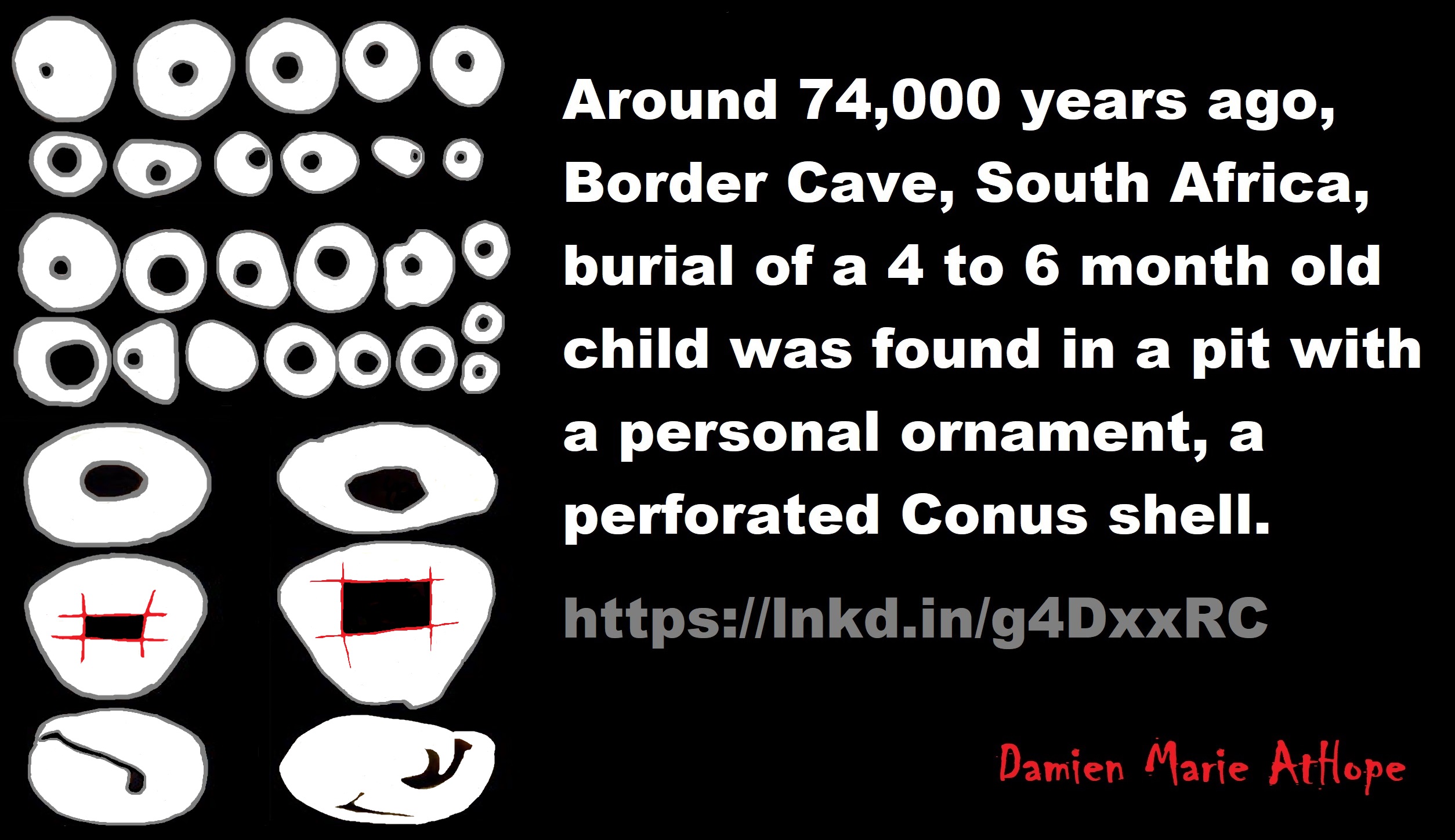
Around 74,000 years ago, in Border Cave, South Africa, the burial of a 4 to
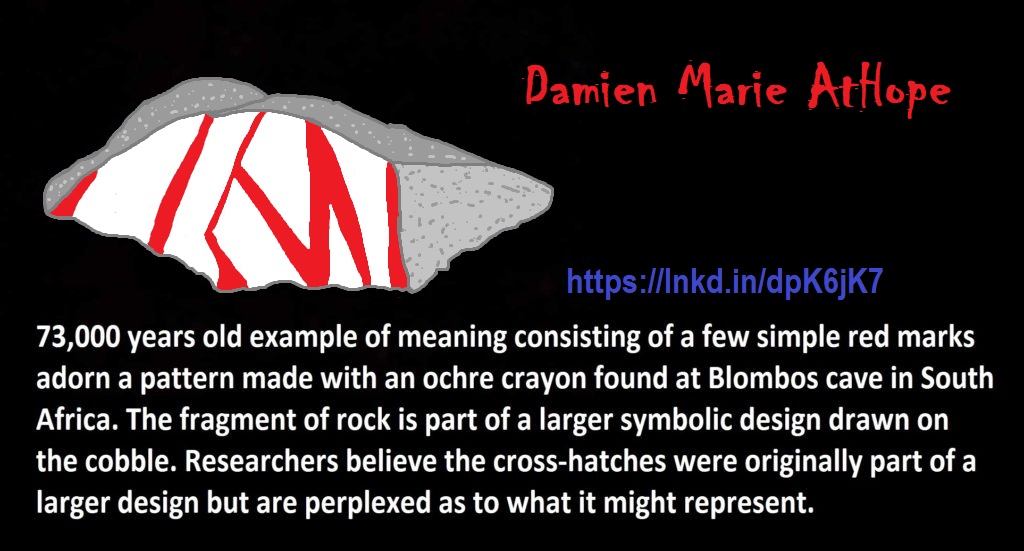
73,000 years old example of meaning consisting of a few simple red marks adorn a pattern made with an ochre crayon found at Blombos cave in South Africa. The fragment of rock is part of a larger symbolic design drawn on the cobble. Researchers believe the cross-hatches were originally part of a larger design but are perplexed as to what it might represent. ref
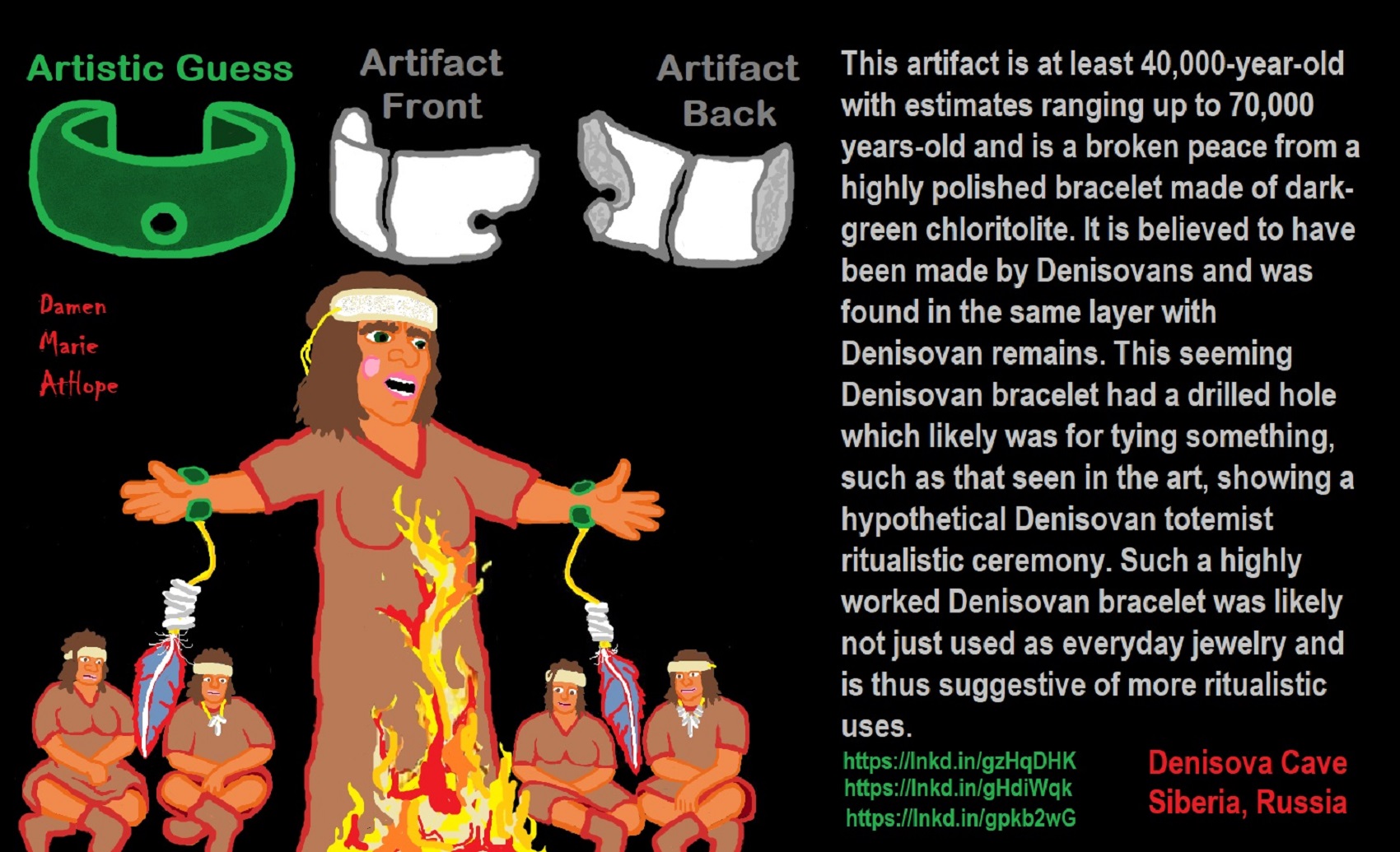
“This is the oldest stone bracelet in the world, believed to have been made by the extinct Denisovan species of early humans, dated as being between 40,000 – 50,000 to be 65,000 – 70,000 years old, long before ancient people were believed to capable of making such remarkable objects. The bracelet is thought to have adorned a very important woman or child on only special occasions. And it is unlikely it was used as an everyday jewellery piece. I believe this beautiful and very fragile bracelet was worn only for some exceptional moments.” ref

“What About Neanderthals and Religion?”
Scientists have found the first major evidence that Neanderthals made cave paintings, indicating they may have had an artistic sense similar to our own. A new study led by the University of Southampton and the Max Planck Institute for Evolutionary Anthropology shows that paintings in three caves in Spain were created more than 64,000 years ago – 20,000 years before modern humans arrived in Europe. This means that the Palaeolithic (Ice Age) cave art – including pictures of animals, dots, and geometric signs – must have been made by Neanderthals, a ‘sister’ species to Homo sapiens, and Europe’s sole human inhabitants at the time. It also indicates that they may have had a similar artistic sense, in terms of thinking symbolically, to modern humans. ref
Published in the journal Science, the study reveals how an international team of scientists used a state-of-the-art technique called uranium-thorium dating to fix the age of the paintings as more than 64,000 years. Until now, cave art has been attributed entirely to modern humans, as claims to a possible Neanderthal origin have been hampered by imprecise dating techniques. However, uranium-thorium dating provides much more reliable results than methods such as radiocarbon dating, which can give false age estimates. Results show that the paintings we dated are, by far, the oldest known cave art in the world, and were created at least 20,000 years before modern humans arrived in Europe from Africa so it is assumed – therefore they may have been painted by Neanderthals. ref
All three caves contain red (ochre) or black paintings of groups of animals, dots, and geometric signs, as well as hand stencils, handprints, and engravings. According to the researchers, creating the art must have involved such sophisticated behavior as the choice of a location, planning of light source, and mixing of pigments. There is evidence that Neanderthals in Europe used body ornamentation around 40,000 to 45,000 years ago, but many researchers have suggested this was inspired by modern humans who at the time had just arrived in Europe. Study co-author Paul Pettitt, of Durham University, commented: “Neanderthals created meaningful symbols in meaningful places. The art is not a one-off accident. ref
Neanderthals are our closest extinct relative, but for a long time, they had a reputation for being pretty backward. Early modern humans, for example, made cave paintings. But even though Neanderthals used pigments and decorated themselves with eagle claws and shells, there was no clear proof that they painted caves. One theory goes that Neanderthals developed their rudimentary culture only after early modern humans arrived in Europe some 40,000 to 50,000 years ago. The most recent painting is at least 64,800 years old, according to this technique, and the oldest is more than 66,000 years old. ref
The Neanderthal was the only proven Human of Europe at the time, but was his or her brain up to the job? Or did modern humans reach Europe tens of thousands of years earlier than thought? The ancient art forms are symbolic but not figurative, explain their finders. In Spain, a cave in Maltravieso features hand stencils more than 66,000 years old, Prof. Dirk Hoffmann of the Max Planck Institute for Evolutionary Anthropology and others report in their paper, published in Science. The La Pasiega Cave in Cantabria features a ladder form composed of red horizontal and vertical lines that were created more than 64,000 years ago, they say. Further supporting the Neanderthal-as-artist theory, a related paper published Thursday in Science Advances reports that dyed and decorated seashells found in a Spanish cave dated to more than 115,000 years ago. ref
Perforated shells found in sediments in Cueva de los Aviones that date to between 115,000 and 120,000 years. There’s no argument that there were Neanderthals in Europe 64,000 years ago. Homo sapiens, on the other hand, was thought to have reached Europe only 45,000 to 40,000 years ago. There is no evidence for modern humans in Iberia before 41,000 years ago, and there is evidence for Neanderthal presence until about 36,000 years ago in southern Spain and Portugal. Neanderthals existed for twice the time modern people have, if not more, and were once the dominant hominin in Europe. While Neanderthals may have etched a crisscross and perhaps carved a flute, look what Homo sapiens achieved, Coolidge says. The Paleolithic record is replete with exquisite works, from cave paintings to carvings done tens of thousands of years ago – such as the Lion Man sculpture found in a German cave and made of mammoth ivory some 38,000 years ago. ref
Neanderthal ritual or religious practice at around 50,000 years old burial in Sima de las Palomas in Murcia, Southeast Spain of a female covered with rocks inturned with a cut-off panther paw, suggesting that Neanderthals—much like today’s bear hunters—ceremoniously cut off panther paws and kept them as totemistic trophies. This 50,000-year-old Neanderthal burial ground actually includes the remains of at least three individuals intentionally buried, with each Neanderthal’s arms folded such that the hands were close to the head. Remains of other Neanderthals have been found in this position, suggesting that it held meaning. The remains of six to seven other Neanderthals, including one baby and two juveniles, have also been excavated at the site. The tallest individual appears to have been an adult who stood around 5 feet 1 inch tall. ref, ref
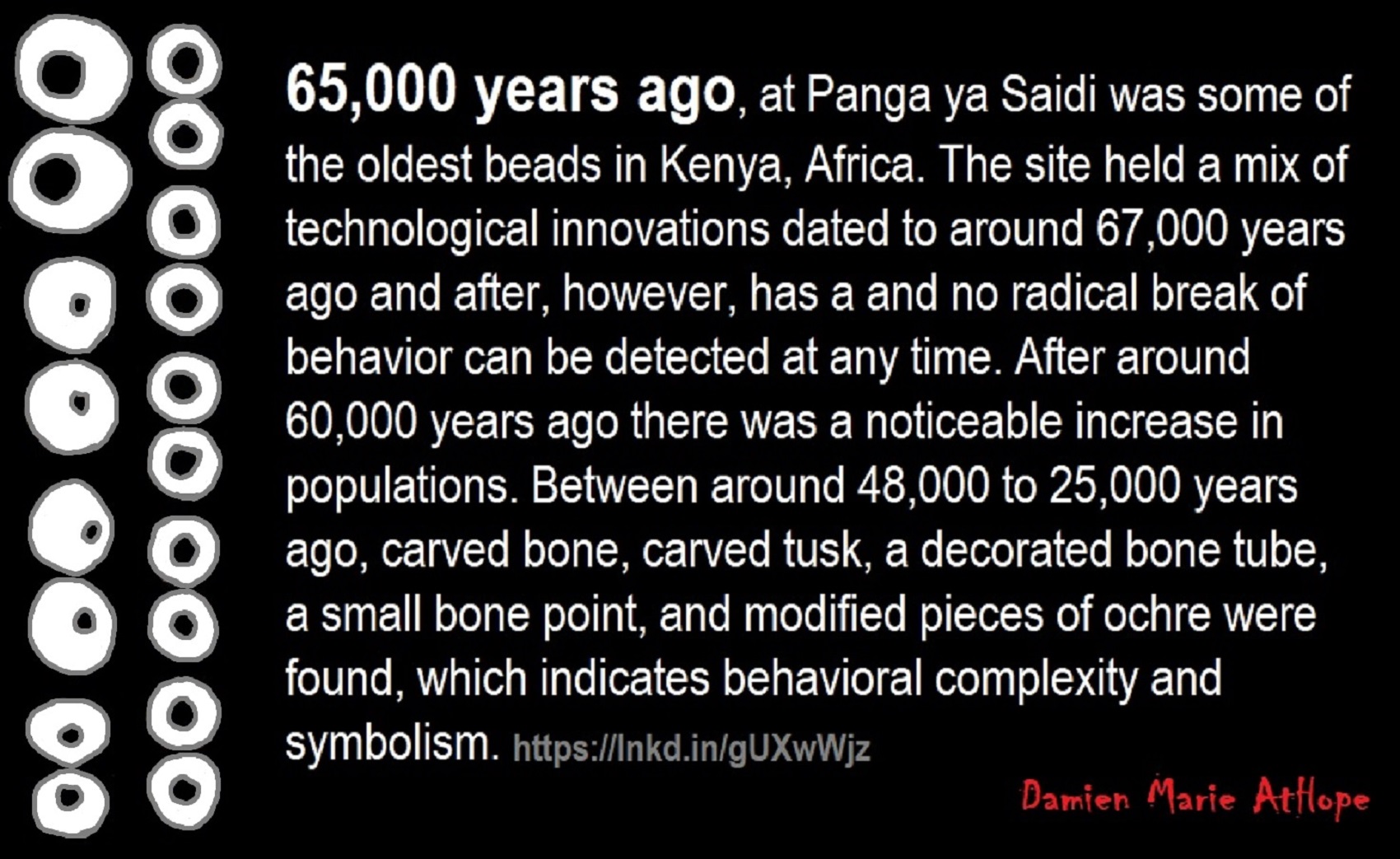
65,000 years ago, at Panga ya Saidi was some of the oldest beads in Kenya, East Africa. The site held a mix of technological innovations dated to around 67,000 years ago and after, however, has a and no radical break of behavior can be detected at any time. After around 60,000 years ago there was a noticeable increase in populations. Between around 48,000 to 25,000 years ago, carved bone, carved tusk, a decorated bone tube, a small bone point, and modified pieces of ochre were found, which indicates behavioral complexity and symbolism. ref

60,000 years old fragments of engraved ostrich eggshells from the Diepkloof Rock Shelter, Western Cape, South Africa.
Symbolic meaning expressed in art or designs and patterns, starting with animism at 100,000 years ago and more so around 50,000 years ago with the emergence of totemism and shamanism 30,000 years ago which I think all connect in a general way to religious thinking or mindsets that create the art or patterns and are not only a much older phenomenon than previously thought and has its roots in the African continent. Such early symbolic expression is seen in things like personal ornamentation and engraved designs, traditions that go far back into African prehistory. The patterns are symbolic and could have been used to express religious clan connections, group relations, or personal expression. The patterns may indeed have
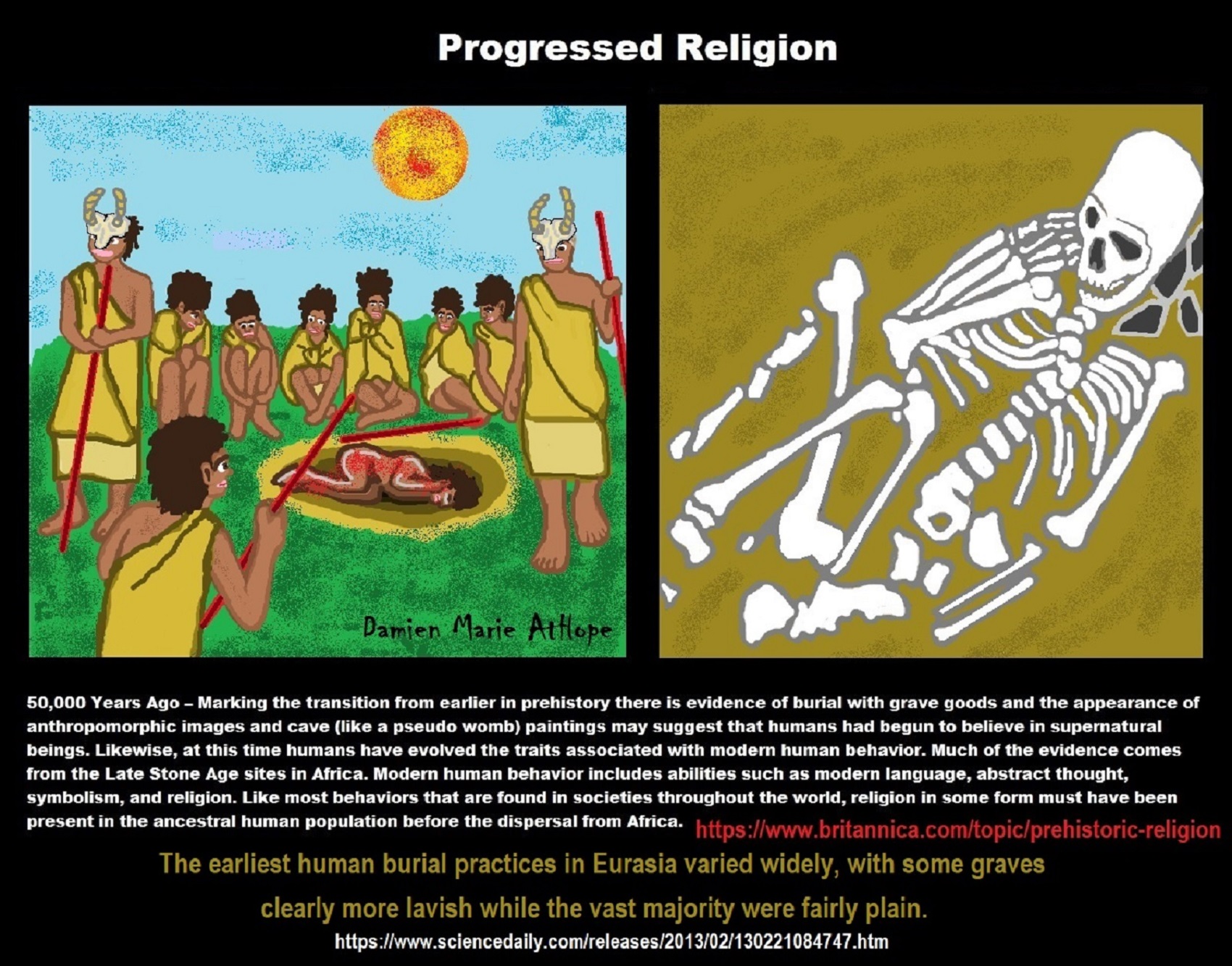
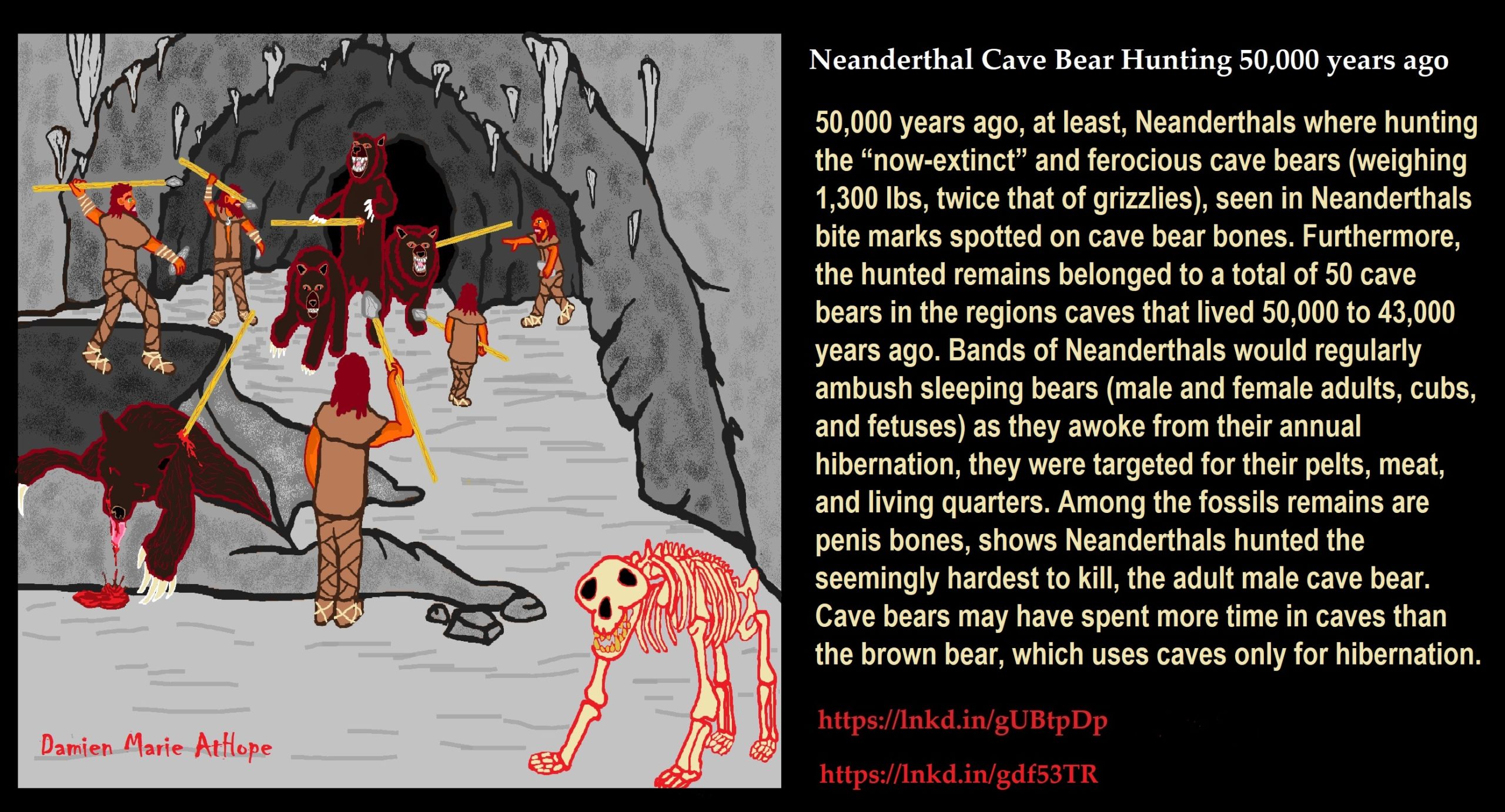
Cave Bear Hunting by Neanderthals 50,000 years ago
50,000 years ago, at least, Neanderthals were hunting the “now-extinct” and ferocious cave bears (weighing 1,300 lbs, twice that of grizzlies), seen in Neanderthals’ bite marks spotted on cave bear bones. Furthermore, the remains belonged to a total of 50 cave bears that lived 50,000 to 43,000 years ago. Bands of Neanderthals would regularly ambush sleeping bears (belonging to male and female adults, cubs, and fetuses) as they awoke from their annual targets for their pelts, meat, and living quarters. Among the fossils, remains are penis bones, showing that Neanderthals did hunt the seeming hardest to kill, the adult male cave bear. Cave bears may have spent more time in caves than the brown bear, which uses caves only for hibernation. ref, ref, ref
800 specimens were collected throughout western Eurasia, and dated between 80,000 and 20,000 years ago. The team documented incidents of skull trauma, perceived sex and age at death, degree of skeleton preservation, and geographical location of each sample. Based on 836 cranial elements analyzed from 204 individuals, researchers found no differences in injury rates between Neanderthals and contemporaneous humans, Gizmodo reported. ref, ref
The walls of France’s Chauvet cave, occupied 32,000 years ago, are painted with lions, hyenas, as well as bears, and the floor is covered with 150 cave bear skeletons. Most dramatically, a cave bear skull was perched on a stone slab in the center of one chamber, placed deliberately, possibly the skull was put on the rock evoking a religious significance. ref
Neandertals seem to have possibly had an ancient bear cult in Western Eurasia during the Middle Paleolithic and it is well documented that bears feature often on many totems throughout northern cultures that carve them. Neanderthals would have worshiped the cave bear discovered in several different caves and the not mere presence of bones but their arrangement in a way not naturally possible. An ancient bear cult may be expressed in cave bear remains in Switzerland and at Mornova Cave in Slovenia. Bear skulls were found arranged in a perfect circle in Saône-et-Loire; an act which has been attributed to Neandertals and is assumed to have been a part of some sort of ceremony. ref
Bear worship or bear cults involve a religious worshiping of bears) is found in many North Eurasian ethnic religions such as the Sami, Nivkh, Ainu, pre-Christian Basques, and Finns. There are also a number of deities from Celtic Gaul and Britain associated with the bear, and the Dacians, Thracians, and Getians were noted to worship bears. The Ainu people, who live on select islands in the Japanese archipelago, call the bear “kamuy” in their language, which translates to mean “god”. While many other animals are considered to be gods in the Ainu culture, the bear is the head of the gods. The Ainu people willingly and thankfully ate the bear as they believed that the disguise (the flesh and fur) of any god was a gift to the home that the god chose to visit. ref
Neanderthals and modern humans likely last interbred as recently as 47,000 years ago. ref
A “female Neanderthal who mated with Moreno Human male” relates to a 40,000-30,000 years old human/Neanderthal hybrid. Modern humans and Neanderthals, therefore, lived in roughly the same regions for thousands of years, but research hints at modern humans possibly raping female Neanderthals so this and other evidence supports a slow process of replacement by the invading modern human populations, as well as additional evidence

Denisovan Totemism 50,000 years ago?
Suspicion is that this male tiara or diadem (mammoth ivory) was made by Denisovans and hints at the depth of Denisovan technology 50,000 to 45,000 years ago. Expression for family, clan, or tribe, So maybe early Totemistic behaviors. ref
Denisovan technology is at least by 50,000 years ago, such as their making elegant needles out of ivory and a sophisticated and beautiful stone bracelet. It appears to have had a practical use: to keep hair out of the eyes; its size indicates it was for male, not female, use. Interestingly tiaras made 20,000 to 28,000 years later by people living in the Russian Far East, around the Yana River in Yakutia and they could have denoted the family, clan or tribe, So maybe early Totemistic behaviors. ref
A tiara is an ornamental crown traditionally worn by women, often used interchangeably with the word “diadem.” A diadem is a type of crown, specifically an ornamental headband worn by monarchs and others as a badge of royalty. ref, ref
Neandertals, evolved out of later populations of Homo heidelbergensis. At the end of the last glacial period, the Neanderthals enlarged their originally exclusive European settlement area, expanding into the Near East, parts of Central Asia, and even as far as the Altai region in Siberia. Neandertals, north of the Ebro divide, and the “IUP ϭ Bohunician hypothesis” of a Danubian wedge of modern human settlement dated to around 45,000 years ago. The cultural continuity between the Bohunician and the regional Middle Paleolithic remain are still open due to the lack of associated human remains. Circles: latest Ch ˆtelperronian, Micoquian, and Uluzzian sites. Triangles: Neandertal remains dated to around 45,000 years ago. Squares: Neandertal remains in Ch ˆtelperronian, Micoquian, Szeletian, Uluzzian, or late Middle Paleolithic contexts. 1. Caune de Belvis, 2. Abri Dubalen, 3. Grotte XVI and Roc-de-Combe, 4. Saint-Cesaire, 5. Chtelperron, 6. Grotte du Renne, 7. Kleine Feldhofer Grotte (Neander valley), 8. Sesselfelsgrotte, 9. Vindija, 10. Cavallo, 11. Klisoura 1, 12. Lakonis I. ref, ref
The earliest connection concerns the Levantine IUP/Emirian and Central European Bohunician and similar assemblages in Eastern Europe and North Asia. Similarities have also been documented between the Levantine Early Ahmarian (EUP) and the European Proto-Aurignacian. Therefore, identifying the first occurrence of technologically similar lithic industries in the Levant and Europe holds potential information about dispersal. ref
“In the realm of culture, the archeological evidence also supports a Neandertal contribution to Europe’s earliest modern human societies, which feature personal ornaments completely unknown before immigration and are characteristic of such Neandertal-associated archeological entities as the Chatelperronian and the Uluzzian.” – (PDF) Neandertals and Moderns Mixed, and It Matters: Link
Cave art dated at least 64,800 years ago to more than 66,000 years old are likely Neanderthal cave paintings as Modern humans presumed to be less than 50,000 years ago in Europe, as well as possibly Neanderthal cave paintings dated in 42,000 years, have been discovered in southern Spain when it is not though Modern humans were in the area thus seeming to show they may have started such thinking first as well.
Neanderthals manufactured Châtelperronian amid cultural diffusion
Grotte du Renne there are good reasons to suspect admixture of Mousterian age elements within the Châtelperronian contexts (layers X-VIII, from the lower to the upper). The Châtelperronian habitation activities entailed digging into the earlier Mousterian deposits including postholes and hearths, which caused the removal and redeposition of Mousterian components within the depositional processes of the later layers. In addition, the earlier layers near the cave walls are often higher then in the central area, thus one may expect a continuous, although reduced, Mousterian contribution from these layers to the later, Châtelperronian deposits in the central area. ref
Thus, possibly a portion of the ornaments in the early Châtelperronian layer can be interpreted as the result of the newcomers’ activities in the cave on top of the Mousterian deposits, which produced their own lithic and bone artifacts including ornaments, and nowhere across Europe did late Mousterian contexts contain the same kind of ornaments as found in the Châtelperronian layers of the Grotte du Renne. In addition, these ornaments were made by the same technique as that employed in the production of the Aurignacian ornaments and thus testify to a local regional production tradition that continued through time. In sum, it seems that the Châtelperronians were the likely ancestors of the Aurignacian. The two groups were contemporaries and possibly encountered and confronted each other. Inter-group relationships of hunter-gatherers, especially if they belonged to different ethno-linguistic entities, could have been friendly, indifferent, or conflict. Therefore, in this general time frame as long as we do not have an intact, articulated Neandertal burial in a clear Châtelperronian context, it is quite possible that this prehistoric culture was the product of modern humans. ref
The European Mousterian is the product of Neanderthals. It existed roughly from 160,000 to 40,000 and the younger Châtelperronian deposits during around 45,000-40,000 years ago of bone tools and body ornaments were produced by Neanderthals. Châtelperronian stone industries are a blend of earlier tool types from the Middle Paleolithic Mousterian and Upper Paleolithic Aurignacian style tool types. However, since these late Neanderthals only seem to have manufactured Châtelperronian body ornaments seemingly after modern humans arrived in neighboring regions, possibly suggests that cultural diffusion might have taken place between modern humans and Neanderthals. ref
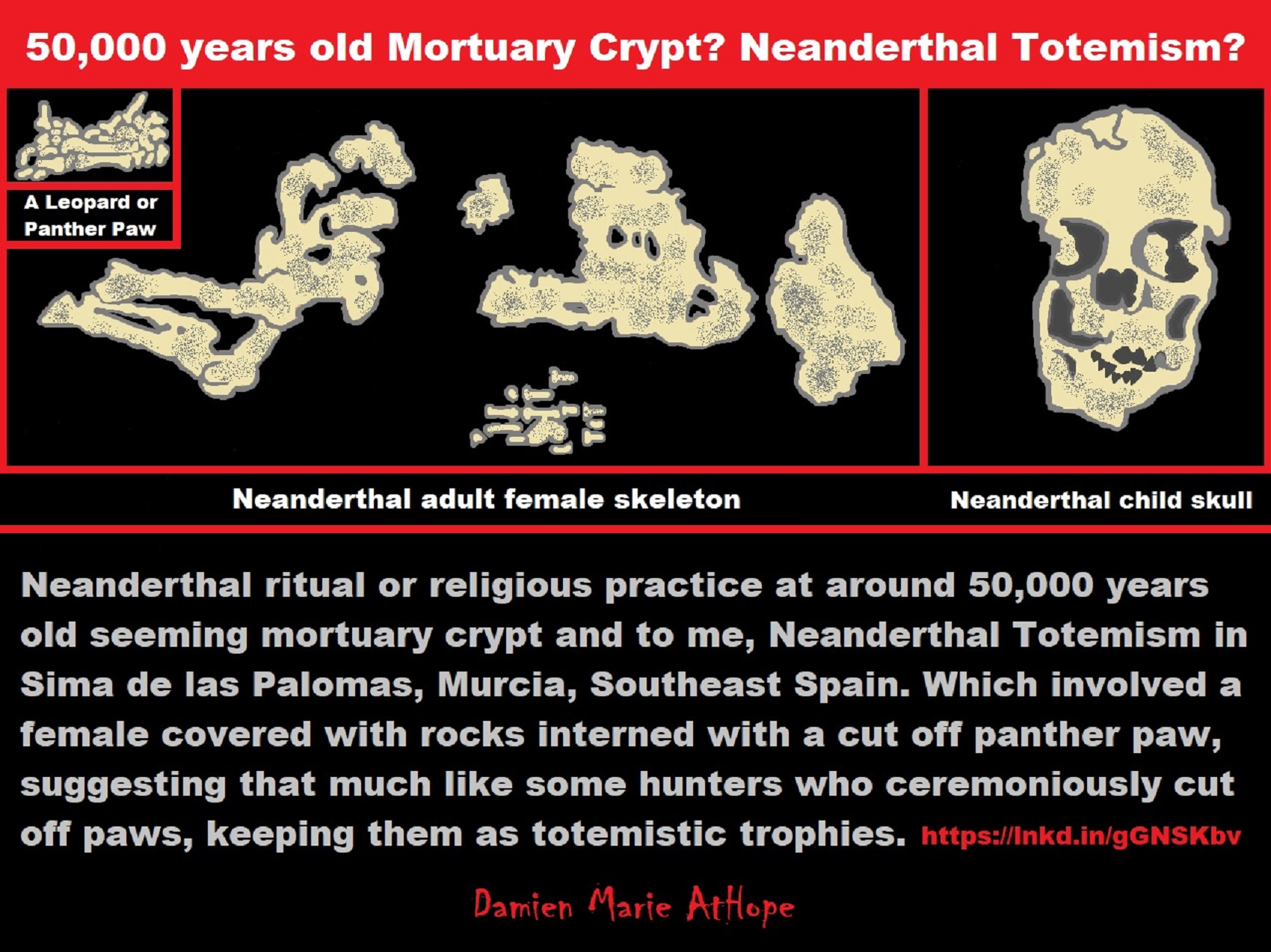
Neanderthal ritual or religious practice at around 50,000 years old burial in Sima de las Palomas in Murcia, Southeast Spain of a female covered with rocks inturned with a cut-off panther paw, suggesting that Neanderthals—much like today’s bear hunters—ceremoniously cut off panther paws and kept them as totemistic trophies. This 50,000-year-old Neanderthal burial ground actually includes the remains of at least three individuals intentionally buried, with each Neanderthal’s arms folded such that the hands were close to the head. Remains of other Neanderthals have been found in this position, suggesting that it held meaning. The remains of six to seven other Neanderthals, including one baby and two juveniles, have also been excavated at the site. The tallest individual appears to have been an adult who stood around 5 feet 1 inch tall. ref, ref
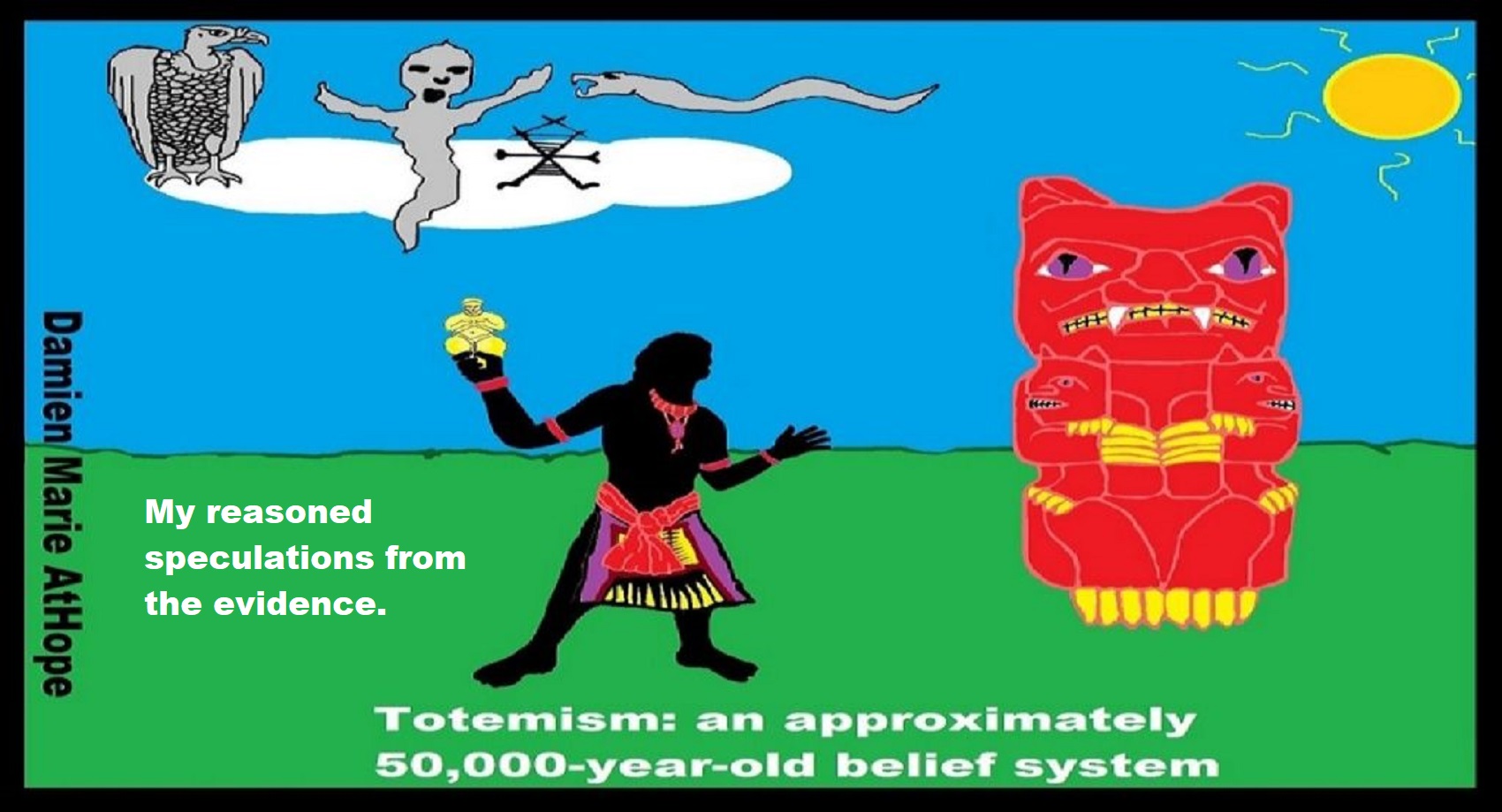
Totemism is less holistic and somewhat masculine in nature compared to Animism with the heavily supported taboos and clan structure (things are separated and must stay separated with sacred and profane, off-limits and allowed, or clean and unclean running one’s entire lives. Things in nature are to be controlled or feared, things in nature have danger and can be evil, but it is also can be used for good and can be helpful for protection. There are spirits that I made thinner than Animism as it has to share space with the metaphorical clan ancestor there is also supernatural beings both animal and human-like Animism, but where animisms animals are calmer and less harmful like the bird that is a stork referencing life, and the shake is smiling. Whereas, in totemism, this same template is changed through similar. The totemism bird is a vulture referencing a thing of death, not life, and the snake has its teeth barred as a threat. Like Animism, there are nonhuman supernatural things or being but in general would be attributed to a somewhat nonpersonal shared clan ancestor grandmother/grandfather or great grandmother/grandfather, not as much of what we think about like a god today.
“The Totemism,
“The first accurate report about totemism in North America was written by a Methodist missionary, Peter Jones, himself an Ojibwa, who died in 1856 and whose report was published posthumously. According to Jones, the Great Spirit had given
“Totemism can certainly include religious elements in var
“For example, a group that holds that it is derived directly or indirectly from a given totem may have a tradition in which its progenitor was an animal or plant that could also appear as a human being. In such belief systems, groups of people and species of animals and plants can thus
“Consequently, such totems became most strongly tabooed; above all, they were connected with family or group leaders, chiefs, medicine men, shamans, and other socially significant persons. Studies of shamanism indicate that individual totemism may have predated group totemism, as a group’s protective spirits were sometimes derived from the totems of specific individuals. To some extent, there also exists a tendency to pass on an individual totem as hereditary or to make taboo the entire species of animal to which the individual totem belongs. Individual totemism is widely disseminated. It is found not only among tribes of hunters and harvesters but al
“The transmission of the individual totem to novices is done through the father or the grandfather, who, of course, himself is also a medicine man. While the candidate lies on his back, the totem is “sung into” him. The blood relative who is transmitting the totem takes a small animal and places it on the chest of the youngster. During the singing, the animal supposedly sinks slowly into his body and finally disappears into it. The candidate is then instructed on how he has to treat the animal that is his comrade, and he is further instructed in song and the ritual concentration that is necessary to dispatch the totem from his body. Among the Nor-Papua of New Guinea, patrilineal, exogamous groups (consanguineous sibs) are spread over several villages and are associated with animals, especially fish. They believe that they are born from totems, and they make them taboo. Children are given an opportunity to decide during their initiation whether they will respect the paternal or maternal totem. Each group of relatives has a holy place to which the totem animal brings the souls of the dead and from which the souls
“According to one imperfect list of 37 clans, 12 are based on animals, 10 on plants, 8 on Hindu castes and localities, and the rest on objects. The totems are passed on within the group, and tales about the tribe’s origins suggest that each totem had a fortuitous connection with the birth of the ancestor of the clan. The Birhor think that there is a temperamental or physical similarity between the members of the clan and their totems. Prohibitions or taboos are sometimes cultivated to an extreme degree. In regard to eating, killing, or destroying them, the clan totems are regarded as if they were human members of the group. Moreover, it is believed that an offense against the totems through a breach of taboo will produce a corresponding decrease in the size of the clan. If a person comes upon a dead totem animal, he must smear his forehead with oil or a red dye, but he must not actually mourn over the animal; he also does not bury it. The close and vital relationship between the totem and the clan is shown in a definite ceremony: the yearly offering to the chief spirit of the ancestral hill. Each Birhor community has a tradition of an old settlement that is thought to be
“The totem also punishes the breach of any taboo. Kpelle totems include animals, plants, and natural phenomena. The kin groups that live in several villages were matrilineal at an earlier time, but during the 20th
Totemism as seen in Europe: 50,000 years ago, mainly the Aurignacian culture
- Pre-Aurignacian “Châtelperronian” (Western Europe, mainly Spain and France, possible transitional/cultural diffusion between Neanderthals and humans around 50,000-40,000 years ago)
- Archaic–Aurignacian/Proto-Aurignacian (Europe around 46,000-35,000)
- Aurignacian culture to me arose possibly from Châtelperronian diffusion between Neanderthals and humans and the European Bohunician culture in South-Central and East Europe dated at 48,000 years ago, thought to be related to Levant Emiran dated to around 50,000—40,000 years ago. Ahmarian culture in the Levant dated at 46,000-42,000 years ago and is thought to be related to Levantine Emiran and younger European Aurignacian cultures which began spreading from the Middle East. Such as, in the likes of the Manot Cave, occupied from about 55,000 years ago to at least 30,000 years ago some of who moved toward Europe at least by 45,000 years. ref, ref
- Aurignacian “classical/early to late” (Europe and other areas around 38,000 – 26,000 years ago)
“The most significant “recent” Out of Africa wave took place about 70,000 years ago, via the so-called “Southern Route”, spreading rapidly along the coast of Asia and reaching Australia by around 65,000–50,000 years ago. While Europe was populated by an early offshoot that settled the Near East and Europe less than 55,000 years ago.” ref
All populations before around 40,000 years ago were way more inbred and then after that is has been a great decrease, to which I hypothesize could be genetic evidence of the emergence of INCEST-PROHIBITION hints at the taboo in Totemism. ref
“The Horror of Incest” concerns incest taboos adopted by societies believing in totemism.
Totemism is a belief system scattered world-wide mainly by hunting and gathering peoples, which seems to diminish when agricultural becomes predominant. Totemism seems expressed all over the North American especially the west cost indigenous peoples, in Peru, in Guiana, what was the African Gold Coast, in India, the South Seas islands, Australia, Siberia, Egypt, and Semitic regions. It is thought that the current true totemism is found only among Australian Aborigines, North, and South American indigenous peoples, in New Guinea, and parts of Africa and India. But it is Australia, America, and Africa that are the three main areas where totemism has been found in its most highly developed and widespread forms. ref
Totemism is approximately a 50,000-year-old belief system and believe in spirit-filled life and/or afterlife that can be attached to or be expressed in things or objects. If you believe like this, regardless of your faith, you are a hidden totemist.
Totemism may be older as there is evidence of what looks like a Stone Snake in South Africa, which may be the “first human worship” dating to around 70,000 years ago. Many archaeologists propose that societies from 70,000 to 50,000 years ago such as that of the Neanderthals may also have practiced the earliest form of totemism or animal worship in addition to their presumably religious burial of the dead. Did Neanderthals help inspire Totemism? There is Neanderthals art dating to around 65,000 years ago in Spain. ref, ref
- 50,000 years ago: the earliest sewing needle found. Made and used by Denisovans.
- 50,000–30,000 years ago: Mousterian Pluvial in North Africa. The Sahara desert region is wet and fertile. Later Stone Age begins in Africa.
- 45,000–43,000 years ago: European early modern humans.
- 45,000–40,000 years ago: Châtelperronian culture in France.
- 42,000 years ago: Paleolithic flutes in Germany.
- 42,000 years ago: earliest evidence of advanced deep sea fishing technology at the Jerimalai cave site in East Timor—demonstrates high-level maritime skills and by implication the technology needed to make ocean crossings to reach Australia and other islands, as they were catching and consuming large numbers of big deep sea fish such as tuna.
- 41,000 years ago: Denisova hominin lives in the Altai Mountains.
- 40,000 years ago: Aurignacian culture begins in Europe.
- 40,000 years ago: oldest known figurative art the zoomorphic Löwenmensch figurine.
- 40,000–30,000 years ago: human settlement (Aboriginal Australians) in Sydney, Perth, and Melbourne.
- 40,000–20,000 years ago: oldest known ritual cremation, the Mungo Lady, in Lake Mungo, Australia.
- 35,000 years ago: one of the oldest known figurative art of a human figure as opposed to a zoomorphic figure (Venus of Hohle Fels).” ref
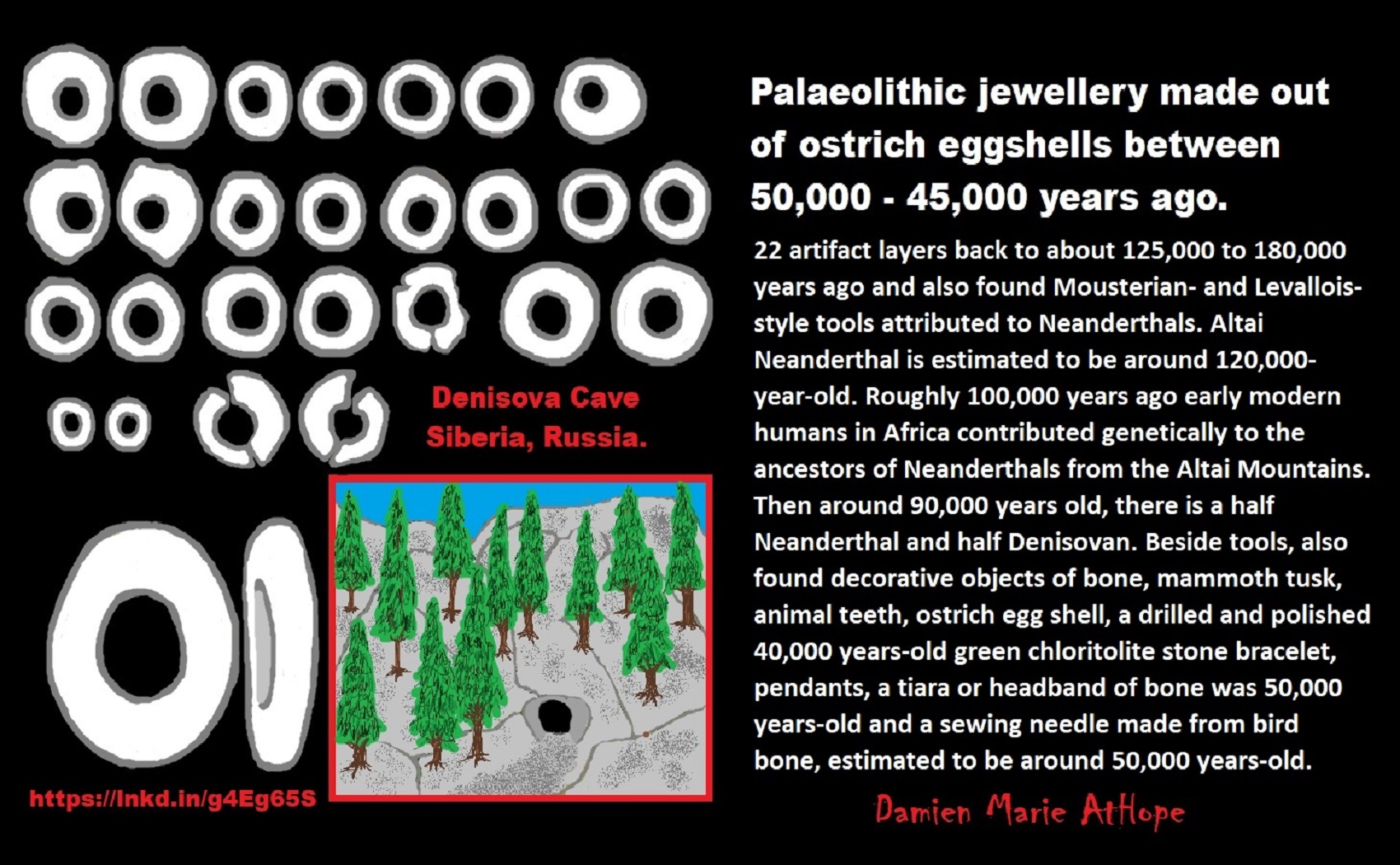
“Fossil bone evidence of the Denisovans uncovered in Denisova Cave in the Russian Altai Mountains which are a sister group to Neanderthals showed that Denisovans lived in the cave from at least 200,000 to less than 50,000 years ago. And that Denisovans are closer in terms of shared ancestry to Neanderthals than they are to modern humans at one time lived alongside Neanderthals in the same cave, the evidence showed. Moreover, that
Neanderthals were present at Denisova Cave from at least 190,000 years ago until at least 90,000 years ago. Evidence shows that the two groups certainly interbred first giving rise to a daughter of mixed ancestry about 100,000 years ago.” ref
“A 50,000-year-old bone fragment of a 13-year-old female was discovered in the Denisova Cave who had a Neanderthal mother and a Denisovan father.” ref
“From the location of the Denisova Cave, we can trace a path from modern-day Russia into Southeast Asia and Australia. What’s perhaps more surprising is that there is a low rate of interbreeding in China, Mongolia, Nepal, and other countries on the main continent. But the fractions of a percent of shared DNA seen in modern Asian populations have imparted beneficial adaptations to some groups there. For native Tibetans, ancient hominin interbreeding may have impacted their ability to live in climates and attitudes hostile to other groups, such as withstand the effects of hypoxia in low-oxygen environments. The gene flow from Denisovans was from another archaic population that was extremely distantly related to the Denisovan from the Denisova Cave.” ref
Modern humans interbred with Denisovans twice, such as the genomes of two groups of modern humans with Denisovan ancestry from Oceania and East Asia are uniquely different, indicating that there were two separate episodes of Denisovan admixture. In fact, in East Asians DNA, is a set of Denisovan ancestry not found in the South Asians and Papuans. Moreover, it was determined that the Denisovan genome is more closely related to the modern East Asian population than to modern Papuans. ref
“Although DNA from the Papuans up against the Denisovan genome, were similar enough to declare a match, some of the DNA sequences in the East Asians, notably Han Chinese, Chinese Dai, and Japanese, were a much closer match with the Denisovan. The assumption is that admixing with Denisovans occurred fairly quickly after humans moved out of Africa, around 50,000 years ago, but we do not know where in terms of location.” ref
DNA from the Denisovan Siberian cave-dwellers from them has been found in the Aboriginal descendants of the first settlers on the continent. And separate studies suggest that the ability of Tibetans to withstand the effects of hypoxia in low-oxygen environments is linked to a gene absent in Neanderthals but present in Denisovans. ‘Where the interbreeding event(s) between Denisovans and early modern humans actually took place are currently unknown. There is also evidence from fossil teeth that modern humans were in southern China at least 80,000 years ago, and in Sumatra about 65,000 years ago. So populations
They contributed DNA to Aboriginal Australians along with present-day New Guineans and an indigenous tribe in the Philippines known as Mamanwa. Scholars have long been flummoxed as to why the language spoken by 90 percent of Australia’s Aborigines is relatively young—approximately 4,000 years old according to language experts—if their ancestors had occupied the continent so much earlier. One possible answer has been that a second migration into Australia by people speaking this language occurred around 4,000 years ago. The authors of the new study, however, say a previously unidentified internal dispersal of Aborigines that swept from the northeast across Australia around that time led to the linguistic and cultural linking of the continent’s indigenous people. Although they had a sweeping impact on ancient Australian culture, these “ghost-like” migrants mysteriously disappeared from the genetic record. A few immigrants appear in different villages and communities around Australia. ref, ref, ref
They change the way people speak and think; then they disappear, like ghosts. And people just carry on living in isolation the same way they always have. This may have happened for religious or cultural reasons that we can only speculate about. But in genetic terms, we have never seen anything like it before.” One other notable finding from the DNA study is evidence of an “uncharacterized” hominin group that interbred with modern humans as they migrated through southeast Asia on their way to Australia. Four percent of Aboriginal Australian DNA comes from a distant relative of Denisovans (an extinct human species from Siberia). It has been found that there was a migration of genes from India to Australia around 4,000 years ago. ref, ref, ref
The researchers had two theories for this: either some Indians had contact with people in Indonesia who eventually transferred those genes from India to Australian Aborigines, or that a group of Indians migrated all the way from India to Australia and intermingled with the locals directly. Their research also shows that these new arrivals came at a time when dingoes first appeared in the fossil record, and when Aboriginal peoples first used microliths in hunting. In addition, they arrived just as one of the Aboriginal language groups was undergoing a rapid expansion. Blood samples from some Warlpiri Tribe of Aboriginal Australians, who are not representative of all Aboriginal Tribes in Australia and descended from ancient Asians whose DNA is still somewhat present in Southeastern Asian groups, although greatly diminished. The Warlpiri DNA also lacks certain information found in modern Asian genomes, and carries information not found in other genomes, reinforcing the idea of ancient Aboriginal isolation. ref, ref, ref
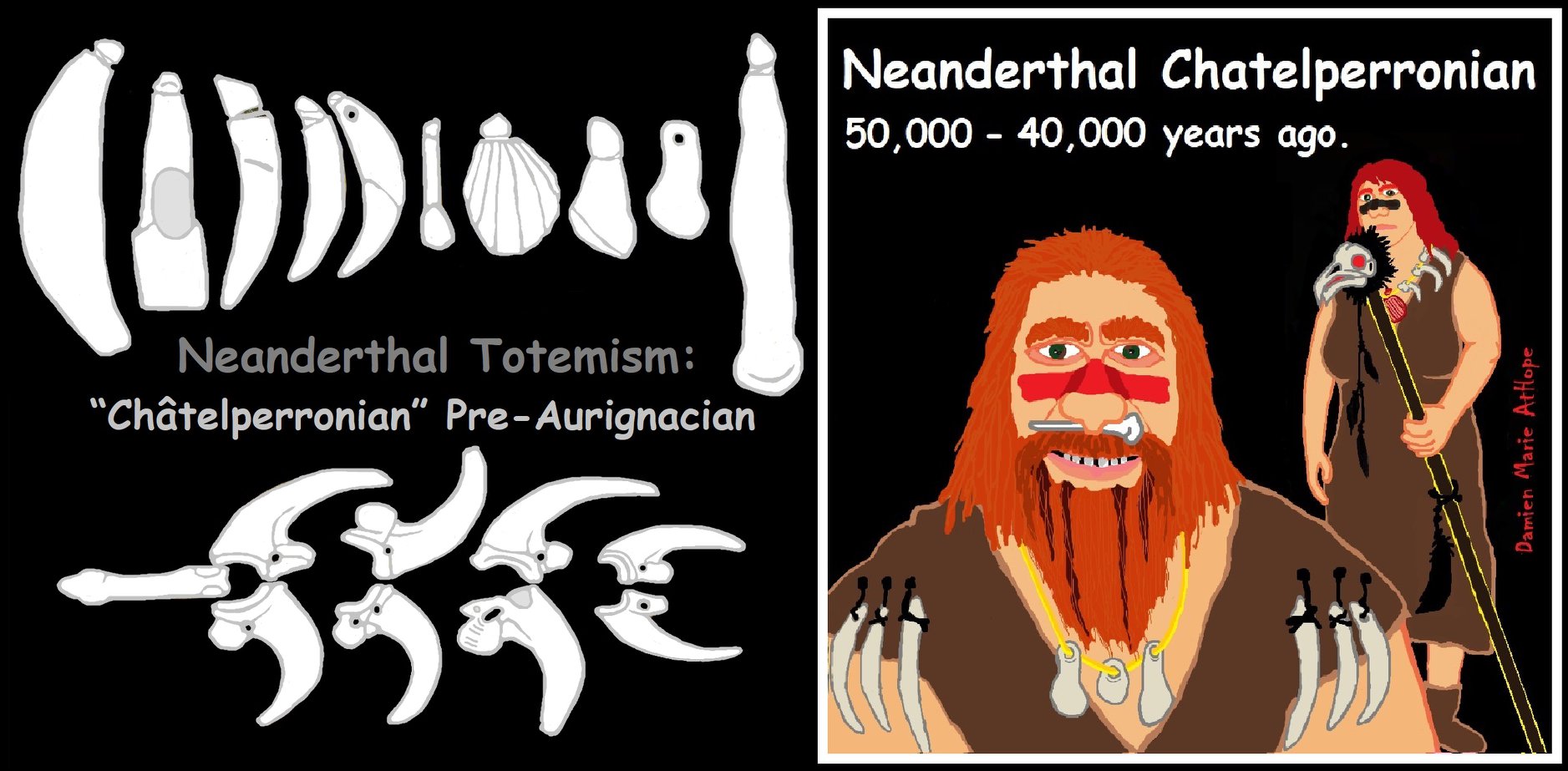
The so-called “transitional industries” are a key for understanding the replacement process of Neanderthals by modern humans in western Eurasia at the beginning of the Upper Paleolithic between 50,000 and 40,000 years ago. While in Europe the older Mousterian industry of the Middle Paleolithic can be clearly attributed to Neanderthals and the later Upper Paleolithic assemblages to modern humans, the nature of the makers of the transitional Châtelperronian (CP) industry has long been disputed. ref, ref, ref
Haplogroup O-M175 is a descendant haplogroup of Haplogroup NO-M214, and first appeared according to different theories either in Southeast Asia approximately 40,000 years ago (or between 31,294 and 51,202 years ago. This haplogroup appears in 80-90% of most populations in East Asia and Southeast Asia, and it is almost exclusive to that region: M175 is almost nonexistent in Western Siberia, Western Asia, Europe, most of Africa, and the Americas, where its presence may be the result of recent migrations. Certain subclades of Haplogroup O-M175 do achieve significant frequencies among some populations of South Asia, Central Asia, and Oceania. The significant presence of Haplogroup O-M50 have been found in Bantu-speaking populations of the Comoros along with a single instance of O-MSY2.2(xM50) while both O-M50 and O-M95(xM88) occur commonly among the Malagasy people of Madagascar. O-M175(xM119, M95, M176, M122) Y-DNA in 1/18 Iranians from Teheran, 2/37 Tajiks from Badakhshan Province of Afghanistan, and 1/97 Mongols from northwest Mongolia, while finding O-M176 only in 1/20 Mongols from northeast Mongolia. ref
K2b probably is around 50,000 years old is the ancestor of Haplogroup K2 (K-M526), which is found in southeast Asia around 30,000-40,000 years ago. Splitting into: K3(P79), M(P256), NO(M214), P(M45), and S(M230). Y- DNA Haplogroup M (P256) is a descendant of Haplogroup K2b1, and it presumably first mutated between 32,000 and 47,000 years ago in south Asia. Most populations (50%-100%) in West Papua and western Papua New Guinea belong to haplogroup M (P256). Haplogroup M (P256) likely originated in Melanesia and then spread into Indonesia, Micronesia, and New Guinea. Haplogroup S-M230 is found primarily in populations in Papua New Guinea with lower frequencies in Melanesia and Indonesia. The possible time of origin is 28,000-41,000 years before present and possibly originated in New Guinea or Indonesia. K2b1, its subclades, and P* are virtually restricted geographically to South East Asia and Oceania. Whereas, in a striking contrast, P1(P-M45) and its primary subclades Q and R now make up “the most frequent haplogroup in Europe, the Americas, and Central Asia and South Asia“. The estimated dates for the branching of K, K2, K2b, and P point to a “rapid diversification” within K2 “that likely occurred in Southeast Asia”, with subsequent “westward expansions” of P*, P1, Q, and R ref, ref

40,000 to 50,000 years ago, the Emergence of Norm Violations
Around 50,000 to 40,000 years ago there seems to be the emergence of norm violations relating to what I think is totemistic cultural influenced behavior, on what research suggests is moral disgust. This early moralistic totemism or “taboo” beliefs, which, to me, relates to genetic evidence of possible moral disgust with genetics showing that after 40,000 years ago there is an extreme lowering of incest behaviors also coinciding with the emergence of more complex cave art, figurines, and personal adornments around 50,000 to 40,000 years ago. All this and more offers some confirming evidence of my thoughts on totemism’s emergence around 50,000 years ago in western Europe, seen in the Pre-Aurignacian Neanderthal “Châtelperronian” and/or by the Early Aurignacian or Proto-Aurignacian times.
In the video “Robert Sapolsky: The Biology of Humans at Our Best and Worst” (17 or so minutes in) states the emergence of norm violations of moral disgust occurred around 40,000 to 50,000 years ago which is about the time that genetics shows after 40,000 years ago there was an extreme lowering of insect behaviors coinciding with the emergence of more complex cave art, figurines, and personal adornments all confirming my thoughts on totemism emerging after 50,000 years ago in Europe by the Early Aurignacian or Proto-Aurignacian stage. And in the video “DNA Mammoths, Neanderthals, and Your Ancestors,” it also quickly including the evidence for early people following incest taboos, are clearly evident after 40,000 years ago by genetics. Which, to me, likely connects to the motivations adopted by societies believing in Totemism. ref, ref
Thinking about how Totemic cultures, can, to me, be said to likely start in Europe and disperse elsewhere through religious transfer, connected through genes or otherwise. The initial settlement of Australia occurred between 47,000–55,000 years ago. Aboriginal Australians and New Guineans is different, implying a long separation that started at least 30 KYA. Did the colonizers enter Sahul via present-day New Guinea and subsequently spread southwards to Australia, or were there different routes into Sahul, such that one or more groups entered Australia via the ancient northwestern coast that is now submerged under the Timor and Arafura Seas? Furthermore, a mix of genetic, archeological, anthropological, and linguistic data have suggested later migration(s) to Australia in the Holocene epoch, particularly from the Asian sub-continent.
The basal para-group K2b* has not been identified among living males or ancient remains. K2b1 (P397/P399) known previously as Haplogroup MS, and Haplogroup P (P-P295), also known as K2b2are the only primary clades of K2b. K2b1, its subclades, and P* are virtually restricted geographically to South East Asia and Oceania. Today, P is most commonly found in Oceania, especially in Papuans, Melanesians, indigenous Australians, and Filipinos. It was found in the Aeta of Bataan at 40%. Whereas, in striking contrast, P1 (P-M45) and its primary subclades Q and R now make up “the most frequent haplogroup in Europe, the Americas, and Central Asia and South Asia”. Estimated dates for the branching of K, K2, K2b, and P point to a “rapid diversification” within K2 “that likely occurred in Southeast Asia”, with subsequent “westward expansions” of P*, P1, Q, and R. ref, ref, ref
- R1, has been common throughout Europe and South Asia since pre-history. Interestingly, haplogroups R and Q, which make up the majority of paternal lineages in Europe, Central Asia, and the Americas, represents the only subclade with K2b that is not geographically restricted to Southeast Asia and Oceania. Haplogroup R, is believed to have arisen during the Upper Paleolithic era, about 27,000 years ago. Only one confirmed example of basal R* has been found, in 24,000-year-old remains, known as MA1, found at Mal’ta–Buret’ culture near Lake Baikal in Siberia. The wide geographical distribution of R1b, in particular, has also been noted living examples found in Central Asia include the “deepest subclade” of R-M269 (R1b1a1a2) – the most numerous branch of R1b in Western Europe. ref
M1 in Africa is the result of a back-migration from Asia which occurred sometime after the Out of Africa migration 40,000 years ago. ref
THE KULBULAKIAN CULTURE IN THE CONTEXT OF AURIGNACIAN IN ASIA

After the dispersal of modern humans Out of Africa, around 70,000 years ago or so. Modern Humans appeared in the Western Eurasian fossil record around 45,000 years ago or so, then begins the transition from Neandertals occupation to Modern Humans expansion and one of these early people was Ust’-Ishim (Western Siberia, around 45,000 years ago, Kostenki (Russia, 39–36,000 years ago), Grotta di Fumane (Italy, 41,000–39,000 years ago) and Peştera cu Oase (Romania, 37,000–42,000 years ago). Around 6-9% of the genome of the Oase individual is derived from Neanderthals, indicating that this individual had a Neanderthal ancestor as recently as four to six generations back. The origins of Europeans used to seem straightforward: The first modern humans moved into Europe around 45,000 years ago or more, perhaps occasionally meeting the Neandertals whose ancestors had inhabited Europe for at least 400,000 years. Then, starting 10,000 years ago, farmers came from the Middle East and spread rapidly throughout Europe. ref ref, ref
The Bacho Kiro site
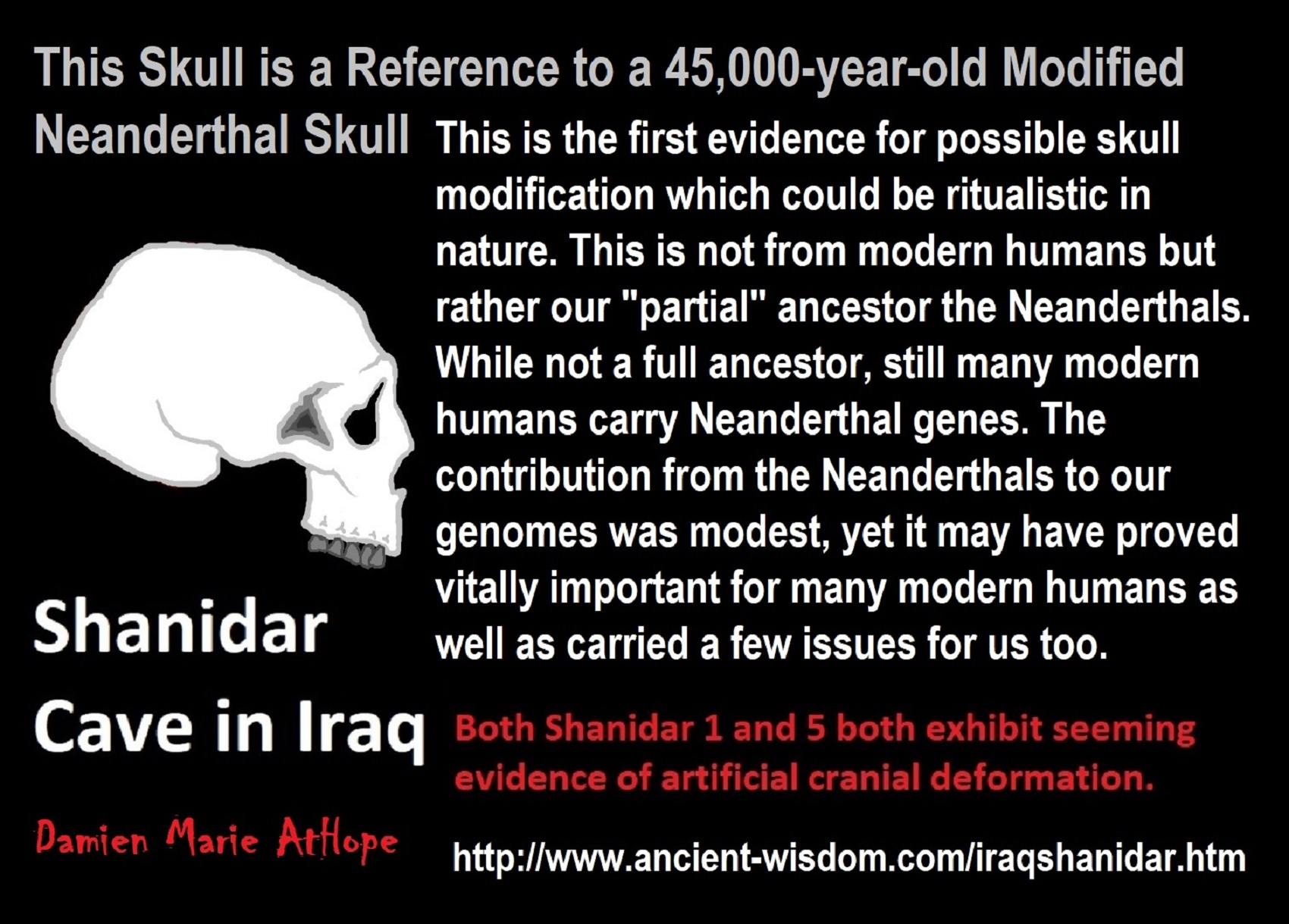
Zagros Mountains, Kurdistan, Iraq, located in north-east Iraq held the first evidence for possible skull modification among our ancestors comes in the form of some 45,000-year-old Neanderthal skulls. The Shanidar Cave was inhabited by Neanderthal for over 30,000 years (from 60,000 – 35,000 BC) until the arrival of Modern Humans. The Shanidar skeletons and their burials suggested complex socialization skills including care for other members of the group. Archeologists believe that Shanidar 1 was taken care of by the other Neanderthals in his social group. It would have been very difficult for him to live long enough for his injuries to partially heal without help from others. Both Shanidar 1 and 5 both exhibit what seeming evidence of artificial cranial deformation. The most striking aspect of these skulls is their combination of frontal flattening and unnatural curvature at the back. Shanidar 5 shows significant forehead flattening—4.5 standard deviations from the population mean. There is also a report of a 20,000-year-old skull found near Beijing in China that may have been modified. ref, ref, ref, ref, ref, ref
Kow Swamp, possibly to as early as 22,000 BP. At least 40 individuals were buried with grave goods, some of which were mussel shells, stone artifacts, marsupial teeth, and ochre. There is also a report of a 20,000-year-old skull found near Beijing in China that may have been modified. The Cohuna cranium came from the Kow Swamp site, from southeast of Cohuna was low, broad, and elongated and the forehead has been flattened artificially dated to between 14,000-9,000 years ago. Australia’s ancient inhabitants were among the first in the world to deliberately transform the shape of their own skulls. Such as, the Coobool Creek remains were about 14,000 years old near the Wakool River in New South Wales, Australia. ref, ref, ref, ref
The earliest examples of intentionally deformed skulls in the Americas were found in Peru and date to between 9,000 to 8,000 years ago. The practice put down deep roots in Peru, spreading throughout Andean communities and the rest of the continent from there. Excavations of ancient Peruvian remains have found that a vast majority of them—as many as 90 percent on some digs—have deformed skulls. ref
Who were the indigenous people of Indonesia before the Chinese and Indians came?
Sequencing of one Aboriginal genome from an old hair sample in Western Australia revealed that the individual was descended from people who migrated into East Asia between 62,000 and 75,000 years ago. This supports the theory of a single migration into Australia and New Guinea before the arrival of Modern Asians (between 25,000 and 38,000 years ago) and their later migration into North America.
This dispersal is separate and I think is around the time totemism enters the region from Arcane Early Europe by way of Siberia and thus Aisa, the one that gave rise to modern Asians 25,000 to 38,000 years ago. We also find evidence of gene flow between populations of the two dispersal waves prior to the divergence of Native Americans from modern Asian ancestors. It is surmised from DNA that a split between Europeans and Asians dating to 17,000 to 43,000 years before the present. ref
Mitochondrial haplogroups A, B, and G originated about 50,000 years ago, and bearers subsequently colonized Siberia, Korea, and Japan, by about 35,000 years ago. Several phenotypical traits associated with Mongoloids with a single mutation of the EDAR gene, dated to c. 35,000 years ago. A Paleolithic site on the Yana River, Siberia, at 71°N, lies well above the Arctic Circle and dates to 27,000 radiocarbon years before present, during glacial times. This site shows that people adapted to this harsh, high-altitude, Late Pleistocene environment much earlier than previously thought. ref
Moreover, the mitogenome of a 35,000-year-old Homo sapiens from Europe (Peștera Muierii 1 individual from Romania) supports a Palaeolithic back-migration to Africa. The Peștera Muierii 1 individual mitogenome was a basal for haplogroup U6*, not previously found in any ancient or present-day humans.
The derived U6 haplotypes are predominantly found in present-day North-Western African populations. Concomitantly, those found in Europe have been attributed to recent gene-flow from North Africa.
The presence of the basal haplogroup U6* in South East Europe (Romania) at 35,000 years ago confirms a Eurasian origin of the U6 mitochondrial lineage. Consequently, we propose that the Peștera Muierii 1 individual lineage is an offshoot to South East Europe that can be traced to the Early Upper Paleolithic back migration from Western Asia to North Africa, during which the U6 lineage diversified, until the emergence of the present-day U6 African lineages.
After the dispersal of modern humans Out of Africa, hominins with similar morphology to present-day humans appeared in the Western Eurasian fossil record around 45,000–40,000 years ago, initiating the demographic transition from ancient human occupation (Neandertals) to modern human (Homo sapiens) expansion on to the continent.
The first insights of the genetics of early Eurasian modern humans were recently provided by four ancient human genomes: Ust’-Ishim (Western Siberia, 45,000 years ago), Kostenki (Russia, 39,000–36,000 years ago), Fumane 2 (Italy, 41,000–39,000 years ago) and Peştera cu Oase (Romania, 37,000–42,000 years ago). Population genetic analyses of modern-day human mitochondrial haplogroup distributions suggest that in conjunction with the Eurasian expansion, some populations initiated a back-migration to North Africa.
Although the first genome of an ancient African individual (Ethiopia, 4,000-5,000 years ago) identified a back-migration from Eurasia to Africa within the at last 4.500 years, the scarcity of older human remains in North Africa has prevented researchers from obtaining direct evidence of such a migratory phenomenon during the Paleolithic period. We present the mitochondrial genome (mitogenome) of the Peştera Muierii 1 (PM1) remains from Romania, directly dated to 35,000 years ago, which sheds new light on the Early Upper Paleolithic (EUP) migrations in Eurasia and North Africa. ref
Haplogroup U6 has a very wide geographic distribution across the northern half of Africa, the Middle East, and most of western and southern Europe. It has been found at low frequencies as far north as the Baltic and as far east as Central Asia and Iran. It is most common in North-West Africa, especially among the Mozabites (28%) and Kabyles (18%) of Algeria, as well as Mauritanians (14%) and Canary Islanders (13.5%).
Other regions with frequencies of U6 exceeding 1% include 6-8% in Morocco and coastal Algeria, 5% in Tunisia, 4% in Libya, 2.5% in Lebanon, Portugal, Egypt, and Oman, 2% in Cyprus, Sudan, Ethiopia and Guinea-Bissau, 1.5% in Saudi Arabia, and 1% in Syria, Jordan and in Spain. Isolated pockets of high U6 frequencies have been reported in Iberia, notably 8.5% in Huelva (western Andalusia) by Hernández et al. 2014, 7% in northern Portugal by Pereira et al. 2000, 4.3% in northern Portugal, 4% in central Spain and 2.5% in central Portugal by Ottoni et al. 2011, and 2.6% in Catalonia by Garcia et al. 2011. U6 is only found at trace frequencies among Ashkenazi Jews and in most of Europe. The highest frequencies observed in Europe outside Iberia are in south-west France (1.4%), Brittany (0.7%), in Tuscany (0.6%), Sicily (0.5%), and southern Italy (0.5%).
Therefore, although now found primarily in western, northern, and north-eastern Africa, haplogroup U6 descends from the western Eurasian haplogroup U, and therefore represents a back migration to Africa. Secher et al. (2014) estimated that U6 arose very approximately 35,000 years ago (±11 ky), during the Early Upper Paleolithic, and prior to the Last Glacial Maximum. ref
Neanderthals ‘kept our early ancestors out of Europe’
Two Paleolithic harpoons, at least 60,000 years old, decorated with geometric figures discovered at Veyriernear Geneva. Which is younger than a beautifully-carved 90,000-year-old bone harpoon used to hunt giant catfish in present-day the Democratic Republic of the Congo. ref
Our ancestors had interbred with Neanderthals 55,000 years ago, possibly in the Middle East. Modern humans and Neanderthals interbred in Europe, an analysis of 40,000-year-old DNA suggests. ref
50,000-year-old Skull May Show Human-Neanderthal Hybrids Originated in Levant, not Europe as Thought
Research into ancient genomics and archaeology has shed light into the first humans in Europe, who appear in the record approximately 45,000 years ago. Neanderthals disappeared from the region 5,000 years later. The nature of their relationship is being revealed with every new discovery and breakthrough. ref
Neanderthals and modern humans belong to the same genus (Homo) and inhabited the same geographic areas in Asia for 30,000–50,000 years; genetic evidence indicates while they may have interbred with non-African modern humans, they are separate branches of the human family tree (separate species). ref
So, around the time we fully interact with Neanderthals in Europe Totemism emerges about 50,000 years ago. And, around the time all interact with Neanderthals is over we see Shamanism emerge about 30,000 years ago, could this just be a coincidence, I don’t really think so.
Upper Paleolithic (totemism in Europe between 50,000 and 30,000 years ago)
“Cultures Aurignacian Associated with Paleo-humans/Paleolithic lifestyle“
The Levantine Aurignacian: a closer look
Ust’-Ishim man 45,000-year-old remains of a male hunter-gatherer,
(I presume a totemist or connected to the firsts totemic peoples by around 50,000 years ago
then by 30,000 years ago are shamanistic-totemists)
one of the early modern humans to inhabit western Siberia.
Ust’-Ishim man has been classified as belonging to Y-DNA haplogroup K2a*, and belonged to mitochondrial DNA haplogroup R*. Before 2016 they had been classified as U*. Both of these haplogroups and descendant subclades are now found among populations throughout Eurasia, Oceania, and The Americas. When compared to other ancient remains, Ust’-Ishim man is more closely related, in terms of autosomal DNA to Tianyuan man, found near Beijing and dating from 42,000 to 39,000 years ago; Mal’ta boy (or MA-1), a child who lived 24,000 years ago along the Bolshaya Belaya River near today’s Irkutsk in Siberia, or; La Braña man – a hunter-gatherer who lived in La Braña (modern Spain) about 8,000 years ago. ref
World’s oldest, 29,000-year-old net sinkers found in Korea
From a cave in South Korea have found evidence that suggests human beings were using sophisticated techniques to catch fish as far back as 29,000 years ago. Pryor to the South Korean find, the oldest fishing implements were believed to be fishing hooks, made from the shells of sea snails, that was found on a southern Japanese island and said to date back some 23,000 years. ref
Zagros Aurignacian from Yafteh cave, Iran, Early Baradostian culture at Yafteh cave in the Zagros mountains dated around 40,000-35,000 years ago. The Baradostian culture was an Upper Paleolithic flint industry culture found in the Zagros region in the border-country between Iraq and Iran. The site held a rich collection of ornaments made of marine shells, tooth and hematite have been discovered in the early Upper Paleolithic deposits with dates clustered around 28,000–35,000 thousand years ago. Yafteh cave has clear evidence pointing to an Aurignacian connection dating back to about 35,5000 years ago possibly providing a culture link from West Asia to Europe, I would propose by way of Siberia. ref, ref, ref
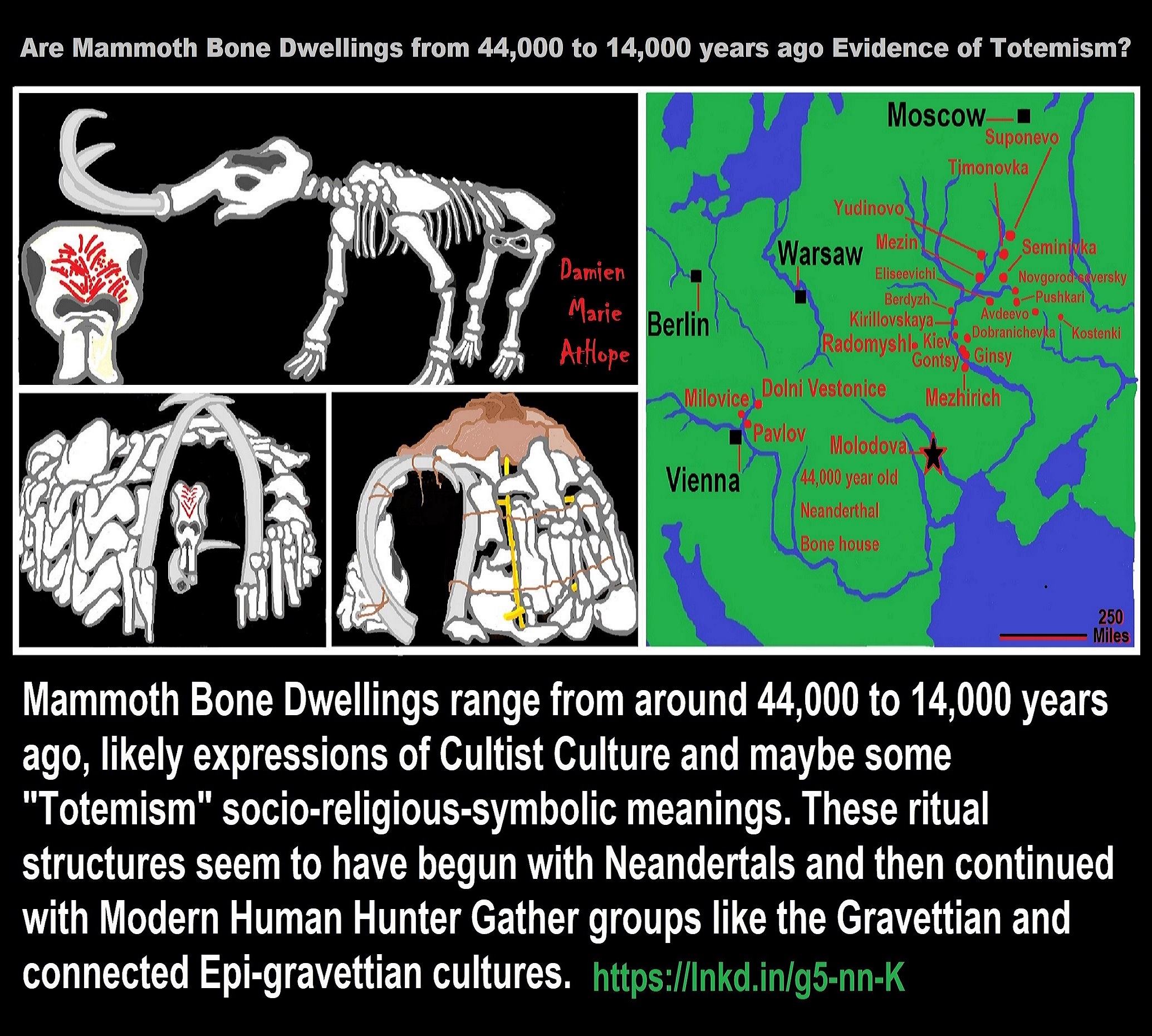
Mammoth bone dwellings are a very an early type of housing constructed by Upper Paleolithic hunter-gatherers mainly in central Europe. ref
Mammoth Bone Dwellings range from around 44,000 to 14,000 years ago, likely expressions of Cultist Culture and maybe some “Totemism” socio-religious-symbolic meanings. These ritual structures seem to have begun with Neandertals and then continued with Modern Human Hunter Gather groups like the Gravettian and connected Epi-gravettian cultures. ref
Gravettian and Epigravettian mammoth bone dwellings range from: Pavlovian (Early Gravettian of Moravia), Gagarino and Pouchkari (Gravettian of Eastern Europe), Kostienki 11/1a (Zamiatnine culture), and Mezinian. ref
The 44,000-year-old site from Molodova in eastern Ukraine was a Neanderthal “Mousterian Culture” Mammoth Bone Dwelling with possible “Totemism” connections due to how some of the bones used to build the ritual structure home had decorative carvings and added pigments. It was an incredible 26 foot wide circular building believed to be earliest bone-built cultural structure and where they lived for extended periods of time. ref ref
The 44,000-year-old Neanderthal bone structure near Molodova was constructed with 116 large deliberately selected mammoth bones including skulls, jaws, tusks, and leg. Inside there was at least 25 fire pits and from the artifacts found Neanderthals made many decorated carvings in addition to the symbolic adding of ochre pigments to the bones. ref ref
The painting in red on the front of mammoth skull may represent the flames and sparks of a fire and as bones were found burned in fire pits so there could be a ritualistic representation connection, which I think it is. It could be a prehistoric “drum” consisting of a mammoth skull, which may relate to a change from totemism to shamanism and was set at the entrance as well as contained a painted pattern of red ocher dots and lines. The top of this skull bears depressions where it seems to have been beaten by “drumsticks,” the animal’s long bones that were found to bear corresponding damage on their ends. It is possible that the building may have served some ritual or communal function at which the mammoth bone rhythms were beaten out, although many Ukrainian huts of a similar size seem to have been ordinary living places. ref ref ref
Even more telling to its ritualistic relevance is that is was found at the entrance to one of the mammoth hunter’s huts, which could also hold a vaginal/womb reference, and as there was also an oddly placed signal tusk pointing in and hugging the head sticking upright out of the ground almost as if it represents a phallus entering the vaginal/womb thus fertility hunting cult suggestions as well as maybe fire worship. ref ref
Inside the Mezherich building, there were some remarkable finds: amber ornaments and fossil shells, transported an estimated 218 to 310 miles from their source, and the remains of one of the earliest percussion instruments ever found. The middle Dnepr basin is the origin of amber is well known near Kiev where it was collected throughout the Upper Palaeolithic. Amber objects have been used as pieces of small adornment in the Upper Palaeolithic sites of the Dnepr basin: Gontsy, Dobra-
A spectacular prehistoric art is visible in the dwellings of the Mezinian, in the grouping in the outer wall of jaws and long bones showing a geometric pattern of lines, chevrons and zigzags, which are also figured in the painted bones of the dwellings and in the mobile art of the statuettes, tools, and various artifacts, confirming they are the manifestation of a socio-symbolic system of the Mezinian culture. ref
A mammoth bone dwelling hold a common form of a circular or oval structure with walls made of stacked large mammoth bones often modified to allow them to be lashed together or implanted into the soil. Within the interior is typically found a central fire pits or several scattered fire pits. External fire pits, butchering areas, and flint workshops are often found in association with the hut: scholars call these combinations Mammoth Bone Settlements (MBS). ref
The mammoth bone dwellings are not random. And they seem to express a pattern, thus this may demonstrate cultural/religious transfer inclinations and consistency in tradition over thousands of years. Similarly, they are composed of several hundred bones and tusks arranged in a rough circles with a diameter of 20 to 33 feet. Even more interesting is that the first Neanderthal mammoth bone dwelling at 44,000-year-old was also in the range at 26 feet, thus it too is consistent with all the rest seeming to hit that they share some deep possible connection. ref
Such bone houses have been found in considerable numbers, often clustered together in little “villages” of four or five houses in the fertile valleys of Ukraine and the same method of construction has appeared as far west as Kracow, in Poland, with three rings of mammoth bones exactly similar to those in Russia and dating to about 20 000 years ago. ref
Relatively all of the mammoth bone dwelling sites date to the Upper Paleolithic period (Gravettian or Epi-Gravettian), with the sole exception of Molodova 1, which dates to the Middle Stone Age and is associated with Neanderthals. ref
Most huts in central Europe date between 20,000 to 14,000 years ago:
Ukraine: Molodova 5, Molodova I, Mezhirich, Kiev-Kirillovskii, Dobranichevka, Mezin, Ginsy, Novgorod-seversky, Gontsy, Pushkari, Radomyshl’
Czech Republic: Predmosti, Dolni Vestonice, Vedrovice 5, Milovice G
Poland: Dzierzyslaw, Krakow-Spadzista Street B
Romania: Ripiceni-Izvor
Russia: Kostenki I, Avdeevo, Timonovka, Elisseevich, Suponevo, Yudinovo
Belarus: Berdyzh ref
Some archaeologists, have argued that they possess religious or ritual social significance and have been described as the earliest examples of ‘monumental architecture’ as well as evidence of increased social complexity and status differentiation. ref
Ritual Adornments
Mobile art adornment in the Upper Palaeolithic ( between 50,000-10,000 years ago) in the form of ivory sculptures, preferably female representations, was present in the settlements of Dobranichivka, Mejiriche, Mezine, and Elisseevichi 1. Several types of ivory adornments are present in Gontsy, Mezine, Mejiriche, Elisseevichi1, Ioudinovo, and Suponevo. The clear preference for the use of ivory in the manufacture of different types of ornament (pearl, pendant as well as a bracelet) and figurative statuettes, as also utilitarian or non-utilitarian objects, occurs in many residential settlements. ref
A Complicated Lunar Mythology was Indeed Developed in Paleolithic Times
Artifact finds dating to Upper and Middle Paleolithic times (around 100,000 to 14,000 years ago). Among the finds unearthed at Gontsy and Kiev-Kirillovskaya were mammoth tusk fragments which feature engraved patterns that have been interpreted as tables of lunar phase observations. More remarkable are two mammoth ivory bracelets from the site of Mezin which contain elaborate engraved ornamentation that also has been connected with a lunar calendar. Not to mention astronomical finds at Paleolithic sites on the Crimean peninsula, including the famous solar petroglyph at Chokcurcha-1 and a possible star map‘ engraved on a mammoth shoulder bone that was found at Chokurcha-2. ref
Ivory beads and pendants are known in Gontsy, Mezine,Mejiriche, Ioudinovo, Elisseevichi 1, and Suponevo, but one site, Ioudinovo, has ivory beads in large quantities. The tiny beads with a hole in the center have varied shapes: square, rectangular, oval, and circular. Their dimensions vary. ref

In Kostënki 17, Russia, there were numerous pendants recovered and at least one, seen above, was dated to 43,000 years ago, which was made from fossil belemite rostrum. The artifacts include a group of more than 40 pendants made from fox canines teeth. In addition, there were pendants made from stone and fossils as well. Along with shell beads from the lower layers of Kostënki 14 and the Kostënki 17 pendants are the earliest good evidence for personal adornment anywhere in Eastern Europe. The occupations at Kostenki include several Late Early Upper Paleolithic levels, dated between 42,000 to 30,000 calibrated years ago (cal BP). Kostenki, the Aurignacian sequence was considered the oldest component associated with modern humans at archaeological sites in Europe, underlain by Mousterian-like deposits representing Neanderthals. Kostenki 14, also known as Markina Gora, is the main site at Kostenki, and it has been found to contain genetic evidence concerning the migration of early modern humans from Africa into Eurasia. ref, ref
Two sites located on the northern Levantine coast, Üçağızlı Cave (Turkey) and Ksar ‘Akil (Lebanon) have yielded numerous marine shell beads between roughly 41,000–43,000 years ago for the oldest ornament-bearing levels in Üçağızlı Cave. Based on stratigraphic evidence, the earliest shell beads from Ksar ‘Akil may be even older. These artifacts provide some of the earliest evidence for traditions of personal ornament manufacture by Upper Paleolithic humans in western Asia, comparable in age to similar objects from Eastern Europe and Africa. ref
Some of the oldest human remains in an Aurignacian-related archeological context, confirming that by 41,000 calendar years before the present, modern humans bearing Proto-
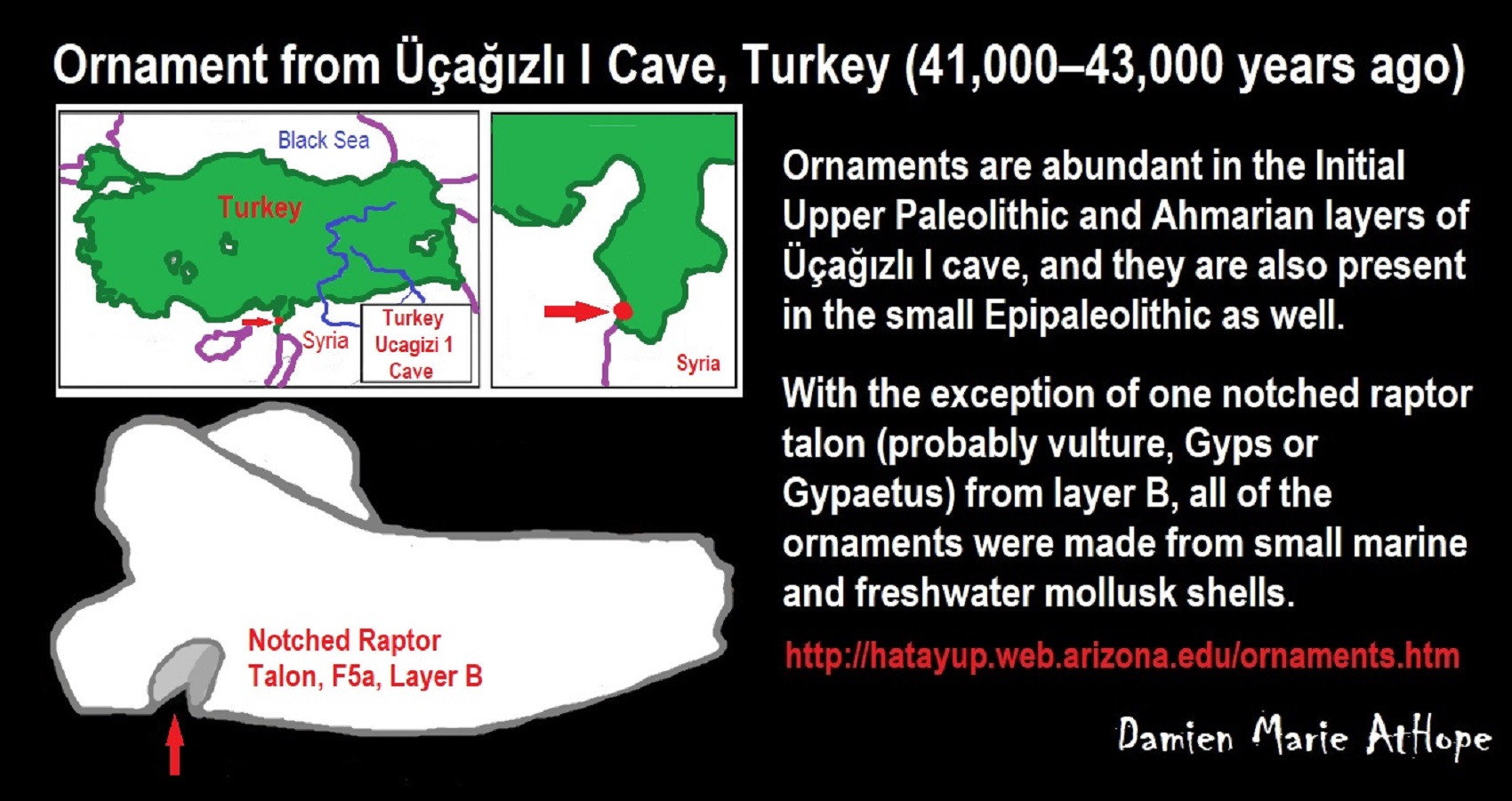
To me, the importance of talon ornaments, like the one in Üçagızlı Cave, “Sky burial”
Ornament from Üçağızlı I Cave, Turkey (41,000–43,000 years ago). ref
The early Upper Paleolithic occupations at Uçagızlı Cave (Hatay, Turkey)
Ornaments at Üçağızlı I Cave, Turkey
Ornaments are abundant in the Initial Upper Paleolithic and Ahmarian layers of Üçağızlı I cave, and they are also present in the small Epipaleolithic as well. With the exception of one notched raptor talon (probably vulture, Gyps or Gypaetus) from layer B, all of the ornaments were made from small marine and freshwater mollusk shells. ref
I think “raptor talon” and use of “bird feathers” could relate to sky burials:
Sky Burials: Animism, Totemism, Shamanism, and Paganism
which have connections to early religious places as:
12,400 – 11,700 Years Ago – Kortik Tepe (Turkey) Pre/early-Agriculture Cultic Ritualism
Gobekli Tepe: “first human made temple” around 12,000 years ago.
Catal Huyuk “first religious designed city” around 9,500 to 7,700 years ago (Turkey)
The Levantine Upper Palaeolithic currently spans some 25,000 years, beginning around 50,000 years ago, and concluding with the shift to the Epi-Palaeolithic at around 23,000 years ago with the onset of the Late Glacial Maximum. It appears that the MP-UP shift occurred between around 48,500-47,000 years ago, corroborating 50,000 years ago for the IUP levels 1-2 at Boker Tachtit. ref
Neanderthals, this work presents new evidence of the deliberate removal of raptor claws occurred in Mediterranean Europe during the recent phases of the Mousterian. Rio Secco Cave in the north-east of Italy and Mandrin Cave in the Middle Rhône valley have recently produced two golden eagle pedal phalanges from contexts not younger than 49.1–48.0 ky cal BP at Rio Secco and dated around 50.0 ky cal BP at Mandrin. The bones show cut-marks located on the proximal end ascribable to the cutting of the tendons and the incision of the cortical organic tissues. Also supported by an experimental removal of large raptor claws, our reconstruction explains that the deliberate detachment occurred without damaging the claw, in a way comparable at a general level with other Mousterian contexts across Europe. ref
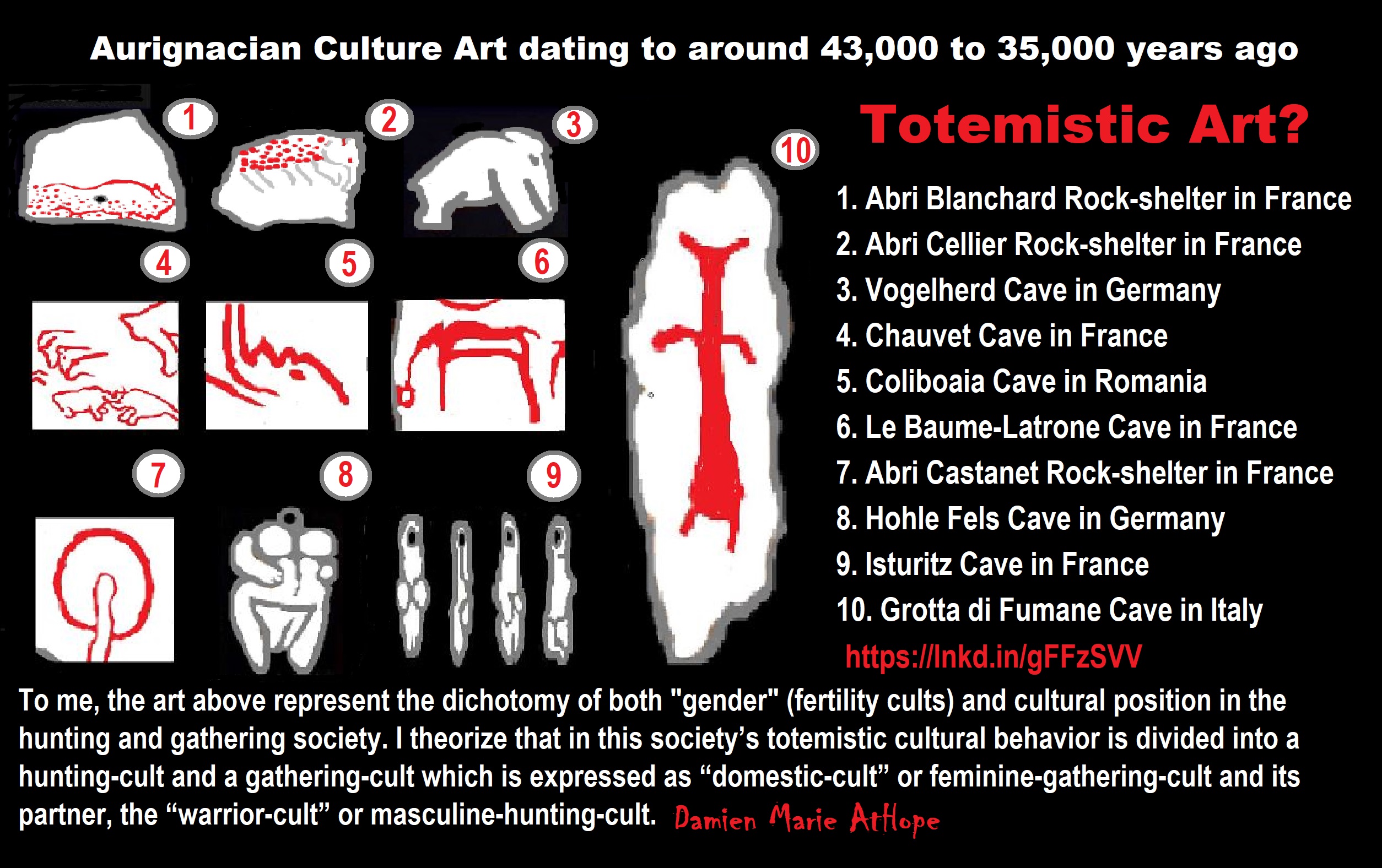

I think the adding of dots could referencing starts, like the sun in day and stats and moon at night or other celestial bodies.
Cave art dated to at least 40,800 years old, was discovered in the Cave of El Castillo, “the cave of castles”, in the Cantabria region of Spain. The El Castillo cave contains a large red stippled disk in the Panel de las Manos dated to more than more than 40,800 years old and is consistent with the tradition of cave painting originating in the Proto-Aurignacian. Modern humans are believed to have also been in the area at the time, arriving about 41,500 years ago. Habitation roughly involves 55 000 to 45 000 years ago there is occupation by Neanderthals. From then 45 000 to 35 000 years ago is a transition period, the first phase of occupation by modern man during the upper Palaeolithic. And it is believed that Aurignacian involves at least three phases of occupation, clearly evident from 35,000 to 30,000 when it turns to Gravettian seeming to involve two phases of occupation from around 30,000 to 25,000 years ago. Followed by Magdalenian, with two phases of occupation dated to around 20 000 to 15 000 years ago. ref, ref
34,000 years ago Lunar Calendar Cave art around the Time Shift From Totemism to Early Shamanism
Could the Phallus Phenomena (A Bull Horn) and the Shamanism Phenomena beginning around 30,000 years ago or its elements

Images of wild cattle that scientists have dated to at least 40,000 years old in Borneo cave Above and between the three beasts are hand stencils. The animal is one of a trio of large creatures that adorn a wall in the Lubang Jeriji Saléh cave in the East Kalimantan province of Indonesian Borneo. If the measurement is accurate the Borneo paintings maybe 4,500 years older than depictions of animals that adorn cave walls on the neighboring island of Sulawesi. But there is room for doubt. Writing in the journal Nature, the researchers concede that the crusts they analyzed had formed on top of a heavily weathered part of the animal painting and that pigment analyses could not distinguish the underlying paint from that of a nearby mulberry-colored hand stencil. Cave art in East Kalimantan can be grouped into three distinct phases. The oldest includes the reddish-orange hand stencils and animal paintings that mostly appear to depict Bornean banteng, the wild cattle still found on the island. The next phase consists of younger hand stencils, intricate motifs and symbols, and depictions of elegant, thread-like people, some wearing elaborate headdresses, some apparently dancing, painted in dark purple or mulberry on the cave walls. ref
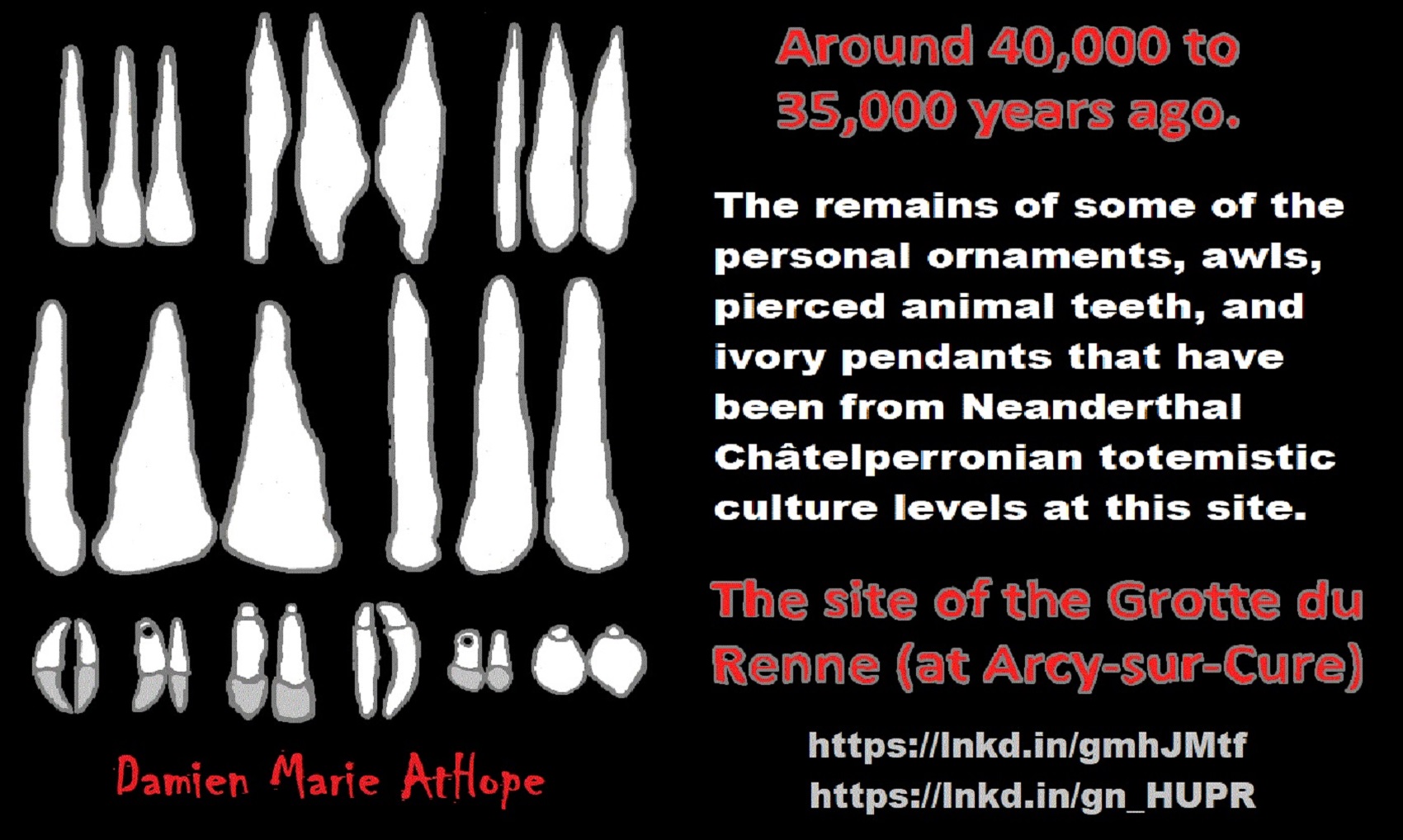
Grotte du Renne: “The Grotte du Renne (French for “Reindeer’s cave“) is one of the many caves at Arcy-sur-Cure in France, an archaeological site of the Middle/Upper Paleolithic period in the Yonne departement, Bourgogne-Franche-Comté. It contains Châtelperronian lithic industry and Neanderthal remains. Grotte du Renne has been argued to provide the best evidence that Neanderthals developed aspects of modern behavior before contact with modern humans, but this has been challenged by radiological dates, which suggest mixing of later human artifacts with Neanderthal remains. However, it has also been argued that the radiometric dates have been affected by post-recovery contamination, and statistical testing suggests the association between Neanderthal remains, Châtelperronian artifacts, and personal ornaments is genuine, not the result of post-depositional processes.” ref
“The French site of the Grotte du Renne at Arcy-sur-Cure (Yonne) is critical to discussions regarding the nature of the transition from the Middle to Upper Paleolithic in Europe and the interaction between Neanderthals and anatomically modern humans (AMH) in the period leading up to Neanderthal extinction. The remains of personal ornaments, rings, pierced animal teeth, and ivory pendants have been excavated from the Châtelperronian levels at this site (Fig. 1). This is, with the exception of the poorly documented site of Quinçay, a unique association. The presence of 29 Neanderthal teeth and a temporal bone has added support to the association of the Châtelperronian with Neanderthals, a link also documented at the French site of St. Césaire (Charente-Maritime).” ref
“Personal ornaments have often been associated with the beginnings of symbolic “modern” human behavior. The earliest evidence for such activity has been linked with AMH in southern Africa, the Levant, and northwestern Africa from ≈75,000–90,000 years ago or older, despite few associated fossil hominid remains. In Europe, the presence of personal ornaments is documented later in Aurignacian horizons. This industry is often linked with the initial dispersal of AMH into Europe around 35,000–40,000 B.P., albeit, again, with scant human fossil evidence. The discovery of ornaments in Neanderthal contexts at the Grotte du Renne (Fig. 1) has been explained as reflecting a phase of acculturation, when Neanderthals in France copied or mimicked the behavior of incoming AMH during a period of contemporaneity before their extinction. An alternative model, however, posits the independent localized development of complex symbolic behavior by Neanderthals in Western Europe before the arrival of AMH. Material from the Grotte du Renne is at the very center of these models.” ref
“Two important variables contribute to establishing the relationship between the Châtelperronian and Aurignacian: stratigraphic context and a reliable chronometric framework. Although the second variable has been almost completely lacking, stratigraphic evidence suggests that the Châtelperronian is always found beneath Proto- or Early Aurignacian archaeological horizons (albeit with some debated instances of purported “interstratification” between the two). Establishing a substantially earlier date for the Châtelperronian would provide strong support for independent Neanderthal development of some aspects of modern behavior before the arrival of modern humans in Western Europe. The reverse, or a more or less contemporaneous occurrence of the two, would favor an acculturation model on the basis of parsimony, because the appearance of symbolic behavior among Neanderthals at precisely the same time as the arrival of modern humans would amount to what Mellars has termed “an impossible coincidence.” ref
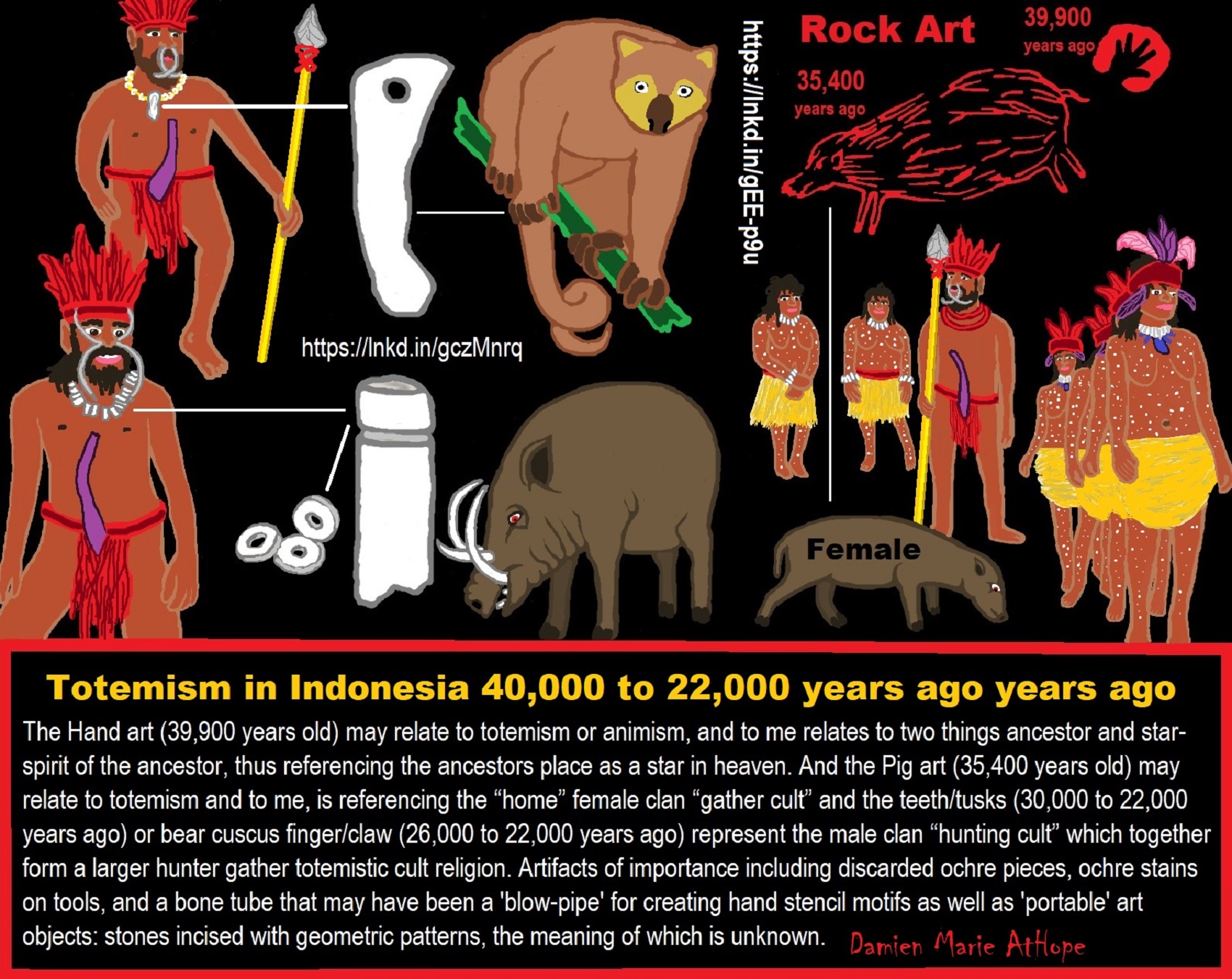
While humans seem to first settle in East Timor 42,000 years ago and a 39,900 years old hand stencil that is from the Leang Timpuseng Cave on the Island of Sulawesi in Indonesia also includes some of the most ancient animal paintings, all made by Aborigine migrants who were probably heading for Australia. and the image of the “pig-deer” at the Sulawesi Cave, Indonesia, dating to as old as 35,400 years ago. ref, ref, ref
Then there is a 39,900 years old hand stencil that is from the Leang Timpuseng Cave on the Island of Sulawesi. The site also includes some of the most ancient animal paintings, all made by Aborigine migrants who were probably heading for Australia. Humans first settled in East Timor 42,000 years ago. Descendants of at least three waves of migration are believed still to live in East Timor. The first is described by anthropologists as people of the Veddo–Australoid type. Cave Paintings in East Kalimantan (Borneo) Indonesia, which is to the south and east are islands of Indonesia: Java and Sulawesi., and before sea levels rose at the end of the last Ice Age, Borneo was part of the mainland of Asia with Java and Sumatra.
The first group comprises two caves situated in the middle of a cliff about 30 meters apart. They contain roughly 60 hand stencils concentrated in only two to three panels. The disposition of the stencils indicates the panels intentionally organized. The other group, 80 km westwards, comprises three large chambers with at least 200 figures including more than 140 handprints. More than 20 of them have anthropo-and zoo-morphic features in the form of linear or punctuated marks inside the stencil blanks. Moreover, painted on the roof of a “laminoir”, about one meter high, three bovine figures larger than one meter are to be seen.
They seem to be clear representations of an almost-vanished wild small cow. The next two features appear to be deer involved in a hunting scene and are associated with some pairs of hand stencils. Some handprints have internal linear tracks evoking tattooing figures like those still executed by Mentawi communities in the Siberut Islands (South Sumatra), as well as the “
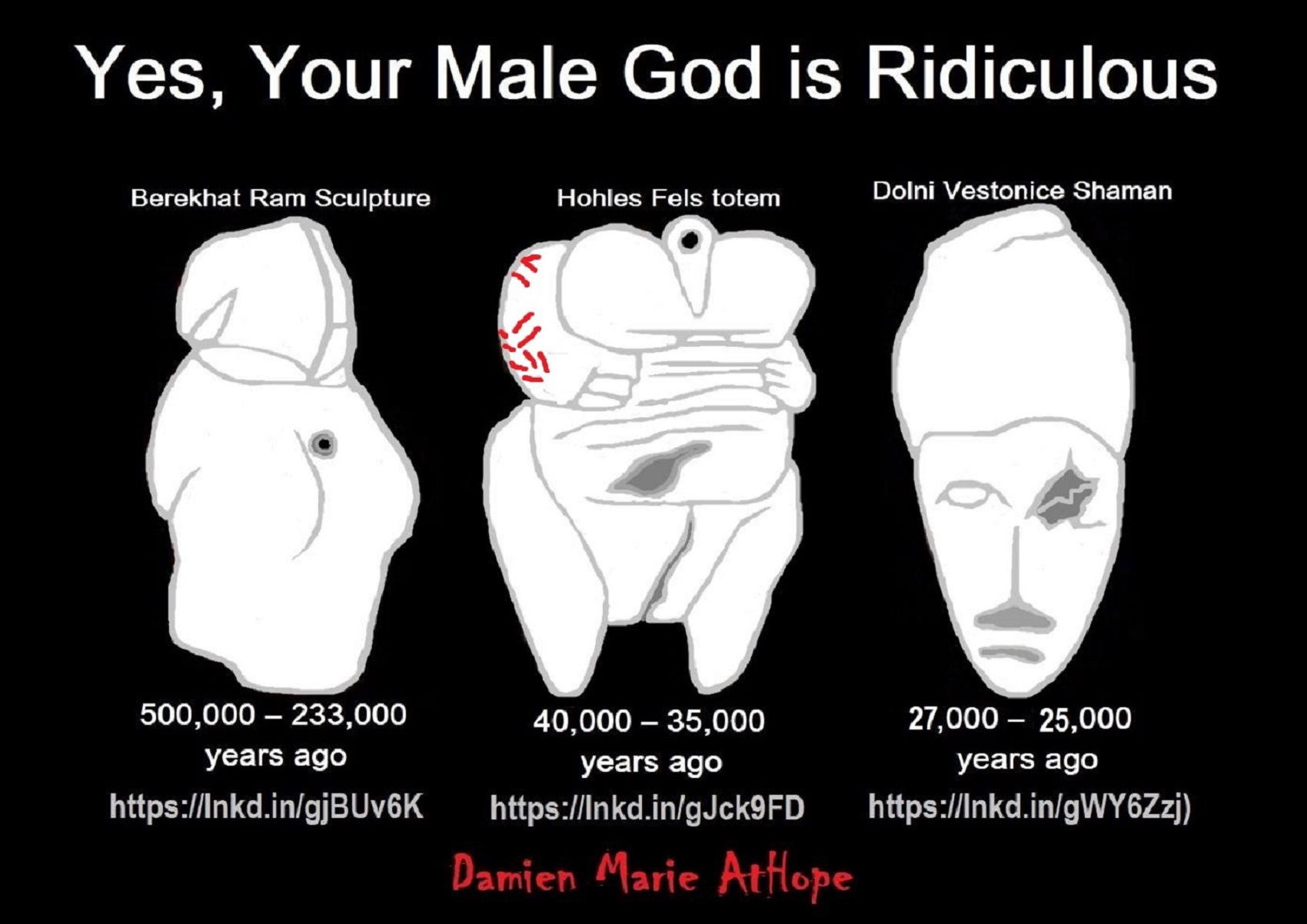
Ref: Insoll, T. (2012). The Oxford handbook of the archaeology of ritual and religion. Oxford, United Kingdom. Oxford University Press.
The Venus of Hohle Fels, is an Upper Paleolithic Venus figurine made of mammoth ivory that was located near Schelklingen, Germany. It is dated to between 40,000 to 35,000 years ago and comes from the Aurignacian that was preceded by possibly both Ahmarian, Châtelperronian. It was discovered in September 2008 in a cave at Schelklingen in Baden-Württemberg in western Germany. In place of the head, the figurine has a perforated protrusion, which may have allowed it to be worn as an amulet. The Swabian Alb region of Germany has a number of caves that have yielded many mammoth-ivory artifacts of the Upper Paleolithic period. Approximately twenty-five items have been discovered to date. This concentration of evidence of full behavioral modernity, including figurative art and instrumental music among humans in the period of 40 to 30 thousand years ago, speculates that the bearers of the Aurignacian culture in the Swabian Alb may be credited with the invention, not just of figurative art and music, but possibly, the earliest religious practices as well. Within a distance of 2 feet to the Venus figurine, there was also found a flute made from a vulture bone. Additional artifacts excavated from the same cave layer included flint-knapping debris, worked bone, and carved ivory as well as remains of tarpans, reindeer, cave bears, woolly mammoths, and Alpine Ibexes. ref, ref
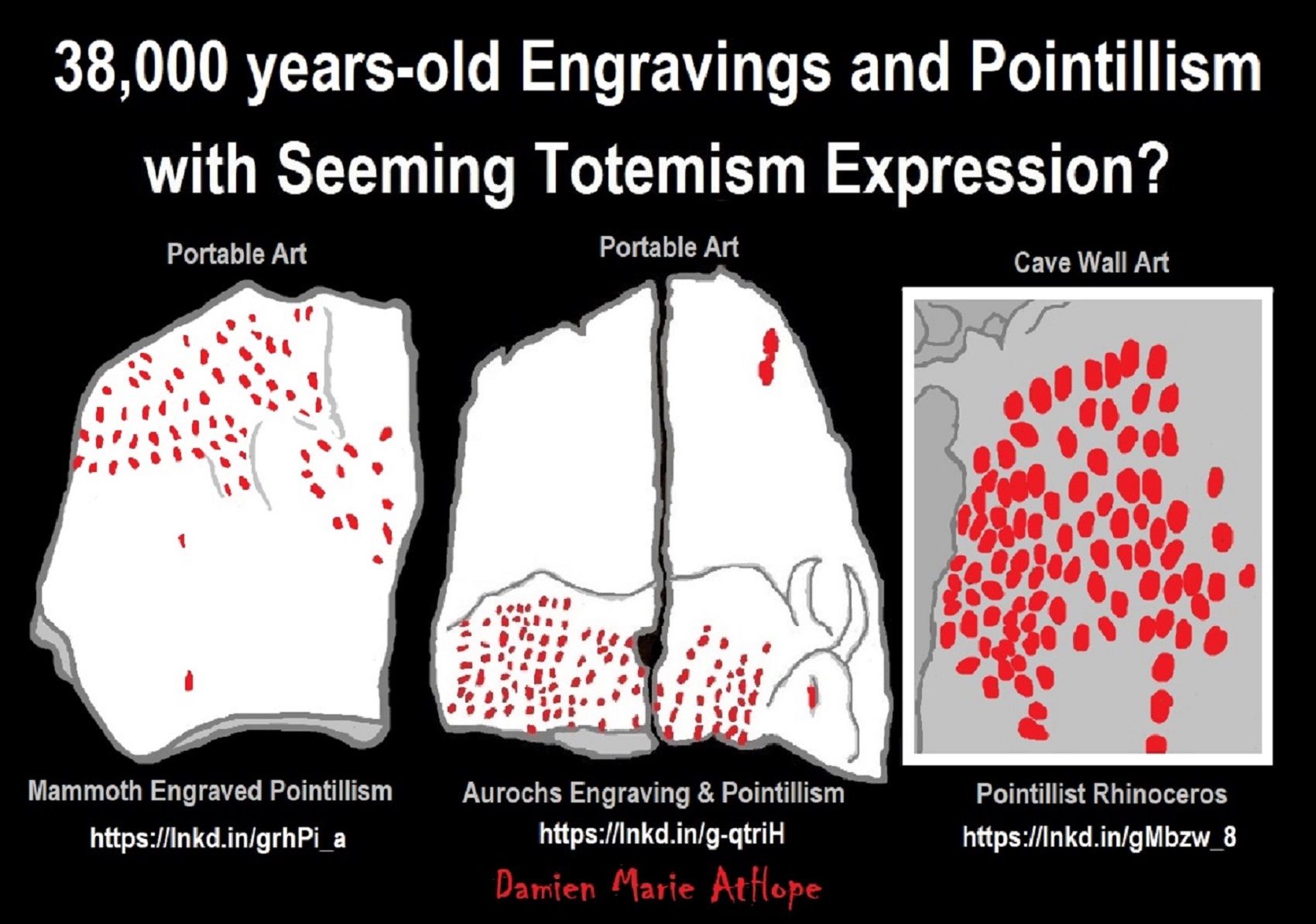
Ritual Pointillism, to me, references stars/ancestor worship in Aurignacian culture totemism, which I think relates to the Neanderthal Châtelperronian culture totemism. There was 16 engraved and otherwise modified limestone blocks, created 38,000 years ago, pointillist techniques: small dots to create the illusion of a larger image. ref

“The Adorant from the Geißenklösterle cave is a 35,000-to-40,000-year-old section of mammoth ivory with a depiction of a human figure, found in the Geißenklösterle cave in the Swabian Jura near Blaubeuren, Germany. The front face has a human figure of uncertain sex in relief, with raised arms and outstretched legs, but no hands. The posture is usually interpreted as an expression of worship, which is why in German the figure is called an “adorant”, a word meaning “worshipper”. It has been claimed that a belt and sword can be seen, although these are probably natural features of the ivory. On the plate’s reverse are rows of small notches. The piece is 38 mm (1.50 in) tall, 14 mm (0.55 in) wide, and 4.5 mm (0.18 in) thick. Traces of manganese and ochre can be found on it by microscope analysis. It is somewhat like the Lion-Human of Hohlenstein-Stadel ivory statue also found in Germany.” ref
“The Löwenmensch figurine, also called the Lion-Human of Hohlenstein-Stadel, is a prehistoric ivory sculpture discovered in Hohlenstein-Stadel, a German cave. The German name, Löwenmensch, meaning “lion-person” or “lion-human”, is used most frequently because it was discovered and is exhibited in Germany. Determined by carbon dating of the layer in which it was found to be between 35,000 and 40,000 years old, it is one of the oldest-known examples of an artistic representation and the oldest confirmed statue ever discovered. Its age associates it with the archaeological Aurignacian culture of the Upper Paleolithic. An example of zoomorphic art, the Lion-Human was carved out of mammoth ivory, using a flint stone knife. Seven parallel, transverse, carved gouges are on the left arm.” ref
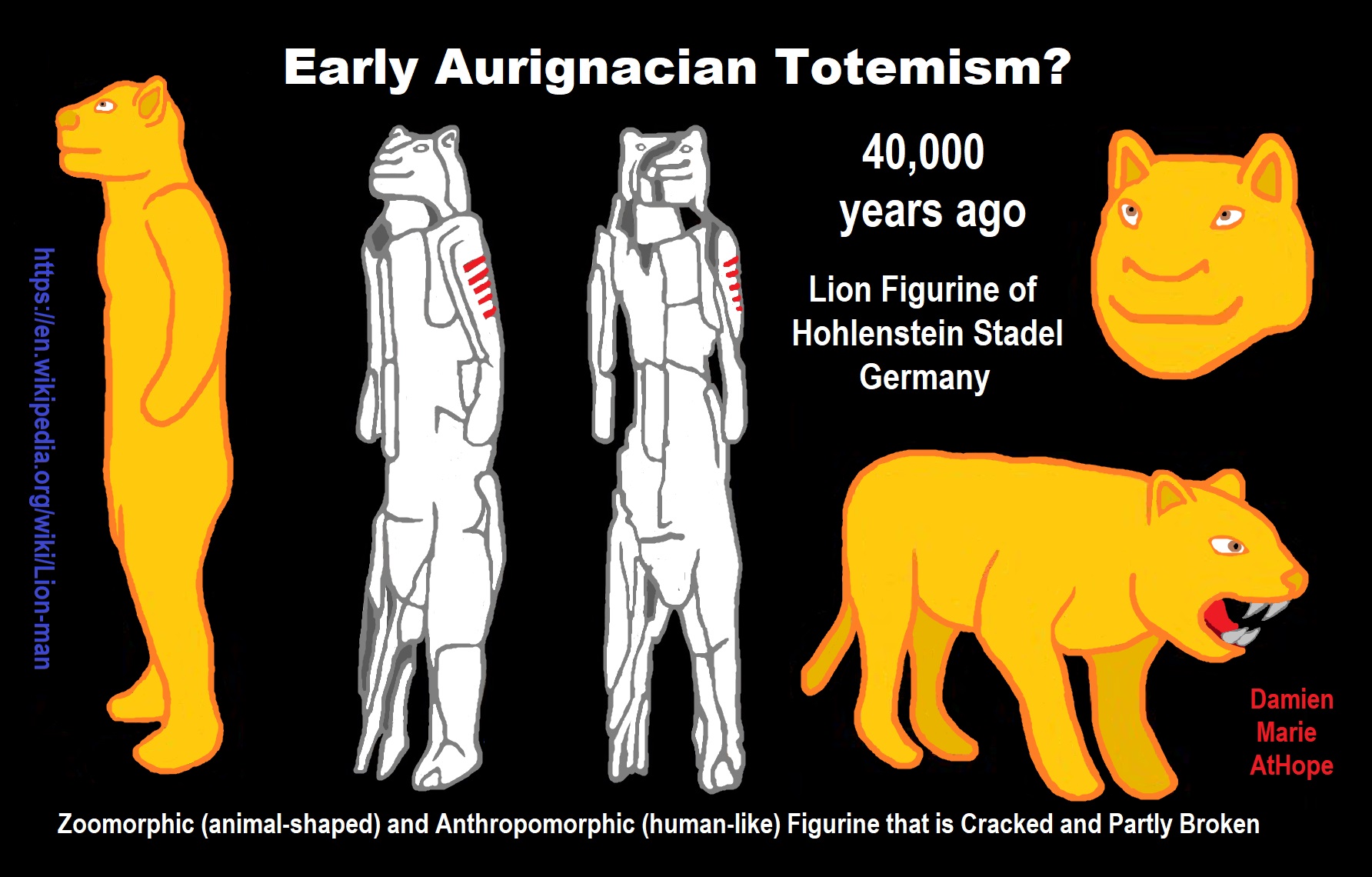
40,000 years old Aurignacian Lion Figurine Early Totemism?
40,000 years old Aurignacian Lion Figurine Early Totemism?

Around 37,500 to 32,500 years old Aurignacian bison skull from Régismont-le-Haut (Hérault). Possibility symbolic or ritualized item and certainly a major animal for them, as shown by the ornamentation of certain caves (for example, the Aurignacian of Chauvet Cave in France. The trophy-head belongs to a male individual. The many depictions of bison in Palaeolithic art back up, the symbolic interpretation as possible. ref

Chauvet cave
“The Chauvet-Pont-d’Arc Cave in the Ardèche department of southeastern France is a cave that contains some of the best-preserved figurative cave paintings in the world, as well as other evidence of Upper Paleolithic life. It is located near the commune of Vallon-Pont-d’Arc on a limestone cliff above the former bed of the river Ardèche, in the Gorges de l’Ardèche. The dates have been a matter of dispute but a study published in 2012 supports placing the art in the Aurignacian period, approximately 32,000–30,000 years ago. A study published in 2016 using additional 88 radiocarbon dates showed two periods of habitation, one from 37,000 to 33,500 years ago and the second from 31,000 to 28,000 years ago, with most of the black drawings dating to the earlier period.” ref
“Hundreds of animal paintings have been cataloged, depicting at least 13 different species, including some rarely or never found in other ice age paintings. Rather than depicting only the familiar herbivores that predominate in Paleolithic cave art, i.e. horses, aurochs, mammoths, etc., the walls of the Chauvet Cave feature many predatory animals, e.g., cave lions, leopards, bears, and cave hyenas. There are also paintings of rhinoceroses. Typical of most cave art, there are no paintings of complete human figures, although there is one partial “Venus” figure composed of what appears to be a vulva attached to an incomplete pair of legs. Above the Venus, and in contact with it, is a bison head, which has led some to describe the composite drawing as a Minotaur. There are a few panels of red ochre hand prints and hand stencils made by blowing pigment over hands pressed against the cave surface. Abstract markings—lines and dots—are found throughout the cave. There are also two unidentifiable images that have a vaguely butterfly or avian shape to them. This combination of subjects has led some students of prehistoric art and cultures to believe that there was a ritual, shamanic, or magical aspect to these paintings.” ref
“One drawing, later overlaid with a sketch of a deer, is reminiscent of a volcano spewing lava, similar to the regional volcanoes that were active at the time. If confirmed, this would represent the earliest known drawing of a volcanic eruption. The artists who produced these paintings used techniques rarely found in other cave art. Many of the paintings appear to have been made only after the walls were scraped clear of debris and concretions, leaving a smoother and noticeably lighter area upon which the artists worked. Similarly, a three-dimensional quality and the suggestion of movement are achieved by incising or etching around the outlines of certain figures. The art is also exceptional for its time for including “scenes”, e.g., animals interacting with each other; a pair of woolly rhinoceroses, for example, are seen butting horns in an apparent contest for territory or mating rights.” ref
Aurignacian burials (around 37,000-30,000 years ago) belong to the early phase of this period in Europe. Examples have been excavated at Cave of Cavillon, Liguria – a burial wearing a cap of netted whelk shells with a border of deer’s teeth, red ochre around the face, and a bone awl at the side. ref
Aurignacian in the Zagros region dates back to about 35,500 years ago at Yafteh Cave, Lorestan, Iran. ref

34,000 years ago Lunar Calendar Cave art around the Time Shift From Totemism to Early Shamanism?
“The Oldest Lunar Calendars and Earliest Constellations have been identified in cave art found in France and Germany. The astronomer-priests of these late Upper Paleolithic Cultures understood mathematical sets, and the interplay between the moon annual cycle, ecliptic, solstice and seasonal changes on earth. The archaeological record’s earliest data that speaks to human awareness of the stars and ‘heavens’ dates to the Aurignacian Culture of Europe, around 34,000 years ago. Between 1964 and the early 1990s, Alexander Marshack published breakthrough research that documented the mathematical and astronomical knowledge in the Late Upper Paleolithic Cultures of Europe. Marshack deciphered sets of marks carved into animal bones, and occasionally on the walls of caves, as records of the lunar cycle. These marks are sets of crescents or lines. Artisans carefully controlled line thickness so that a correlation with lunar phases would be as easy as possible to perceive. Sets of marks were often laid out in a serpentine pattern that suggests a snake deity or streams and rivers. Many of these lunar calendars were made on small pieces of stone, bone or antler so that they could be easily carried. These small, portable, lightweight lunar calendars were easily carried on extended journeys such as long hunting trips and seasonal migrations.” ref
“Hunting the largest animals was arduous, and might require hunters to follow herds of horses, bison, mammoth or ibex for many weeks. (Other big animals such as the auroch, cave bear and cave lion were well known but rarely hunted for food because they had a special status in the mythic realm. The Auroch is very important to the search for earliest constellations.) The phases of the moon depicted in these sets of marks are inexact. Precision was impossible unless all nights were perfectly clear which is an unrealistic expectation. The arithmetic counting skill implied by these small lunar calendars is obvious. The recognition that there are phases of the moon and seasons of the year that can be counted – that should be counted because they are important – is profound. “All animal activities are time factored, simply because time passes, the future is forever arriving. The reality of time factoring is objective physics and does not depend upon human awareness or consciousness. Until Marshack’s work, many archeologists believed the sets of marks he chose to study were nothing but the aimless doodles of bored toolmakers. What Marshack uncovered is the intuitive discovery of mathematical sets and the application of those sets to the construction of a calendar.” Bone is the preferred medium because it allows for easy transport and a long calendar lifetime. Mankind’s earliest astronomy brought the clan into the multi-dimensional universe of the gods. Objects used in the most potent rituals had the highest contextual, cultural value and were treated with great reverence.” ref
“Regarding the Aurignacian, between 43,000 and 35,000 years ago, the archaeological record from habitations is relatively poor in the Ardèche (Abri des Pécheurs, Grotte du Figuier) while appearing more abundant in the Languedoc (La Salpétrière, La Balauzière, Esquicho-Grapaou, La Laouza etc.). The same applies to the sites of the early phases of the Gravettian. During climatic fluctuations, and unlike the deep caves such as Chauvet, the porch and shelter fills seem to have better recorded the cold episodes than the humid phases. To date, 20 decorated caves are indexed in the gorges of the Ardèche and nearby; in other words as far as the valley of the Gardon (Baume-Latrone). This group includes several important caves (Ebbou, Oulen, Émilie etc.) which are not precisely dated and were judged to be of secondary importance until the discovery of the Chauvet Cave.” ref
“A 10,000-year-old engraved stone could be a lunar calendar. The rare pebble — found high up in the mountains near Rome, Italy, the hammer-stone was found on top of Monte Alta in the Alban Hills. It’s believed that our early ancestors would’ve used the stone to keep track of the moon’s cycles. Notches were engraved “as if they were being used to count, calculate or store the record of some kind of information. And these notches — which total either 27 or 28 — suggest the stone’s engraver used the pebble to track lunar cycles.” ref
“Archaeologists excavating in Scotland found a series of huge pits were dug by Mesolithic people to track the cycle of the Moon. They found a series of twelve huge, specially shaped pits designed to mimic the various phases of the Moon. The holes aligned perfectly on the midwinter solstice to help the hunter-gathers of Mesolithic Britain keep precise track of the passage of the seasons and the lunar cycle. The holes were dug in the shapes of various phases of the moon. “Waxing, waning, crescents, and gibbous, they’re all there and arranged in a 50-meter-long (164-foot) arc. The one representing the full moon is large and circular, approximately two meters (roughly seven feet) across, and placed right in the center. And this arc is arranged perfectly with a notch in the landscape where the sun would have risen on the day of the midwinter solstice about 10,000 years ago. Placing their calendar in the landscape the way they did would have let the people who built it to recalibrate the lunar months every winter to bring their lunar calendar in line with the solar year. This means that any effort to keep track of the seasons using the moon alone will slowly drift ever further from true. An observer needs to know when to add or subtract an extra month to make good the time or hit the reset button and start counting again.” ref
“A moon-shaped calendar was found in Smederevska Palanka, Serbia that dates back 8,000 years, and is made from a wild boar’s tusk engraved with markings to denote a lunar cycle. Farmers may have used the device to plan when to plant crops. It is made from the tusk of a wild boar and is marked with engravings thought to denote a lunar cycle of 28 days, as well as the four phases of the moon.” ref
“A lunisolar calendar was found at Warren Field in Scotland and has been dated to c. 8000 BCE, during the Mesolithic period. Some scholars argue for lunar calendars still earlier—Rappenglück in the marks on a c. 17,000-year-old cave painting at Lascaux and Marshack in the marks on a c. 27,000-year-old bone baton—but their findings remain controversial. Scholars have argued that ancient hunters conducted regular astronomical observations of the Moon back in the Upper Palaeolithic. Samuel L. Macey dates the earliest uses of the Moon as a time-measuring device back to 28,000–30,000 years ago.” ref
“A lunar calendar is a calendar based on the monthly cycles of the Moon‘s phases (synodic months, lunations), in contrast to solar calendars, whose annual cycles are based only directly on the solar year. The most commonly used calendar, the Gregorian calendar, is a solar calendar system that originally evolved out of a lunar calendar system. A purely lunar calendar is also distinguished from a lunisolar calendar, whose lunar months are brought into alignment with the solar year through some process of intercalation. The details of when months begin varies from calendar to calendar, with some using new, full, or crescent moons and others employing detailed calculations.” ref
“Since each lunation is approximately 29+1⁄2 days, it is common for the months of a lunar calendar to alternate between 29 and 30 days. Since the period of 12 such lunations, a lunar year, is 354 days, 8 hours, 48 minutes, 34 seconds (354.36707 days), purely lunar calendars are 11 to 12 days shorter than the solar year. In purely lunar calendars, which do not make use of intercalation, like the Islamic calendar, the lunar months cycle through all the seasons of a solar year over the course of a 33–34 lunar-year cycle.” ref
“Although the Gregorian calendar is in common and legal use in most countries, traditional lunar and lunisolar calendars continue to be used throughout the world to determine religious festivals and national holidays. Such holidays include Rosh Hashanah (Hebrew calendar); Easter (the Computus); the Chinese, Korean, Vietnamese, and Mongolian New Year (Chinese, Korean, Vietnamese, and Mongolian calendars, respectively); the Nepali New Year (Nepali calendar); the Mid-Autumn Festival and Chuseok (Chinese and Korean calendars); Loi Krathong (Thai calendar); Sunuwar calendar; Vesak/Buddha’s Birthday (Buddhist calendar); Diwali (Hindu calendars); Ramadan, Eid al-Fitr and Eid al-Adha (Islamic calendar).” ref
“The Japanese Calendar formerly used both the lunar and lunisolar calendar before it was replaced by the Gregorian Calendar during the Meiji government in 1872. Holidays such as the Japanese New Year were simply transposed on top as opposed to being calculated like other countries that use the lunisolar and Gregorian calendars together, for example, the Japanese New Year now falls on January 1, creating a month delay as opposed to other East Asian Countries. See customary issues in modern Japan.” ref
“Most calendars referred to as “lunar” calendars are in fact lunisolar calendars. Their months are based on observations of the lunar cycle, with intercalation being used to bring them into general agreement with the solar year. The solar “civic calendar” that was used in ancient Egypt showed traces of its origin in the earlier lunar calendar, which continued to be used alongside it for religious and agricultural purposes. Present-day lunisolar calendars include the Chinese, Vietnamese, Hindu, and Thai calendars.” ref
“Synodic months are 29 or 30 days in length, making a lunar year of 12 months about 11 to 12 days shorter than a solar year. Some lunar calendars do not use intercalation, for example, the lunar Hijri calendar used by most Muslims. For those that do, such as the Hebrew calendar, and Buddhist Calendars in Myanmar, the most common form of intercalation is to add an additional month every second or third year. Some lunisolar calendars are also calibrated by annual natural events which are affected by lunar cycles as well as the solar cycle. An example of this is the lunar calendar of the Banks Islands, which includes three months in which the edible palolo worms mass on the beaches. These events occur at the last quarter of the lunar month, as the reproductive cycle of the palolos is synchronized with the moon.” ref
“Lunar and lunisolar calendars differ as to which day is the first day of the month. In some lunisolar calendars, such as the Chinese calendar, the first day of a month is the day when an astronomical new moon occurs in a particular time zone. In others, such as some Hindu calendars, each month begins on the day after the full moon. Others are based on the first sighting of the lunar crescent, such as the lunar Hijri calendar (and, historically, the Hebrew calendar).” ref
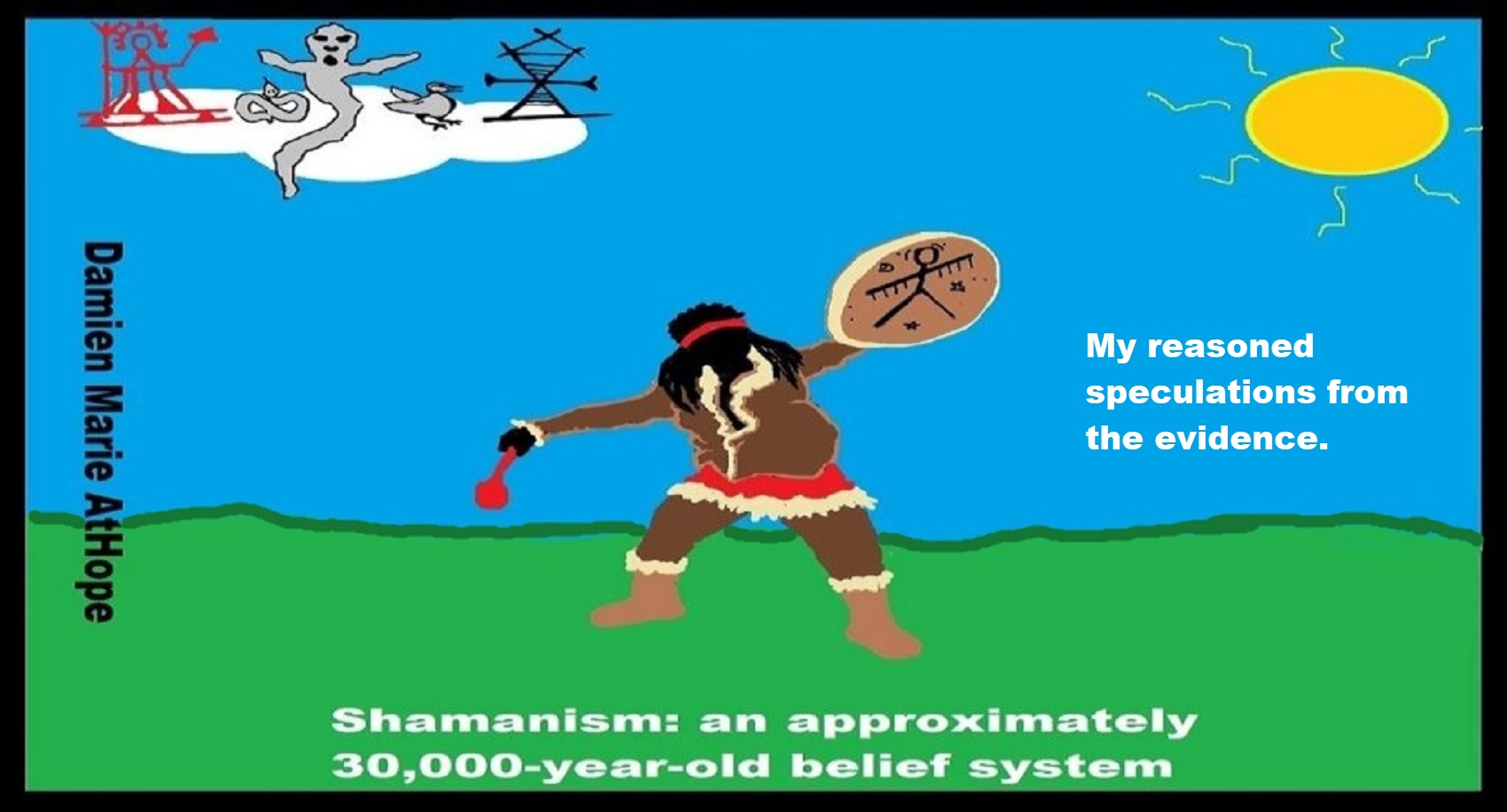
I am an Out Atheist, Antitheist, and Antireligionist as a Valueized Ethical Duty.
How can we silently watch as yet another generation is indoctrinated with religious faith, fear, and foolishness? Religion and it’s god myths are like a spiritually transmitted disease of the mind. This infection even once cured holds mental disruption which can linger on for a lifetime. What proof is “faith,” of anything religion claims by faith, as many people have different faith even in the same religion?
When you start thinking your “out, atheism, antitheism or antireligionism is not vitally needed just remember all the millions of children being indoctrinated and need our help badly. Ones who desperately need our help with the truth. Three things are common in all religions: “pseudo-science,” “pseudo-history,” and “pseudo-morality.”
And my biggest thing of all is the widespread forced indoctrination of children, violating their free choice of what to not believe or believe, I hate forced hereditary religion.
No God: No evidence, No intelligence, and No goodness = Valid Atheism Conclusion
- No evidence, to move past the Atheistic Null Hypothesis: There is no God/Gods (in inferential statistics, a Null Hypothesis generally assumed to be true until evidence indicates otherwise. Thus, a Null Hypothesis is a statistical hypothesis that there is no significant difference reached between the claim and the non-claim, as it is relatively provable/demonstratable in reality some way. “The god question” Null Hypothesis is set at as always at the negative standard: Thus, holding that there is no God/Gods, and as god faith is an assumption of the non-evidentiary wishful thinking non-reality of “mystery thing” found in all god-talk, until it is demonstratable otherwise to change. Alternative hypothesis: There is a God (offered with no proof: what is a god and how can anyone say they know), therefore, results: Insufficient evidence to overturn the null hypothesis of no God/Gods.
- No intelligence, taking into account the reality of the world we do know with 99 Percent Of The Earth’s Species Are Extinct an intelligent design is ridiculous. Five Mass Extinctions Wiped out 99 Percent of Species that have ever existed on earth. Therefore like a child’s report card having an f they need to retake the class thus, profoundly unintelligent design.
- No goodness, assessed through ethically challenging the good god assumptions as seen in the reality of pain and other harm of which there are many to demonstrates either a god is not sufficiently good, not real or as I would assert, god if responsible for this world, would make it a moral monster ripe for the problem of evil and suffering (Argument from Evil). God would be responsible for all pain as life could easily be less painful and yet there is mass suffering. In fact, to me, every child born with diseases from birth scream out against a caring or loving god with the power to do otherwise. It could be different as there is Congenital insensitivity to pain (CIP), also known as congenital analgesia, in which a person cannot feel (and has never felt) physical pain.[1]
Disproof by logical contradiction
‘A Logical Impossibility’
(especially in reductio ad absurdum arguments)
In classical logic, a contradiction consists of a logical incompatibility between two or more propositions. It occurs when the propositions, taken together, yield two conclusions which form the logical, usually opposite inversions of each other. Contradiction by the creation of a paradox, Plato’s Euthydemus dialogue demonstrates the need for the notion of contradiction. – Wikipedia
In the ensuing dialogue, Dionysodorus denies the existence of “contradiction”, all the while that Socrates is contradicting him: “… I in my astonishment said: What do you mean Dionysodorus? I have often heard, and have been amazed to hear, this thesis of yours, which is maintained and employed by the disciples of Protagoras and others before them, and which to me appears to be quite wonderful, and suicidal as well as destructive, and I think that I am most likely to hear the truth about it from you. – Wikipedia
The dictum is that there is no such thing as a falsehood; a man must either say what is true or say nothing. Is not that your position?” Indeed, Dionysodorus agrees that “there is no such thing as a false opinion … there is no such thing as ignorance” and demands of Socrates to “Refute me.” Socrates responds “But how can I refute you, if, as you say, to tell a falsehood is impossible?”. – Wikipedia
To me, there simply is and rightly must be an intellectual “ethical-belief-responsibility” (burden of proof) to justify the believed truth that is claimed to others is actually demonstrably as being true with valid and reliable reason and/or evidence when it is stated as such.Yes, intellectually one should provide (justificationism) for their assertions that map the sort of governing good habits of belief-formation, belief-maintenance, and belief-relinquishment.


Animism: Respecting the Living World by Graham Harvey
“How have human cultures engaged with and thought about animals, plants, rocks, clouds, and other elements in their natural surroundings? Do animals and other natural objects have a spirit or soul? What is their relationship to humans? In this new study, Graham Harvey explores current and past animistic beliefs and practices of Native Americans, Maori, Aboriginal Australians, and eco-pagans. He considers the varieties of animism found in these cultures as well as their shared desire to live respectfully within larger natural communities. Drawing on his extensive casework, Harvey also considers the linguistic, performative, ecological, and activist implications of these different animisms.” ref


My thoughts on Religion Evolution with external links for more info:
- (Pre-Animism Africa mainly, but also Europe, and Asia at least 300,000 years ago), (Pre-Animism – Oxford Dictionaries)
- (Animism Africa around 100,000 years ago), (Animism – Britannica.com)
- (Totemism Europe around 50,000 years ago), (Totemism – Anthropology)
- (Shamanism Siberia around 30,000 years ago), (Shamanism – Britannica.com)
- (Paganism Turkey around 12,000 years ago), (Paganism – BBC Religion)
- (Progressed Organized Religion “Institutional Religion” Egypt around 5,000 years ago), (Ancient Egyptian Religion – Britannica.com)
- (CURRENT “World” RELIGIONS after 4,000 years ago) (Origin of Major Religions – Sacred Texts)
- (Early Atheistic Doubting at least by 2,600 years ago) (History of Atheism – Wikipedia)
“Religion is an Evolved Product” and Yes, Religion is Like Fear Given Wings…
Atheists talk about gods and religions for the same reason doctors talk about cancer, they are looking for a cure, or a firefighter talks about fires because they burn people and they care to stop them. We atheists too often feel a need to help the victims of mental slavery, held in the bondage that is the false beliefs of gods and the conspiracy theories of reality found in religions.
Understanding Religion Evolution:
- Pre-Animism (at least 300,000 years ago)
- Animism (Africa: 100,000 years ago)
- Totemism (Europe: 50,000 years ago)
- Shamanism (Siberia: 30,000 years ago)
- Paganism (Turkey: 12,000 years ago)
- Progressed organized religion (Egypt: 5,000 years ago), (Egypt, the First Dynasty 5,150 years ago)
- CURRENT “World” RELIGIONS (after 4,000 years ago)
- Early Atheistic Doubting (at least by 2,600 years ago)
“An Archaeological/Anthropological Understanding of Religion Evolution”
It seems ancient peoples had to survived amazing threats in a “dangerous universe (by superstition perceived as good and evil),” and human “immorality or imperfection of the soul” which was thought to affect the still living, leading to ancestor worship. This ancestor worship presumably led to the belief in supernatural beings, and then some of these were turned into the belief in gods. This feeble myth called gods were just a human conceived “made from nothing into something over and over, changing, again and again, taking on more as they evolve, all the while they are thought to be special,” but it is just supernatural animistic spirit-belief perceived as sacred.
Quick Evolution of Religion?
Pre-Animism (at least 300,000 years ago) pre-religion is a beginning that evolves into later Animism. So, Religion as we think of it, to me, all starts in a general way with Animism (Africa: 100,000 years ago) (theoretical belief in supernatural powers/spirits), then this is physically expressed in or with Totemism (Europe: 50,000 years ago) (theoretical belief in mythical relationship with powers/spirits through a totem item), which then enlists a full-time specific person to do this worship and believed interacting Shamanism (Siberia/Russia: 30,000 years ago) (theoretical belief in access and influence with spirits through ritual), and then there is the further employment of myths and gods added to all the above giving you Paganism (Turkey: 12,000 years ago) (often a lot more nature-based than most current top world religions, thus hinting to their close link to more ancient religious thinking it stems from). My hypothesis is expressed with an explanation of the building of a theatrical house (modern religions development). Progressed organized religion (Egypt: 5,000 years ago) with CURRENT “World” RELIGIONS (after 4,000 years ago).
Historically, in large city-state societies (such as Egypt or Iraq) starting around 5,000 years ago culminated to make religion something kind of new, a sociocultural-governmental-religious monarchy, where all or at least many of the people of such large city-state societies seem familiar with and committed to the existence of “religion” as the integrated life identity package of control dynamics with a fixed closed magical doctrine, but this juggernaut integrated religion identity package of Dogmatic-Propaganda certainly did not exist or if developed to an extent it was highly limited in most smaller prehistoric societies as they seem to lack most of the strong control dynamics with a fixed closed magical doctrine (magical beliefs could be at times be added or removed). Many people just want to see developed religious dynamics everywhere even if it is not. Instead, all that is found is largely fragments until the domestication of religion.
Religions, as we think of them today, are a new fad, even if they go back to around 6,000 years in the timeline of human existence, this amounts to almost nothing when seen in the long slow evolution of religion at least around 70,000 years ago with one of the oldest ritual worship. Stone Snake of South Africa: “first human worship” 70,000 years ago. This message of how religion and gods among them are clearly a man-made thing that was developed slowly as it was invented and then implemented peace by peace discrediting them all. Which seems to be a simple point some are just not grasping how devastating to any claims of truth when we can see the lie clearly in the archeological sites.
I wish people fought as hard for the actual values as they fight for the group/clan names political or otherwise they think support values. Every amount spent on war is theft to children in need of food or the homeless kept from shelter.
Here are several of my blog posts on history:
- To Find Truth You Must First Look
- (Magdalenian/Iberomaurusian) Connections to the First Paganists of the early Neolithic Near East Dating from around 17,000 to 12,000 Years Ago
- Natufians: an Ancient People at the Origins of Agriculture and Sedentary Life
- Possible Clan Leader/Special “MALE” Ancestor Totem Poles At Least 13,500 years ago?
- Jewish People with DNA at least 13,200 years old, Judaism, and the Origins of Some of its Ideas
- Baltic Reindeer Hunters: Swiderian, Lyngby, Ahrensburgian, and Krasnosillya cultures 12,020 to 11,020 years ago are evidence of powerful migratory waves during the last 13,000 years and a genetic link to Saami and the Finno-Ugric peoples.
- The Rise of Inequality: patriarchy and state hierarchy inequality
- Fertile Crescent 12,500 – 9,500 Years Ago: fertility and death cult belief system?
- 12,400 – 11,700 Years Ago – Kortik Tepe (Turkey) Pre/early-Agriculture Cultic Ritualism
- Ritualistic Bird Symbolism at Gobekli Tepe and its “Ancestor Cult”
- Male-Homosexual (female-like) / Trans-woman (female) Seated Figurine from Gobekli Tepe
- Could a 12,000-year-old Bull Geoglyph at Göbekli Tepe relate to older Bull and Female Art 25,000 years ago and Later Goddess and the Bull cults like Catal Huyuk?
- Sedentism and the Creation of goddesses around 12,000 years ago as well as male gods after 7,000 years ago.
- Alcohol, where Agriculture and Religion Become one? Such as Gobekli Tepe’s Ritualistic use of Grain as Food and Ritual Drink
- Neolithic Ritual Sites with T-Pillars and other Cultic Pillars
- Paganism: Goddesses around 12,000 years ago then Male Gods after 7,000 years ago
- First Patriarchy: Split of Women’s Status around 12,000 years ago & First Hierarchy: fall of Women’s Status around 5,000 years ago.
- Natufians: an Ancient People at the Origins of Agriculture and Sedentary Life
- J DNA and the Spread of Agricultural Religion (paganism)
- Paganism: an approximately 12,000-year-old belief system
- Paganism 12,000 years old: related to “Anarchism and Socialism” (Pre-Capitalism)
- Shaman burial in Israel 12,000 years ago and the Shamanism Phenomena
- Need to Mythicized: gods and goddesses
- 12,000 – 7,000 Years Ago – Paleo-Indian Culture (The Americas)
- 12,000 – 2,000 Years Ago – Indigenous-Scandinavians (Nordic)
- Norse did not wear helmets with horns?
- Pre-Pottery Neolithic Skull Cult around 11,500 to 8,400 Years Ago?
- 10,400 – 10,100 Years Ago, in Turkey the Nevail Cori Religious Settlement
- 9,000-6,500 Years Old Submerged Pre-Pottery/Pottery Neolithic Ritual Settlements off Israel’s Coast
- Catal Huyuk “first religious designed city” around 9,500 to 7,700 years ago (Turkey)
- Cultic Hunting at Catal Huyuk “first religious designed city”
- Special Items and Art as well as Special Elite Burials at Catal Huyuk
- New Rituals and Violence with the appearance of Pottery and People?
- Haplogroup N and its related Uralic Languages and Cultures
- Ainu people, Sámi people, Native Americans, the Ancient North Eurasians, and Paganistic-Shamanism with Totemism
- Ideas, Technology and People from Turkey, Europe, to China and Back again 9,000 to 5,000 years ago?
- First Pottery of Europe and the Related Cultures
- 9,000 years old Neolithic Artifacts Judean Desert and Hills Israel
- 9,000-7,000 years-old Sex and Death Rituals: Cult Sites in Israel, Jordan, and the Sinai
- 9,000-8500 year old Horned Female shaman Bad Dürrenberg Germany
- Neolithic Jewelry and the Spread of Farming in Europe Emerging out of West Turkey
- 8,600-year-old Tortoise Shells in Neolithic graves in central China have Early Writing and Shamanism
- Swing of the Mace: the rise of Elite, Forced Authority, and Inequality begin to Emerge 8,500 years ago?
- Migrations and Changing Europeans Beginning around 8,000 Years Ago
- My “Steppe-Anatolian-Kurgan hypothesis” 8,000/7,000 years ago
- Around 8,000-year-old Shared Idea of the Mistress of Animals, “Ritual” Motif
- Pre-Columbian Red-Paint (red ochre) Maritime Archaic Culture 8,000-3,000 years ago
- 7,522-6,522 years ago Linear Pottery culture which I think relates to Arcane Capitalism’s origins
- Arcane Capitalism: Primitive socialism, Primitive capital, Private ownership, Means of production, Market capitalism, Class discrimination, and Petite bourgeoisie (smaller capitalists)
- 7,500-4,750 years old Ritualistic Cucuteni-Trypillian culture of Moldova, Romania, and Ukraine
- Roots of a changing early society 7,200-6,700 years ago Jordan and Israel
- Agriculture religion (Paganism) with farming reached Britain between about 7,000 to 6,500 or so years ago and seemingly expressed in things like Western Europe’s Long Barrows
- My Thoughts on Possible Migrations of “R” DNA and Proto-Indo-European?
- “Millet” Spreading from China 7,022 years ago to Europe and related Language may have Spread with it leading to Proto-Indo-European
- Proto-Indo-European (PIE), ancestor of Indo-European languages: DNA, Society, Language, and Mythology
- The Dnieper–Donets culture and Asian varieties of Millet from China to the Black Sea region of Europe by 7,022 years ago
- Kurgan 6,000 years ago/dolmens 7,000 years ago: funeral, ritual, and other?
- 7,020 to 6,020-year-old Proto-Indo-European Homeland of Urheimat or proposed home of their Language and Religion
- Ancient Megaliths: Kurgan, Ziggurat, Pyramid, Menhir, Trilithon, Dolman, Kromlech, and Kromlech of Trilithons
- The Mytheme of Ancient North Eurasian Sacred-Dog belief and similar motifs are found in Indo-European, Native American, and Siberian comparative mythology
- Elite Power Accumulation: Ancient Trade, Tokens, Writing, Wealth, Merchants, and Priest-Kings
- Sacred Mounds, Mountains, Kurgans, and Pyramids may hold deep connections?
- Between 7,000-5,000 Years ago, rise of unequal hierarchy elite, leading to a “birth of the State” or worship of power, strong new sexism, oppression of non-elites, and the fall of Women’s equal status
- Paganism 7,000-5,000 years old: related to “Anarchism and Socialism” (Capitalism) (World War 0) Elite & their slaves
- Hell and Underworld mythologies starting maybe as far back as 7,000 to 5,000 years ago with the Proto-Indo-Europeans?
- The First Expression of the Male God around 7,000 years ago?
- White (light complexion skin) Bigotry and Sexism started 7,000 years ago?
- Around 7,000-year-old Shared Idea of the Divine Bird (Tutelary and/or Trickster spirit/deity), “Ritual” Motif
- Nekhbet an Ancient Egyptian Vulture Goddess and Tutelary Deity
- 6,720 to 4,920 years old Ritualistic Hongshan Culture of Inner Mongolia with 5,000-year-old Pyramid Mounds and Temples
- First proto-king in the Balkans, Varna culture around 6,500 years ago?
- 6,500–5,800 years ago in Israel Late Chalcolithic (Copper Age) Period in the Southern Levant Seems to Express Northern Levant Migrations, Cultural and Religious Transfer
- KING OF BEASTS: Master of Animals “Ritual” Motif, around 6,000 years old or older…
- Around 6000-year-old Shared Idea of the Solid Wheel & the Spoked Wheel-Shaped Ritual Motif
- “The Ghassulian Star,” a mysterious 6,000-year-old mural from Jordan; a Proto-Star of Ishtar, Star of Inanna or Star of Venus?
- Religious/Ritual Ideas, including goddesses and gods as well as ritual mounds or pyramids from Northeastern Asia at least 6,000 years old, seemingly filtering to Iran, Iraq, the Mediterranean, Europe, Egypt, and the Americas?
- Maykop (5,720–5,020 years ago) Caucasus region Bronze Age culture-related to Copper Age farmers from the south, influenced by the Ubaid period and Leyla-Tepe culture, as well as influencing the Kura-Araxes culture
- 5-600-year-old Tomb, Mummy, and First Bearded Male Figurine in a Grave
- Kura-Araxes Cultural 5,520 to 4,470 years old DNA traces to the Canaanites, Arabs, and Jews
- Minoan/Cretan (Keftiu) Civilization and Religion around 5,520 to 3,120 years ago
- Evolution Of Science at least by 5,500 years ago
- 5,500 Years old birth of the State, the rise of Hierarchy, and the fall of Women’s status
- “Jiroft culture” 5,100 – 4,200 years ago and the History of Iran
- Stonehenge: Paganistic Burial and Astrological Ritual Complex, England (5,100-3,600 years ago)
- Around 5,000-year-old Shared Idea of the “Tree of Life” Ritual Motif
- Complex rituals for elite, seen from China to Egypt, at least by 5,000 years ago
- Around 5,000 years ago: “Birth of the State” where Religion gets Military Power and Influence
- The Center of the World “Axis Mundi” and/or “Sacred Mountains” Mythology Could Relate to the Altai Mountains, Heart of the Steppe
- Progressed organized religion starts, an approximately 5,000-year-old belief system
- China’s Civilization between 5,000-3,000 years ago, was a time of war and class struggle, violent transition from free clans to a Slave or Elite society
- Origin of Logics is Naturalistic Observation at least by around 5,000 years ago.
- Paganism 5,000 years old: progressed organized religion and the state: related to “Anarchism and Socialism” (Kings and the Rise of the State)
- Ziggurats (multi-platform temples: 4,900 years old) to Pyramids (multi-platform tombs: 4,700 years old)
- Did a 4,520–4,420-year-old Volcano In Turkey Inspire the Bible God?
- Finland’s Horned Shaman and Pre-Horned-God at least 4,500 years ago?
- 4,000-year-Old Dolmens in Israel: A Connected Dolmen Religious Phenomenon?
- Creation myths: From chaos, Ex nihilo, Earth-diver, Emergence, World egg, and World parent
- Bronze Age “Ritual” connections of the Bell Beaker culture with the Corded Ware/Single Grave culture, which were related to the Yamnaya culture and Proto-Indo-European Languages/Religions
- Low Gods (Earth/ Tutelary deity), High Gods (Sky/Supreme deity), and Moralistic Gods (Deity enforcement/divine order)
- The exchange of people, ideas, and material-culture including, to me, the new god (Sky Father) and goddess (Earth Mother) religion between the Cucuteni-Trypillians and others which is then spread far and wide
- Koryaks: Indigenous People of the Russian Far East and Big Raven myths also found in Tlingit, Haida, Tsimshian, and other Indigenous People of North America
- 42 Principles Of Maat (Egyptian Goddess of the justice) around 4,400 years ago, 2000 Years Before Ten Commandments
- “Happy Easter” Well Happy Eostre/Ishter
- 4,320-3,820 years old “Shimao” (North China) site with Totemistic-Shamanistic Paganism and a Stepped Pyramid
- 4,250 to 3,400 Year old Stonehenge from Russia: Arkaim?
- 4,100-year-old beaker with medicinal & flowering plants in a grave of a woman in Scotland
- Early European Farmer ancestry, Kelif el Boroud people with the Cardial Ware culture, and the Bell Beaker culture Paganists too, spread into North Africa, then to the Canary Islands off West Africa
- Flood Accounts: Gilgamesh epic (4,100 years ago) Noah in Genesis (2,600 years ago)
- Paganism 4,000 years old: related to “Anarchism and Socialism” (First Moralistic gods, then the Origin time of Monotheism)
- When was the beginning: TIMELINE OF CURRENT RELIGIONS, which start around 4,000 years ago.
- Early Religions Thought to Express Proto-Monotheistic Systems around 4,000 years ago
- Kultepe? An archaeological site with a 4,000 years old women’s rights document.
- Single God Religions (Monotheism) = “Man-o-theism” started around 4,000 years ago with the Great Sky Spirit/God Tiān (天)?
- Confucianism’s Tiān (Shangdi god 4,000 years old): Supernaturalism, Pantheism or Theism?
- Yes, Your Male God is Ridiculous
- Mythology, a Lunar Deity is a Goddess or God of the Moon
- Sacred Land, Hills, and Mountains: Sami Mythology (Paganistic Shamanism)
- Horse Worship/Sacrifice: mythical union of Ruling Elite/Kingship and the Horse
- The Amorite/Amurru people’s God Amurru “Lord of the Steppe”, relates to the Origins of the Bible God?
- Bronze Age Exotic Trade Routes Spread Quite Far as well as Spread Religious Ideas with Them
- Sami and the Northern Indigenous Peoples Landscape, Language, and its Connection to Religion
- Prototype of Ancient Analemmatic Sundials around 3,900-3,150 years ago and a Possible Solar Connection to gods?
- Judaism is around 3,450 or 3,250 years old. (“Paleo-Hebrew” 3,000 years ago and Torah 2,500 years ago)
- The Weakening of Ancient Trade and the Strengthening of Religions around 3000 years ago?
- Are you aware that there are religions that worship women gods, explain now religion tears women down?
- Animistic, Totemistic, and Paganistic Superstition Origins of bible god and the bible’s Religion.
- Myths and Folklore: “Trickster gods and goddesses”
- Jews, Judaism, and the Origins of Some of its Ideas
- An Old Branch of Religion Still Giving Fruit: Sacred Trees
- Dating the BIBLE: naming names and telling times (written less than 3,000 years ago, provable to 2,200 years ago)
- Did a Volcano Inspire the bible god?
- The Amorite/Amurru people’s God Amurru “Lord of the Steppe”, relates to the Origins of the Bible God?
- Dené–Yeniseian language, Old Copper Complex, and Pre-Columbian Mound Builders?
- No “dinosaurs and humans didn’t exist together just because some think they are in the bible itself”
- Sacred Shit and Sacred Animals?
- Everyone Killed in the Bible Flood? “Nephilim” (giants)?
- Hey, Damien dude, I have a question for you regarding “the bible” Exodus.
- Archaeology Disproves the Bible
- Bible Battle, Just More, Bible Babble
- The Jericho Conquest lie?
- Canaanites and Israelites?
- Accurate Account on how did Christianity Began?
- Let’s talk about Christianity.
- So the 10 commandments isn’t anything to go by either right?
- Misinformed christian
- Debunking Jesus?
- Paulism vs Jesus
- Ok, you seem confused so let’s talk about Buddhism.
- Unacknowledged Buddhism: Gods, Savior, Demons, Rebirth, Heavens, Hells, and Terrorism
- His Foolishness The Dalai Lama
- Yin and Yang is sexist with an ORIGIN around 2,300 years ago?
- I Believe Archaeology, not Myths & Why Not, as the Religious Myths Already Violate Reason!
- Archaeological, Scientific, & Philosophic evidence shows the god myth is man-made nonsense.
- Aquatic Ape Theory/Hypothesis? As Always, Just Pseudoscience.
- Ancient Aliens Conspiracy Theorists are Pseudohistorians
- The Pseudohistoric and Pseudoscientific claims about “Bakoni Ruins” of South Africa
- Why do people think Religion is much more than supernaturalism and superstitionism?
- Religion is an Evolved Product
- Was the Value of Ancient Women Different?
- 1000 to 1100 CE, human sacrifice Cahokia Mounds a pre-Columbian Native American site
- Feminist atheists as far back as the 1800s?
- Promoting Religion as Real is Mentally Harmful to a Flourishing Humanity
- Screw All Religions and Their Toxic lies, they are all fraud
- Forget Religions’ Unfounded Myths, I Have Substantiated “Archaeology Facts.”
- Religion Dispersal throughout the World
- I Hate Religion Just as I Hate all Pseudoscience
- Exposing Scientology, Eckankar, Wicca and Other Nonsense?
- Main deity or religious belief systems
- Quit Trying to Invent Your God From the Scraps of Science.
- Archaeological, Scientific, & Philosophic evidence shows the god myth is man-made nonsense.
- Ancient Alien Conspiracy Theorists: Misunderstanding, Rhetoric, Misinformation, Fabrications, and Lies
- Misinformation, Distortion, and Pseudoscience in Talking with a Christian Creationist
- Judging the Lack of Goodness in Gods, Even the Norse God Odin
- Challenging the Belief in God-like Aliens and Gods in General
- A Challenge to Christian use of Torture Devices?
- Yes, Hinduism is a Religion
- Trump is One of the Most Reactionary Forces of Far-right Christian Extremism
- Was the Bull Head a Symbol of God? Yes!
- Primate Death Rituals
- Christian – “God and Christianity are objectively true”
- Australopithecus afarensis Death Ritual?
- You Claim Global Warming is a Hoax?
- Doubter of Science and Defamer of Atheists?
- I think that sounds like the Bible?
- History of the Antifa (“anti-fascist”) Movements
- Indianapolis Anti-Blasphemy Laws #Free Soheil Rally
- Damien, you repeat the golden rule in so many forms then you say religion is dogmatic?
- Science is a Trustable Methodology whereas Faith is not Trustable at all!
- Was I ever a believer, before I was an atheist?
- Atheists rise in reason
- Mistrust of science?
- Open to Talking About the Definition of ‘God’? But first, we address Faith.
- ‘United Monarchy’ full of splendor and power – Saul, David, and Solomon? Most likely not.
- Is there EXODUS ARCHAEOLOGY? The short answer is “no.”
- Lacking Proof of Bigfoots, Unicorns, and Gods is Just a Lack of Research?
- Religion and Politics: Faith Beliefs vs. Rational Thinking
- Hammer of Truth that lying pig RELIGION: challenged by an archaeologist
- “The Hammer of Truth” -ontology question- What do You Mean by That?
- Navigation of a bad argument: Ad Hominem vs. Attack
- Why is it Often Claimed that Gods have a Gender?
- Why are basically all monotheistic religions ones that have a male god?
- Shifting through the Claims in support of Faith
- Dear Mr. AtHope, The 20th Century is an Indictment of Secularism and a Failed Atheist Century
- An Understanding of the Worldwide Statistics and Dynamics of Terrorist Incidents and Suicide Attacks
- Intoxication and Evolution? Addressing and Assessing the “Stoned Ape” or “Drunken Monkey” Theories as Catalysts in Human Evolution
- Sacred Menstrual cloth? Inanna’s knot, Isis knot, and maybe Ma’at’s feather?
- Damien, why don’t the Hebrews accept the bible stories?
- Dealing with a Troll and Arguing Over Word Meaning
- Knowledge without Belief? Justified beliefs or disbeliefs worthy of Knowledge?
- Afrocentrism and African Religions
- Crecganford @crecganford offers history & stories of the people, places, gods, & culture
- Empiricism-Denier?
I am not an academic. I am a revolutionary that teaches in public, in places like social media, and in the streets. I am not a leader by some title given but from my commanding leadership style of simply to start teaching everywhere to everyone, all manner of positive education.





ref, ref, ref, ref, ref, ref, ref, ref, ref, ref, ref, ref, ref, ref, ref, ref, ref, ref, ref, ref, ref
Low Gods “Earth” or Tutelary deity and High Gods “Sky” or Supreme deity
“An Earth goddess is a deification of the Earth. Earth goddesses are often associated with the “chthonic” deities of the underworld. Ki and Ninhursag are Mesopotamian earth goddesses. In Greek mythology, the Earth is personified as Gaia, corresponding to Roman Terra, Indic Prithvi/Bhūmi, etc. traced to an “Earth Mother” complementary to the “Sky Father” in Proto-Indo-European religion. Egyptian mythology exceptionally has a sky goddess and an Earth god.” ref
“A mother goddess is a goddess who represents or is a personification of nature, motherhood, fertility, creation, destruction or who embodies the bounty of the Earth. When equated with the Earth or the natural world, such goddesses are sometimes referred to as Mother Earth or as the Earth Mother. In some religious traditions or movements, Heavenly Mother (also referred to as Mother in Heaven or Sky Mother) is the wife or feminine counterpart of the Sky father or God the Father.” ref
“Any masculine sky god is often also king of the gods, taking the position of patriarch within a pantheon. Such king gods are collectively categorized as “sky father” deities, with a polarity between sky and earth often being expressed by pairing a “sky father” god with an “earth mother” goddess (pairings of a sky mother with an earth father are less frequent). A main sky goddess is often the queen of the gods and may be an air/sky goddess in her own right, though she usually has other functions as well with “sky” not being her main. In antiquity, several sky goddesses in ancient Egypt, Mesopotamia, and the Near East were called Queen of Heaven. Neopagans often apply it with impunity to sky goddesses from other regions who were never associated with the term historically. The sky often has important religious significance. Many religions, both polytheistic and monotheistic, have deities associated with the sky.” ref
“In comparative mythology, sky father is a term for a recurring concept in polytheistic religions of a sky god who is addressed as a “father”, often the father of a pantheon and is often either a reigning or former King of the Gods. The concept of “sky father” may also be taken to include Sun gods with similar characteristics, such as Ra. The concept is complementary to an “earth mother“. “Sky Father” is a direct translation of the Vedic Dyaus Pita, etymologically descended from the same Proto-Indo-European deity name as the Greek Zeûs Pater and Roman Jupiter and Germanic Týr, Tir or Tiwaz, all of which are reflexes of the same Proto-Indo-European deity’s name, *Dyēus Ph₂tḗr. While there are numerous parallels adduced from outside of Indo-European mythology, there are exceptions (e.g. In Egyptian mythology, Nut is the sky mother and Geb is the earth father).” ref
Tutelary deity
“A tutelary (also tutelar) is a deity or spirit who is a guardian, patron, or protector of a particular place, geographic feature, person, lineage, nation, culture, or occupation. The etymology of “tutelary” expresses the concept of safety and thus of guardianship. In late Greek and Roman religion, one type of tutelary deity, the genius, functions as the personal deity or daimon of an individual from birth to death. Another form of personal tutelary spirit is the familiar spirit of European folklore.” ref
“A tutelary (also tutelar) in Korean shamanism, jangseung and sotdae were placed at the edge of villages to frighten off demons. They were also worshiped as deities. Seonangshin is the patron deity of the village in Korean tradition and was believed to embody the Seonangdang. In Philippine animism, Diwata or Lambana are deities or spirits that inhabit sacred places like mountains and mounds and serve as guardians. Such as: Maria Makiling is the deity who guards Mt. Makiling and Maria Cacao and Maria Sinukuan. In Shinto, the spirits, or kami, which give life to human bodies come from nature and return to it after death. Ancestors are therefore themselves tutelaries to be worshiped. And similarly, Native American beliefs such as Tonás, tutelary animal spirit among the Zapotec and Totems, familial or clan spirits among the Ojibwe, can be animals.” ref
“A tutelary (also tutelar) in Austronesian beliefs such as: Atua (gods and spirits of the Polynesian peoples such as the Māori or the Hawaiians), Hanitu (Bunun of Taiwan‘s term for spirit), Hyang (Kawi, Sundanese, Javanese, and Balinese Supreme Being, in ancient Java and Bali mythology and this spiritual entity, can be either divine or ancestral), Kaitiaki (New Zealand Māori term used for the concept of guardianship, for the sky, the sea, and the land), Kawas (mythology) (divided into 6 groups: gods, ancestors, souls of the living, spirits of living things, spirits of lifeless objects, and ghosts), Tiki (Māori mythology, Tiki is the first man created by either Tūmatauenga or Tāne and represents deified ancestors found in most Polynesian cultures). ” ref, ref, ref, ref, ref, ref, ref
Mesopotamian Tutelary Deities can be seen as ones related to City-States
“Historical city-states included Sumerian cities such as Uruk and Ur; Ancient Egyptian city-states, such as Thebes and Memphis; the Phoenician cities (such as Tyre and Sidon); the five Philistine city-states; the Berber city-states of the Garamantes; the city-states of ancient Greece (the poleis such as Athens, Sparta, Thebes, and Corinth); the Roman Republic (which grew from a city-state into a vast empire); the Italian city-states from the Middle Ages to the early modern period, such as Florence, Siena, Ferrara, Milan (which as they grew in power began to dominate neighboring cities) and Genoa and Venice, which became powerful thalassocracies; the Mayan and other cultures of pre-Columbian Mesoamerica (including cities such as Chichen Itza, Tikal, Copán and Monte Albán); the central Asian cities along the Silk Road; the city-states of the Swahili coast; Ragusa; states of the medieval Russian lands such as Novgorod and Pskov; and many others.” ref
“The Uruk period (ca. 4000 to 3100 BCE; also known as Protoliterate period) of Mesopotamia, named after the Sumerian city of Uruk, this period saw the emergence of urban life in Mesopotamia and the Sumerian civilization. City-States like Uruk and others had a patron tutelary City Deity along with a Priest-King.” ref
“Chinese folk religion, both past, and present, includes myriad tutelary deities. Exceptional individuals, highly cultivated sages, and prominent ancestors can be deified and honored after death. Lord Guan is the patron of military personnel and police, while Mazu is the patron of fishermen and sailors. Such as Tu Di Gong (Earth Deity) is the tutelary deity of a locality, and each individual locality has its own Earth Deity and Cheng Huang Gong (City God) is the guardian deity of an individual city, worshipped by local officials and locals since imperial times.” ref
“A tutelary (also tutelar) in Hinduism, personal tutelary deities are known as ishta-devata, while family tutelary deities are known as Kuladevata. Gramadevata are guardian deities of villages. Devas can also be seen as tutelary. Shiva is the patron of yogis and renunciants. City goddesses include: Mumbadevi (Mumbai), Sachchika (Osian); Kuladevis include: Ambika (Porwad), and Mahalakshmi. In NorthEast India Meitei mythology and religion (Sanamahism) of Manipur, there are various types of tutelary deities, among which Lam Lais are the most predominant ones. Tibetan Buddhism has Yidam as a tutelary deity. Dakini is the patron of those who seek knowledge.” ref
“A tutelary (also tutelar) The Greeks also thought deities guarded specific places: for instance, Athena was the patron goddess of the city of Athens. Socrates spoke of hearing the voice of his personal spirit or daimonion:
You have often heard me speak of an oracle or sign which comes to me … . This sign I have had ever since I was a child. The sign is a voice which comes to me and always forbids me to do something which I am going to do, but never commands me to do anything, and this is what stands in the way of my being a politician.” ref
“Tutelary deities who guard and preserve a place or a person are fundamental to ancient Roman religion. The tutelary deity of a man was his Genius, that of a woman her Juno. In the Imperial era, the Genius of the Emperor was a focus of Imperial cult. An emperor might also adopt a major deity as his personal patron or tutelary, as Augustus did Apollo. Precedents for claiming the personal protection of a deity were established in the Republican era, when for instance the Roman dictator Sulla advertised the goddess Victory as his tutelary by holding public games (ludi) in her honor.” ref
“Each town or city had one or more tutelary deities, whose protection was considered particularly vital in time of war and siege. Rome itself was protected by a goddess whose name was to be kept ritually secret on pain of death (for a supposed case, see Quintus Valerius Soranus). The Capitoline Triad of Juno, Jupiter, and Minerva were also tutelaries of Rome. The Italic towns had their own tutelary deities. Juno often had this function, as at the Latin town of Lanuvium and the Etruscan city of Veii, and was often housed in an especially grand temple on the arx (citadel) or other prominent or central location. The tutelary deity of Praeneste was Fortuna, whose oracle was renowned.” ref
“The Roman ritual of evocatio was premised on the belief that a town could be made vulnerable to military defeat if the power of its tutelary deity were diverted outside the city, perhaps by the offer of superior cult at Rome. The depiction of some goddesses such as the Magna Mater (Great Mother, or Cybele) as “tower-crowned” represents their capacity to preserve the city. A town in the provinces might adopt a deity from within the Roman religious sphere to serve as its guardian, or syncretize its own tutelary with such; for instance, a community within the civitas of the Remi in Gaul adopted Apollo as its tutelary, and at the capital of the Remi (present-day Rheims), the tutelary was Mars Camulus.” ref
Household deity (a kind of or related to a Tutelary deity)
“A household deity is a deity or spirit that protects the home, looking after the entire household or certain key members. It has been a common belief in paganism as well as in folklore across many parts of the world. Household deities fit into two types; firstly, a specific deity – typically a goddess – often referred to as a hearth goddess or domestic goddess who is associated with the home and hearth, such as the ancient Greek Hestia.” ref
“The second type of household deities are those that are not one singular deity, but a type, or species of animistic deity, who usually have lesser powers than major deities. This type was common in the religions of antiquity, such as the Lares of ancient Roman religion, the Gashin of Korean shamanism, and Cofgodas of Anglo-Saxon paganism. These survived Christianisation as fairy-like creatures existing in folklore, such as the Anglo-Scottish Brownie and Slavic Domovoy.” ref
“Household deities were usually worshipped not in temples but in the home, where they would be represented by small idols (such as the teraphim of the Bible, often translated as “household gods” in Genesis 31:19 for example), amulets, paintings, or reliefs. They could also be found on domestic objects, such as cosmetic articles in the case of Tawaret. The more prosperous houses might have a small shrine to the household god(s); the lararium served this purpose in the case of the Romans. The gods would be treated as members of the family and invited to join in meals, or be given offerings of food and drink.” ref
“In many religions, both ancient and modern, a god would preside over the home. Certain species, or types, of household deities, existed. An example of this was the Roman Lares. Many European cultures retained house spirits into the modern period. Some examples of these include:
- Brownie (Scotland and England) or Hob (England) / Kobold (Germany) / Goblin / Hobgoblin
- Domovoy (Slavic)
- Nisse (Norwegian or Danish) / Tomte (Swedish) / Tonttu (Finnish)
- Húsvættir (Norse)” ref
“Although the cosmic status of household deities was not as lofty as that of the Twelve Olympians or the Aesir, they were also jealous of their dignity and also had to be appeased with shrines and offerings, however humble. Because of their immediacy they had arguably more influence on the day-to-day affairs of men than the remote gods did. Vestiges of their worship persisted long after Christianity and other major religions extirpated nearly every trace of the major pagan pantheons. Elements of the practice can be seen even today, with Christian accretions, where statues to various saints (such as St. Francis) protect gardens and grottos. Even the gargoyles found on older churches, could be viewed as guardians partitioning a sacred space.” ref
“For centuries, Christianity fought a mop-up war against these lingering minor pagan deities, but they proved tenacious. For example, Martin Luther‘s Tischreden have numerous – quite serious – references to dealing with kobolds. Eventually, rationalism and the Industrial Revolution threatened to erase most of these minor deities, until the advent of romantic nationalism rehabilitated them and embellished them into objects of literary curiosity in the 19th century. Since the 20th century this literature has been mined for characters for role-playing games, video games, and other fantasy personae, not infrequently invested with invented traits and hierarchies somewhat different from their mythological and folkloric roots.” ref
“In contradistinction to both Herbert Spencer and Edward Burnett Tylor, who defended theories of animistic origins of ancestor worship, Émile Durkheim saw its origin in totemism. In reality, this distinction is somewhat academic, since totemism may be regarded as a particularized manifestation of animism, and something of a synthesis of the two positions was attempted by Sigmund Freud. In Freud’s Totem and Taboo, both totem and taboo are outward expressions or manifestations of the same psychological tendency, a concept which is complementary to, or which rather reconciles, the apparent conflict. Freud preferred to emphasize the psychoanalytic implications of the reification of metaphysical forces, but with particular emphasis on its familial nature. This emphasis underscores, rather than weakens, the ancestral component.” ref
“William Edward Hearn, a noted classicist, and jurist, traced the origin of domestic deities from the earliest stages as an expression of animism, a belief system thought to have existed also in the neolithic, and the forerunner of Indo-European religion. In his analysis of the Indo-European household, in Chapter II “The House Spirit”, Section 1, he states:
The belief which guided the conduct of our forefathers was … the spirit rule of dead ancestors.” ref
“In Section 2 he proceeds to elaborate:
It is thus certain that the worship of deceased ancestors is a vera causa, and not a mere hypothesis. …
In the other European nations, the Slavs, the Teutons, and the Kelts, the House Spirit appears with no less distinctness. … [T]he existence of that worship does not admit of doubt. … The House Spirits had a multitude of other names which it is needless here to enumerate, but all of which are more or less expressive of their friendly relations with man. … In [England] … [h]e is the Brownie. … In Scotland this same Brownie is well known. He is usually described as attached to particular families, with whom he has been known to reside for centuries, threshing the corn, cleaning the house, and performing similar household tasks. His favorite gratification was milk and honey.” ref

Hinduism around 3,700 to 3,500 years old. ref
Judaism around 3,450 or 3,250 years old. (The first writing in the bible was “Paleo-Hebrew” dated to around 3,000 years ago Khirbet Qeiyafa is the site of an ancient fortress city overlooking the Elah Valley. And many believe the religious Jewish texts were completed around 2,500) ref, ref
Judaism is around 3,450 or 3,250 years old. (“Paleo-Hebrew” 3,000 years ago and Torah 2,500 years ago)
“Judaism is an Abrahamic, its roots as an organized religion in the Middle East during the Bronze Age. Some scholars argue that modern Judaism evolved from Yahwism, the religion of ancient Israel and Judah, by the late 6th century BCE, and is thus considered to be one of the oldest monotheistic religions.” ref
“Yahwism is the name given by modern scholars to the religion of ancient Israel, essentially polytheistic, with a plethora of gods and goddesses. Heading the pantheon was Yahweh, the national god of the Israelite kingdoms of Israel and Judah, with his consort, the goddess Asherah; below them were second-tier gods and goddesses such as Baal, Shamash, Yarikh, Mot, and Astarte, all of whom had their own priests and prophets and numbered royalty among their devotees, and a third and fourth tier of minor divine beings, including the mal’ak, the messengers of the higher gods, who in later times became the angels of Judaism, Christianity and Islam. Yahweh, however, was not the ‘original’ god of Israel “Isra-El”; it is El, the head of the Canaanite pantheon, whose name forms the basis of the name “Israel”, and none of the Old Testament patriarchs, the tribes of Israel, the Judges, or the earliest monarchs, have a Yahwistic theophoric name (i.e., one incorporating the name of Yahweh).” ref
“El is a Northwest Semitic word meaning “god” or “deity“, or referring (as a proper name) to any one of multiple major ancient Near Eastern deities. A rarer form, ‘ila, represents the predicate form in Old Akkadian and in Amorite. The word is derived from the Proto-Semitic *ʔil-, meaning “god”. Specific deities known as ‘El or ‘Il include the supreme god of the ancient Canaanite religion and the supreme god of East Semitic speakers in Mesopotamia’s Early Dynastic Period. ʼĒl is listed at the head of many pantheons. In some Canaanite and Ugaritic sources, ʼĒl played a role as father of the gods, of creation, or both. For example, in the Ugaritic texts, ʾil mlk is understood to mean “ʼĒl the King” but ʾil hd as “the god Hadad“. The Semitic root ʾlh (Arabic ʾilāh, Aramaic ʾAlāh, ʾElāh, Hebrew ʾelōah) may be ʾl with a parasitic h, and ʾl may be an abbreviated form of ʾlh. In Ugaritic the plural form meaning “gods” is ʾilhm, equivalent to Hebrew ʾelōhîm “powers”. In the Hebrew texts this word is interpreted as being semantically singular for “god” by biblical commentators. However the documentary hypothesis for the Old Testament (corresponds to the Jewish Torah) developed originally in the 1870s, identifies these that different authors – the Jahwist, Elohist, Deuteronomist, and the Priestly source – were responsible for editing stories from a polytheistic religion into those of a monotheistic religion. Inconsistencies that arise between monotheism and polytheism in the texts are reflective of this hypothesis.” ref
Jainism around 2,599 – 2,527 years old. ref
Confucianism around 2,600 – 2,551 years old. ref
Buddhism around 2,563/2,480 – 2,483/2,400 years old. ref
Christianity around 2,o00 years old. ref
Shinto around 1,305 years old. ref
Islam around 1407–1385 years old. ref

Knowledge to Ponder:
Stars/Astrology:
- Possibly, around 30,000 years ago (in simpler form) to 6,000 years ago, Stars/Astrology are connected to Ancestors, Spirit Animals, and Deities.
- The star also seems to be a possible proto-star for Star of Ishtar, Star of Inanna, or Star of Venus.
- Around 7,000 to 6,000 years ago, Star Constellations/Astrology have connections to the “Kurgan phenomenon” of below-ground “mound” stone/wood burial structures and “Dolmen phenomenon” of above-ground stone burial structures.
- Around 6,500–5,800 years ago, The Northern Levant migrations into Jordon and Israel in the Southern Levant brought new cultural and religious transfer from Turkey and Iran.
- “The Ghassulian Star,” a mysterious 6,000-year-old mural from Jordan may have connections to the European paganstic kurgan/dolmens phenomenon.
“Astrology is a range of divinatory practices, recognized as pseudoscientific since the 18th century, that claim to discern information about human affairs and terrestrial events by studying the apparent positions of celestial objects. Different cultures have employed forms of astrology since at least the 2nd millennium BCE, these practices having originated in calendrical systems used to predict seasonal shifts and to interpret celestial cycles as signs of divine communications. Most, if not all, cultures have attached importance to what they observed in the sky, and some—such as the Hindus, Chinese, and the Maya—developed elaborate systems for predicting terrestrial events from celestial observations. Western astrology, one of the oldest astrological systems still in use, can trace its roots to 19th–17th century BCE Mesopotamia, from where it spread to Ancient Greece, Rome, the Islamicate world and eventually Central and Western Europe. Contemporary Western astrology is often associated with systems of horoscopes that purport to explain aspects of a person’s personality and predict significant events in their lives based on the positions of celestial objects; the majority of professional astrologers rely on such systems.” ref
Around 5,500 years ago, Science evolves, The first evidence of science was 5,500 years ago and was demonstrated by a body of empirical, theoretical, and practical knowledge about the natural world. ref
Around 5,000 years ago, Origin of Logics is a Naturalistic Observation (principles of valid reasoning, inference, & demonstration) ref
Around 4,150 to 4,000 years ago: The earliest surviving versions of the Sumerian Epic of Gilgamesh, which was originally titled “He who Saw the Deep” (Sha naqba īmuru) or “Surpassing All Other Kings” (Shūtur eli sharrī) were written. ref
Hinduism:
- 3,700 years ago or so, the oldest of the Hindu Vedas (scriptures), the Rig Veda was composed.
- 3,500 years ago or so, the Vedic Age began in India after the collapse of the Indus Valley Civilization.
Judaism:
- around 3,000 years ago, the first writing in the bible was “Paleo-Hebrew”
- around 2,500 years ago, many believe the religious Jewish texts were completed
Myths: The bible inspired religion is not just one religion or one myth but a grouping of several religions and myths
- Around 3,450 or 3,250 years ago, according to legend, is the traditionally accepted period in which the Israelite lawgiver, Moses, provided the Ten Commandments.
- Around 2,500 to 2,400 years ago, a collection of ancient religious writings by the Israelites based primarily upon the Hebrew Bible, Tanakh, or Old Testament is the first part of Christianity’s bible.
- Around 2,400 years ago, the most accepted hypothesis is that the canon was formed in stages, first the Pentateuch (Torah).
- Around 2,140 to 2,116 years ago, the Prophets was written during the Hasmonean dynasty, and finally the remaining books.
- Christians traditionally divide the Old Testament into four sections:
- The first five books or Pentateuch (Torah).
- The proposed history books telling the history of the Israelites from their conquest of Canaan to their defeat and exile in Babylon.
- The poetic and proposed “Wisdom books” dealing, in various forms, with questions of good and evil in the world.
- The books of the biblical prophets, warning of the consequences of turning away from God:
- Henotheism:
- Exodus 20:23 “You shall not make other gods besides Me (not saying there are no other gods just not to worship them); gods of silver or gods of gold, you shall not make for yourselves.”
- Polytheism:
- Judges 10:6 “Then the sons of Israel again did evil in the sight of the LORD, served the Baals and the Ashtaroth, the gods of Aram, the gods of Sidon, the gods of Moab, the gods of the sons of Ammon, and the gods of the Philistines; thus they forsook the LORD and did not serve Him.”
- 1 Corinthians 8:5 “For even if there are so-called gods whether in heaven or on earth, as indeed there are many gods and many lords.”
- Monotheism:
- Isaiah 43:10 “You are my witnesses,” declares the LORD, “and my servant whom I have chosen, so that you may know and believe me and understand that I am he. Before me no god was formed, nor will there be one after me.
Around 2,570 to 2,270 Years Ago, there is a confirmation of atheistic doubting as well as atheistic thinking, mainly by Greek philosophers. However, doubting gods is likely as old as the invention of gods and should destroy the thinking that belief in god(s) is the “default belief”. The Greek word is apistos (a “not” and pistos “faithful,”), thus not faithful or faithless because one is unpersuaded and unconvinced by a god(s) claim. Short Definition: unbelieving, unbeliever, or unbelief.

Expressions of Atheistic Thinking:
- Around 2,600 years ago, Ajita Kesakambali, ancient Indian philosopher, who is the first known proponent of Indian materialism. ref
- Around 2,535 to 2,475 years ago, Heraclitus, Greek pre-Socratic philosopher, a native of the Greek city Ephesus, Ionia, on the coast of Anatolia, also known as Asia Minor or modern Turkey. ref
- Around 2,500 to 2,400 years ago, according to The Story of Civilization book series certain African pygmy tribes have no identifiable gods, spirits, or religious beliefs or rituals, and even what burials accrue are without ceremony. ref
- Around 2,490 to 2,430 years ago, Empedocles, Greek pre-Socratic philosopher and a citizen of Agrigentum, a Greek city in Sicily. ref
- Around 2,460 to 2,370 years ago, Democritus, Greek pre-Socratic philosopher considered to be the “father of modern science” possibly had some disbelief amounting to atheism. ref
- Around 2,399 years ago or so, Socrates, a famous Greek philosopher was tried for sinfulness by teaching doubt of state gods. ref
- Around 2,341 to 2,270 years ago, Epicurus, a Greek philosopher known for composing atheistic critics and famously stated, “Is God willing to prevent evil, but not able? Then he is not omnipotent. Is he able, but not willing? Then he is malevolent. Is he both able and willing? Then whence cometh evil? Is he neither able nor willing? Then why call him god?” ref
This last expression by Epicurus, seems to be an expression of Axiological Atheism. To understand and utilize value or actually possess “Value Conscious/Consciousness” to both give a strong moral “axiological” argument (the problem of evil) as well as use it to fortify humanism and positive ethical persuasion of human helping and care responsibilities. Because value-blindness gives rise to sociopathic/psychopathic evil.


While hallucinogens are associated with shamanism, it is alcohol that is associated with paganism.
The Atheist-Humanist-Leftist Revolutionaries Shows in the prehistory series:
Show two: Pre-animism 300,000 years old and animism 100,000 years old: related to “Anarchism and Socialism”
Show tree: Totemism 50,000 years old: related to “Anarchism and Socialism”
Show four: Shamanism 30,000 years old: related to “Anarchism and Socialism”
Show five: Paganism 12,000 years old: related to “Anarchism and Socialism”
Show six: Emergence of hierarchy, sexism, slavery, and the new male god dominance: Paganism 7,000-5,000 years old: related to “Anarchism and Socialism” (Capitalism) (World War 0) Elite and their slaves!
Prehistory: related to “Anarchism and Socialism” the division of labor, power, rights, and recourses: VIDEO
Pre-animism 300,000 years old and animism 100,000 years old: related to “Anarchism and Socialism”: VIDEO
Totemism 50,000 years old: related to “Anarchism and Socialism”: VIDEO
Shamanism 30,000 years old: related to “Anarchism and Socialism”: VIDEO
Paganism 12,000 years old: related to “Anarchism and Socialism” (Pre-Capitalism): VIDEO
Paganism 7,000-5,000 years old: related to “Anarchism and Socialism” (Capitalism) (World War 0) Elite and their slaves: VIEDO
Paganism 5,000 years old: progressed organized religion and the state: related to “Anarchism and Socialism” (Kings and the Rise of the State): VIEDO
Paganism 4,000 years old: related to “Anarchism and Socialism” (First Moralistic gods, then the Origin time of Monotheism): VIEDO
I do not hate simply because I challenge and expose myths or lies any more than others being thought of as loving simply because of the protection and hiding from challenge their favored myths or lies.
The truth is best championed in the sunlight of challenge.
An archaeologist once said to me “Damien religion and culture are very different”
My response, So are you saying that was always that way, such as would you say Native Americans’ cultures are separate from their religions? And do you think it always was the way you believe?
I had said that religion was a cultural product. That is still how I see it and there are other archaeologists that think close to me as well. Gods too are the myths of cultures that did not understand science or the world around them, seeing magic/supernatural everywhere.
I personally think there is a goddess and not enough evidence to support a male god at Çatalhöyük but if there was both a male and female god and goddess then I know the kind of gods they were like Proto-Indo-European mythology.
This series idea was addressed in, Anarchist Teaching as Free Public Education or Free Education in the Public: VIDEO
Our 12 video series: Organized Oppression: Mesopotamian State Force and the Politics of power (9,000-4,000 years ago), is adapted from: The Complete and Concise History of the Sumerians and Early Bronze Age Mesopotamia (7000-2000 BC): https://www.youtube.com/watch?v=szFjxmY7jQA by “History with Cy“
Show #1: Mesopotamian State Force and the Politics of Power (Samarra, Halaf, Ubaid)
Show #2: Mesopotamian State Force and the Politics of Power (Eridu “Tell Abu Shahrain”)
Show #3: Mesopotamian State Force and the Politics of Power (Uruk and the First Cities)
Show #4: Mesopotamian State Force and the Politics of Power (First Kings)
Show #5: Mesopotamian State Force and the Politics of Power (Early Dynastic Period)
Show #6: Mesopotamian State Force and the Politics of Power (King/Ruler Lugalzagesi)
Show #7: Mesopotamian State Force and the Politics of Power (Sargon and Akkadian Rule)
Show #9: Mesopotamian State Force and the Politics of Power (Gudea of Lagash and Utu-hegal)
Show #12: Mesopotamian State Force and the Politics of Power (Aftermath and Legacy of Sumer)

The “Atheist-Humanist-Leftist Revolutionaries”
Cory Johnston ☭ Ⓐ Atheist Leftist @Skepticallefty & I (Damien Marie AtHope) @AthopeMarie (my YouTube & related blog) are working jointly in atheist, antitheist, antireligionist, antifascist, anarchist, socialist, and humanist endeavors in our videos together, generally, every other Saturday.
Why Does Power Bring Responsibility?
Think, how often is it the powerless that start wars, oppress others, or commit genocide? So, I guess the question is to us all, to ask, how can power not carry responsibility in a humanity concept? I know I see the deep ethical responsibility that if there is power their must be a humanistic responsibility of ethical and empathic stewardship of that power. Will I be brave enough to be kind? Will I possess enough courage to be compassionate? Will my valor reach its height of empathy? I as everyone, earns our justified respect by our actions, that are good, ethical, just, protecting, and kind. Do I have enough self-respect to put my love for humanity’s flushing, over being brought down by some of its bad actors? May we all be the ones doing good actions in the world, to help human flourishing.
I create the world I want to live in, striving for flourishing. Which is not a place but a positive potential involvement and promotion; a life of humanist goal precision. To master oneself, also means mastering positive prosocial behaviors needed for human flourishing. I may have lost a god myth as an atheist, but I am happy to tell you, my friend, it is exactly because of that, leaving the mental terrorizer, god belief, that I truly regained my connected ethical as well as kind humanity.
Cory and I will talk about prehistory and theism, addressing the relevance to atheism, anarchism, and socialism.
At the same time as the rise of the male god, 7,000 years ago, there was also the very time there was the rise of violence, war, and clans to kingdoms, then empires, then states. It is all connected back to 7,000 years ago, and it moved across the world.
Cory Johnston: https://damienmarieathope.com/2021/04/cory-johnston-mind-of-a-skeptical-leftist/?v=32aec8db952d
The Mind of a Skeptical Leftist (YouTube)
Cory Johnston: Mind of a Skeptical Leftist @Skepticallefty
The Mind of a Skeptical Leftist By Cory Johnston: “Promoting critical thinking, social justice, and left-wing politics by covering current events and talking to a variety of people. Cory Johnston has been thoughtfully talking to people and attempting to promote critical thinking, social justice, and left-wing politics.” http://anchor.fm/skepticalleft
Cory needs our support. We rise by helping each other.
Cory Johnston ☭ Ⓐ @Skepticallefty Evidence-based atheist leftist (he/him) Producer, host, and co-host of 4 podcasts @skeptarchy @skpoliticspod and @AthopeMarie
Damien Marie AtHope (“At Hope”) Axiological Atheist, Anti-theist, Anti-religionist, Secular Humanist. Rationalist, Writer, Artist, Poet, Philosopher, Advocate, Activist, Psychology, and Armchair Archaeology/Anthropology/Historian.
Damien is interested in: Freedom, Liberty, Justice, Equality, Ethics, Humanism, Science, Atheism, Antiteism, Antireligionism, Ignosticism, Left-Libertarianism, Anarchism, Socialism, Mutualism, Axiology, Metaphysics, LGBTQI, Philosophy, Advocacy, Activism, Mental Health, Psychology, Archaeology, Social Work, Sexual Rights, Marriage Rights, Woman’s Rights, Gender Rights, Child Rights, Secular Rights, Race Equality, Ageism/Disability Equality, Etc. And a far-leftist, “Anarcho-Humanist.”
I am not a good fit in the atheist movement that is mostly pro-capitalist, I am anti-capitalist. Mostly pro-skeptic, I am a rationalist not valuing skepticism. Mostly pro-agnostic, I am anti-agnostic. Mostly limited to anti-Abrahamic religions, I am an anti-religionist.
To me, the “male god” seems to have either emerged or become prominent around 7,000 years ago, whereas the now favored monotheism “male god” is more like 4,000 years ago or so. To me, the “female goddess” seems to have either emerged or become prominent around 11,000-10,000 years ago or so, losing the majority of its once prominence around 2,000 years ago due largely to the now favored monotheism “male god” that grow in prominence after 4,000 years ago or so.
My Thought on the Evolution of Gods?
Animal protector deities from old totems/spirit animal beliefs come first to me, 13,000/12,000 years ago, then women as deities 11,000/10,000 years ago, then male gods around 7,000/8,000 years ago. Moralistic gods around 5,000/4,000 years ago, and monotheistic gods around 4,000/3,000 years ago.


Damien Marie AtHope (Said as “At” “Hope”)/(Autodidact Polymath but not good at math):
Axiological Atheist, Anti-theist, Anti-religionist, Secular Humanist, Rationalist, Writer, Artist, Jeweler, Poet, “autodidact” Philosopher, schooled in Psychology, and “autodidact” Armchair Archaeology/Anthropology/Pre-Historian (Knowledgeable in the range of: 1 million to 5,000/4,000 years ago). I am an anarchist socialist politically. Reasons for or Types of Atheism
My Website, My Blog, & Short-writing or Quotes, My YouTube, Twitter: @AthopeMarie, and My Email: damien.marie.athope@gmail.com





